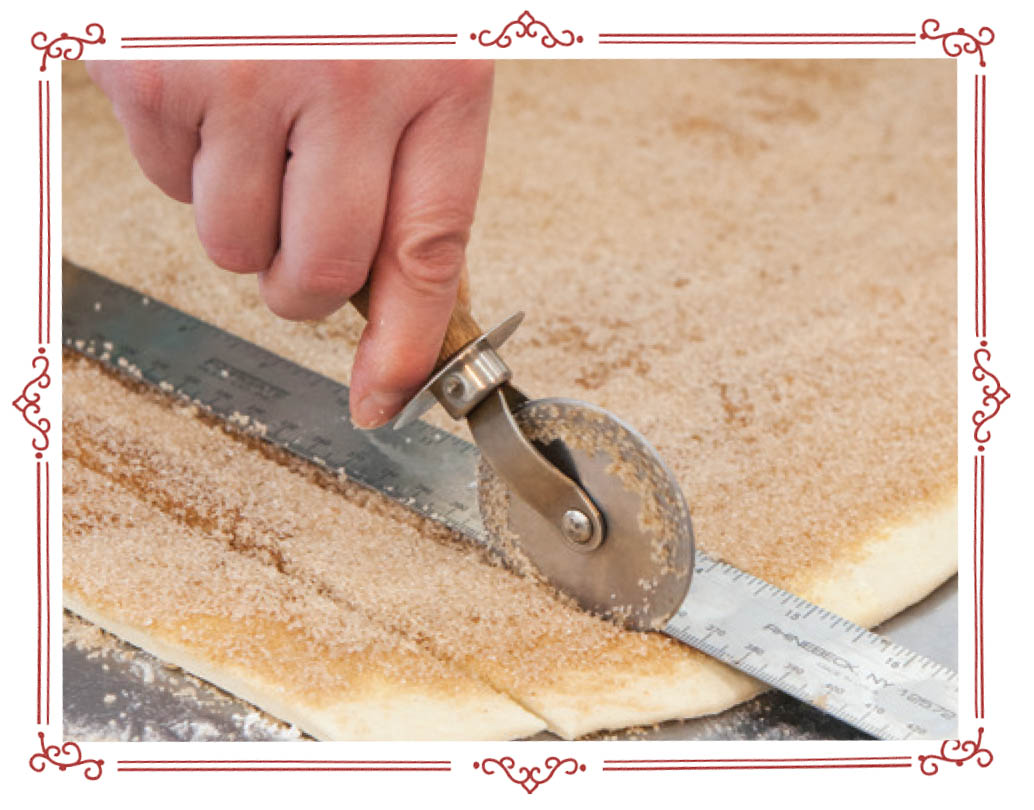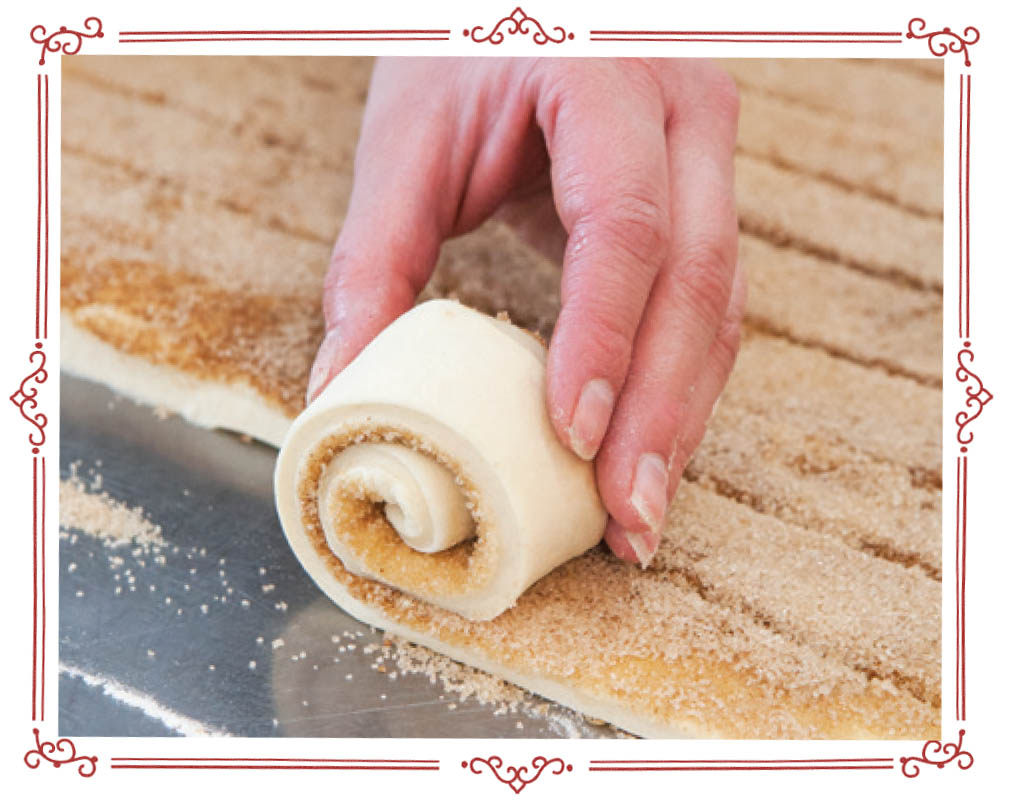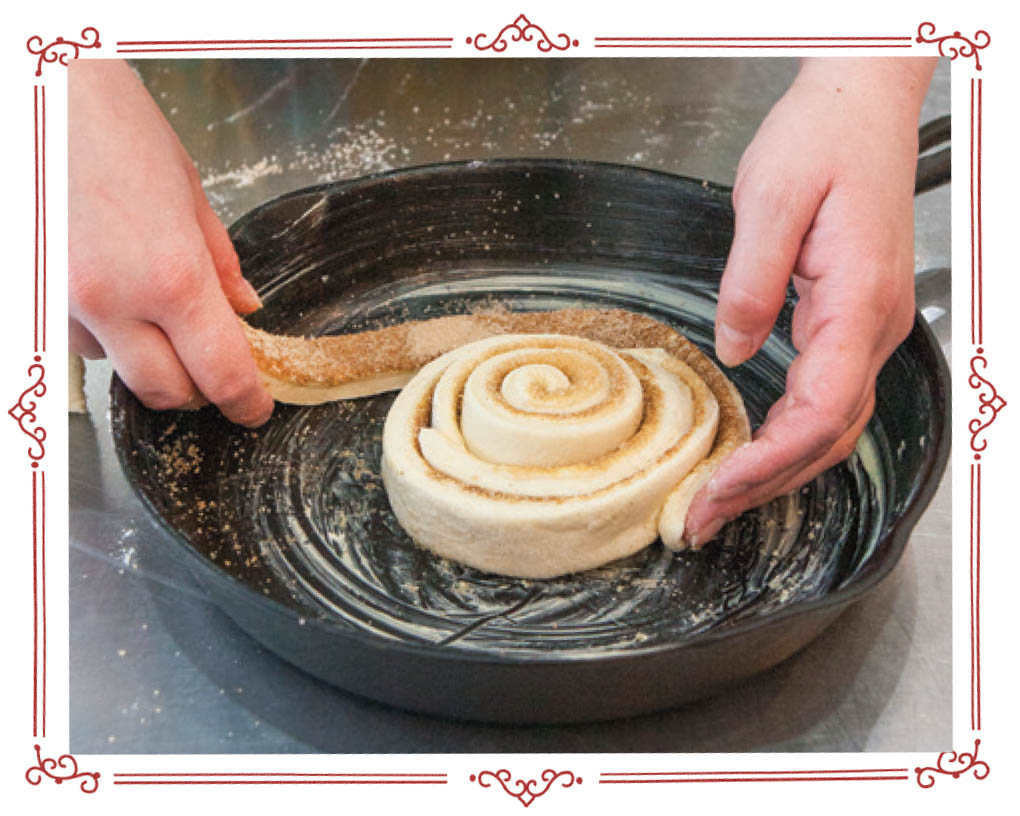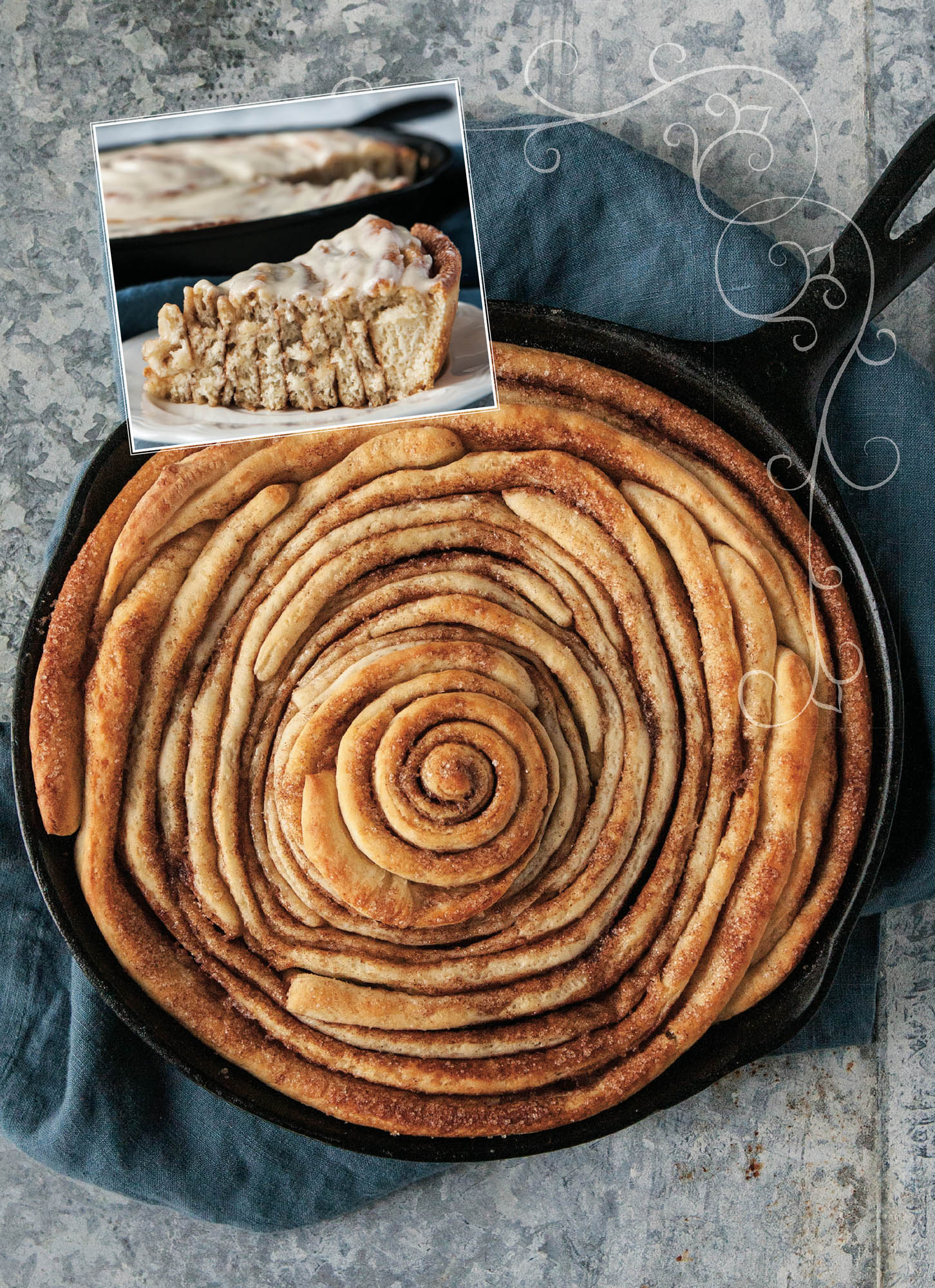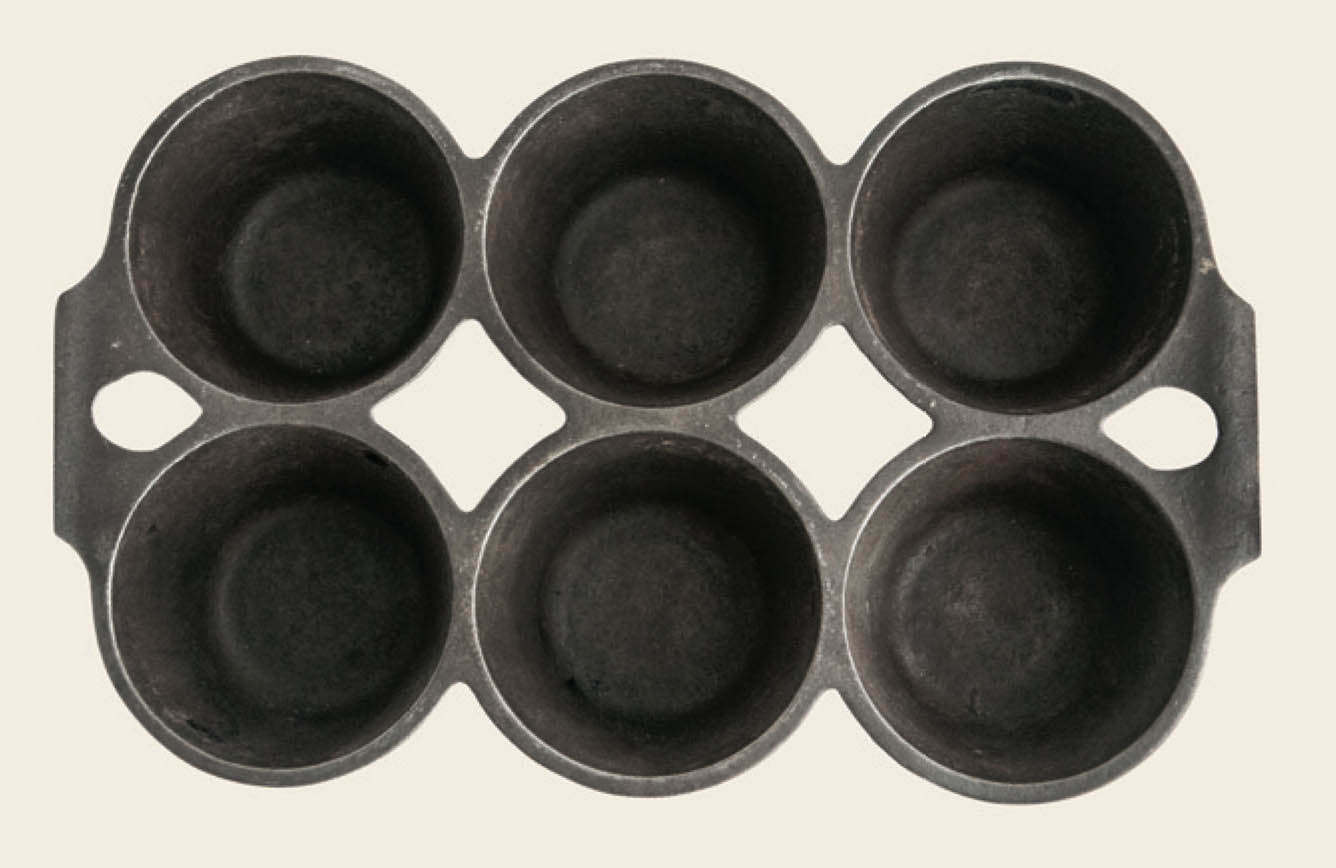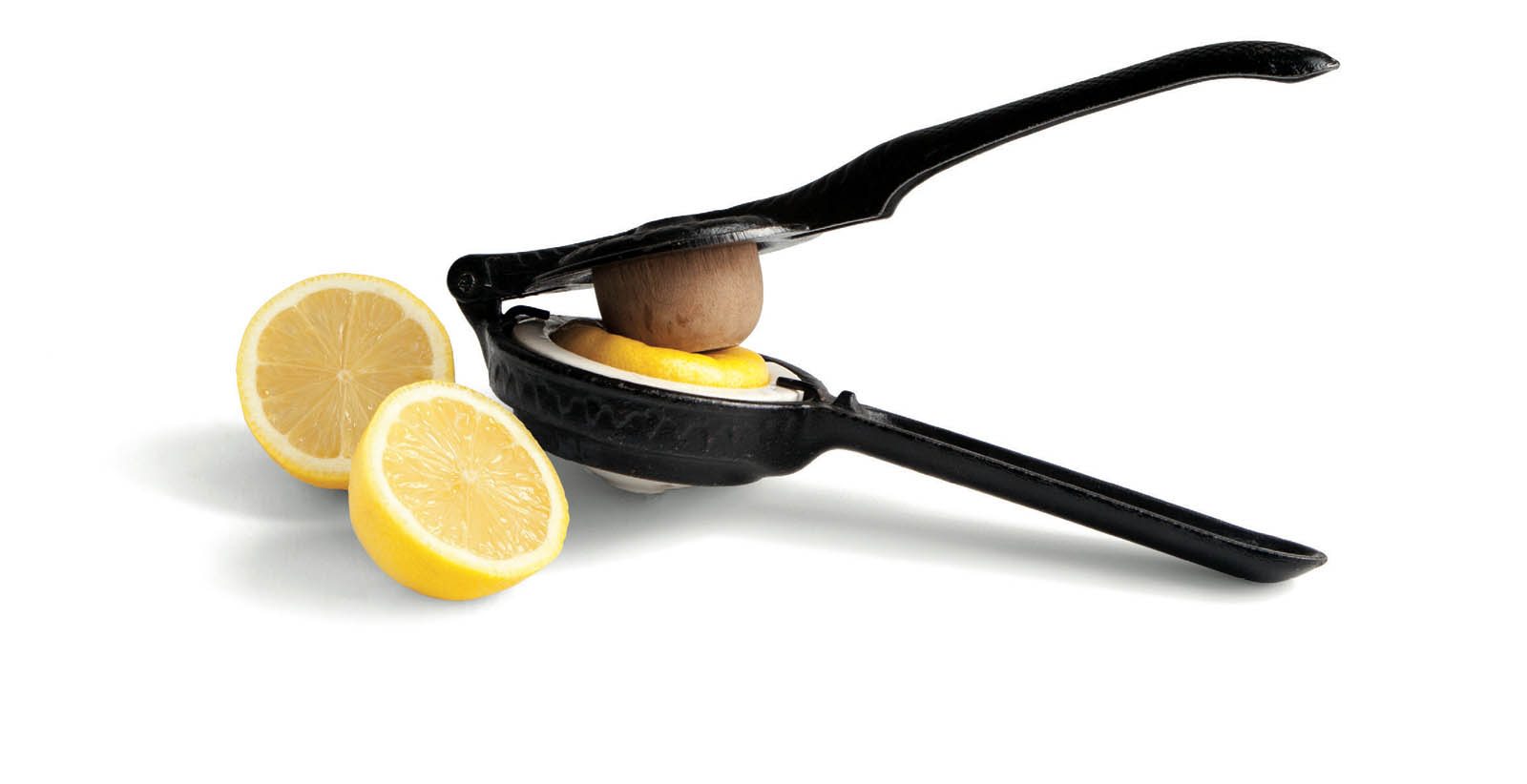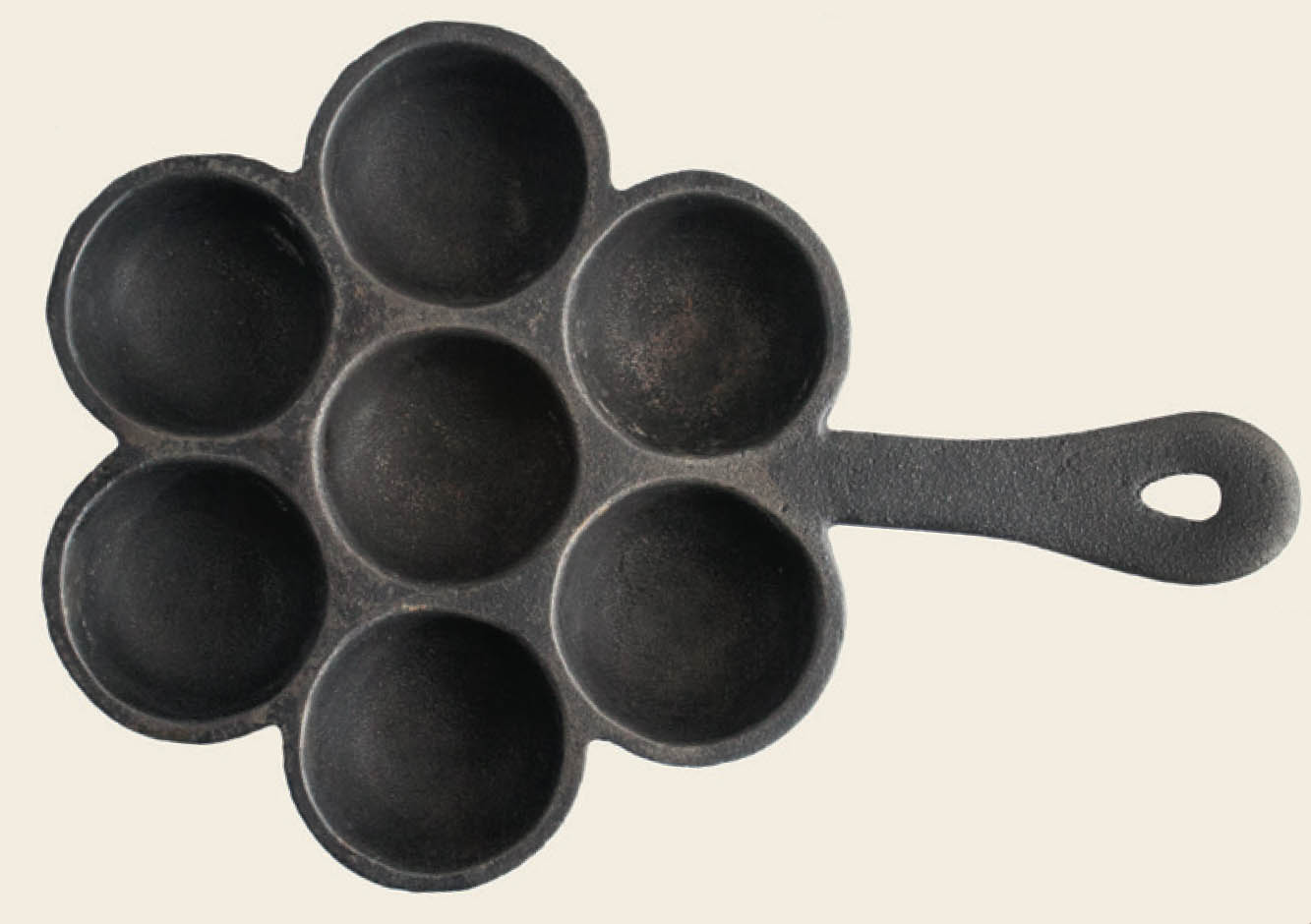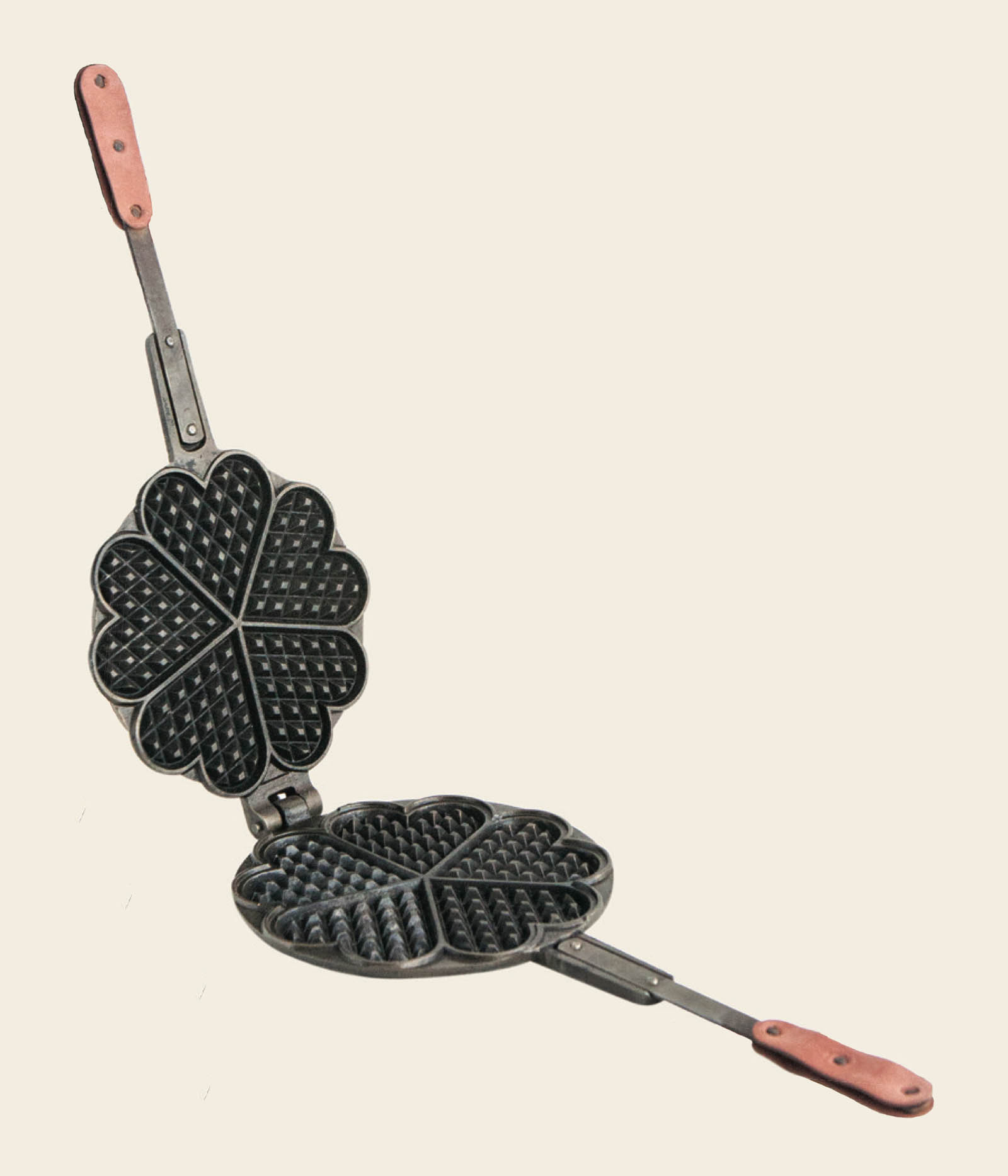Heart-Shaped Eggs in a Blanket
To serve up some love for breakfast, butter a slice of bread on both sides and set aside. Over low heat, preheat a 101/2”-round cast-iron griddle. Once griddle is hot, brush with 1 t melted butter. Place bread on griddle and toast for 1–2 minutes on each side, or until golden brown. Set aside. Lightly butter the inside of a metal, heart-shaped cookie cutter, place on griddle, and crack an egg inside. Once egg is cooked, remove cutter and egg from griddle using a spatula. Remove egg from cookie cutter, and use cookie cutter to cut a heart shape from center of toast. Place fried egg in center of toast; sprinkle with salt and pepper.
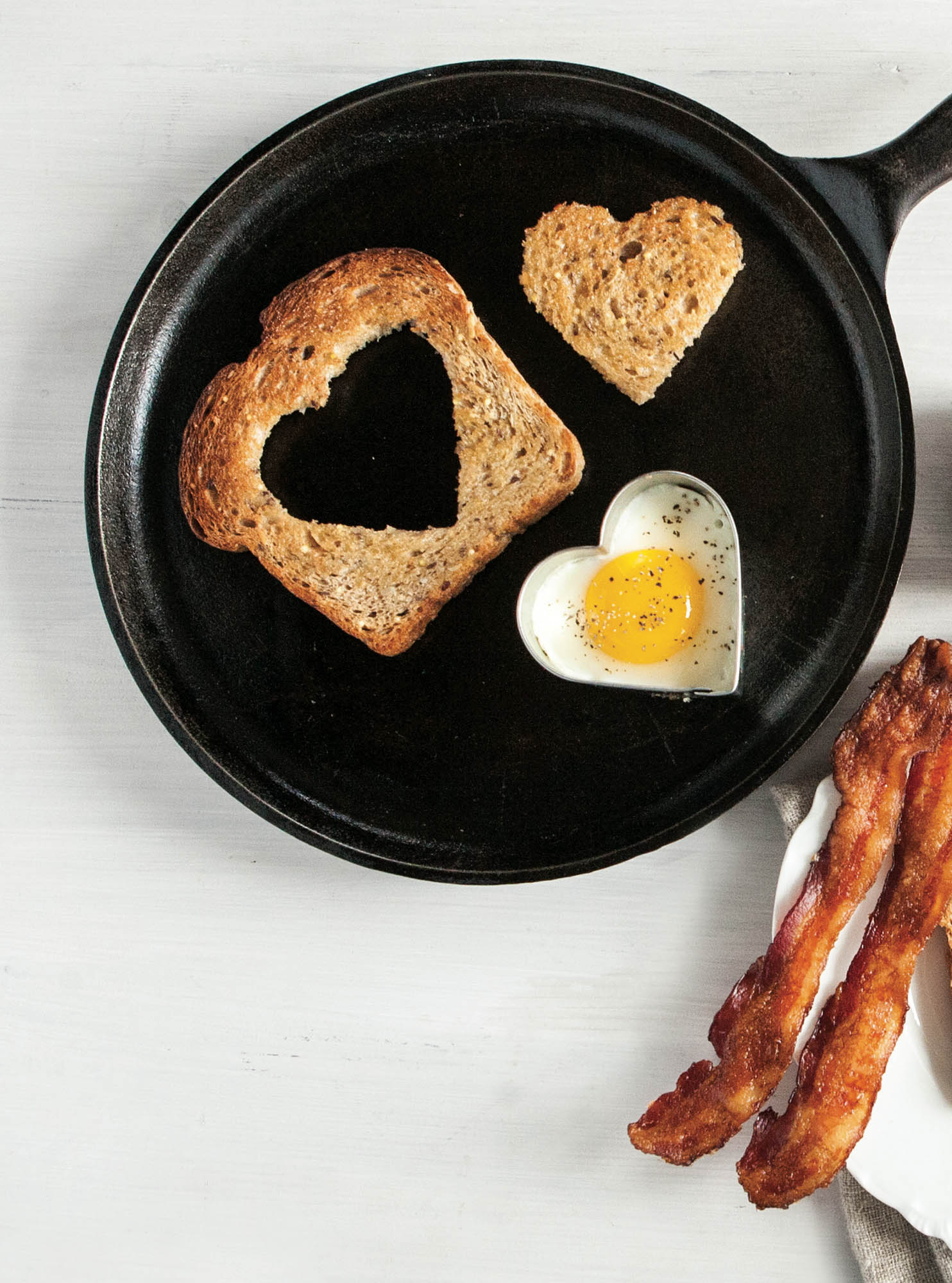
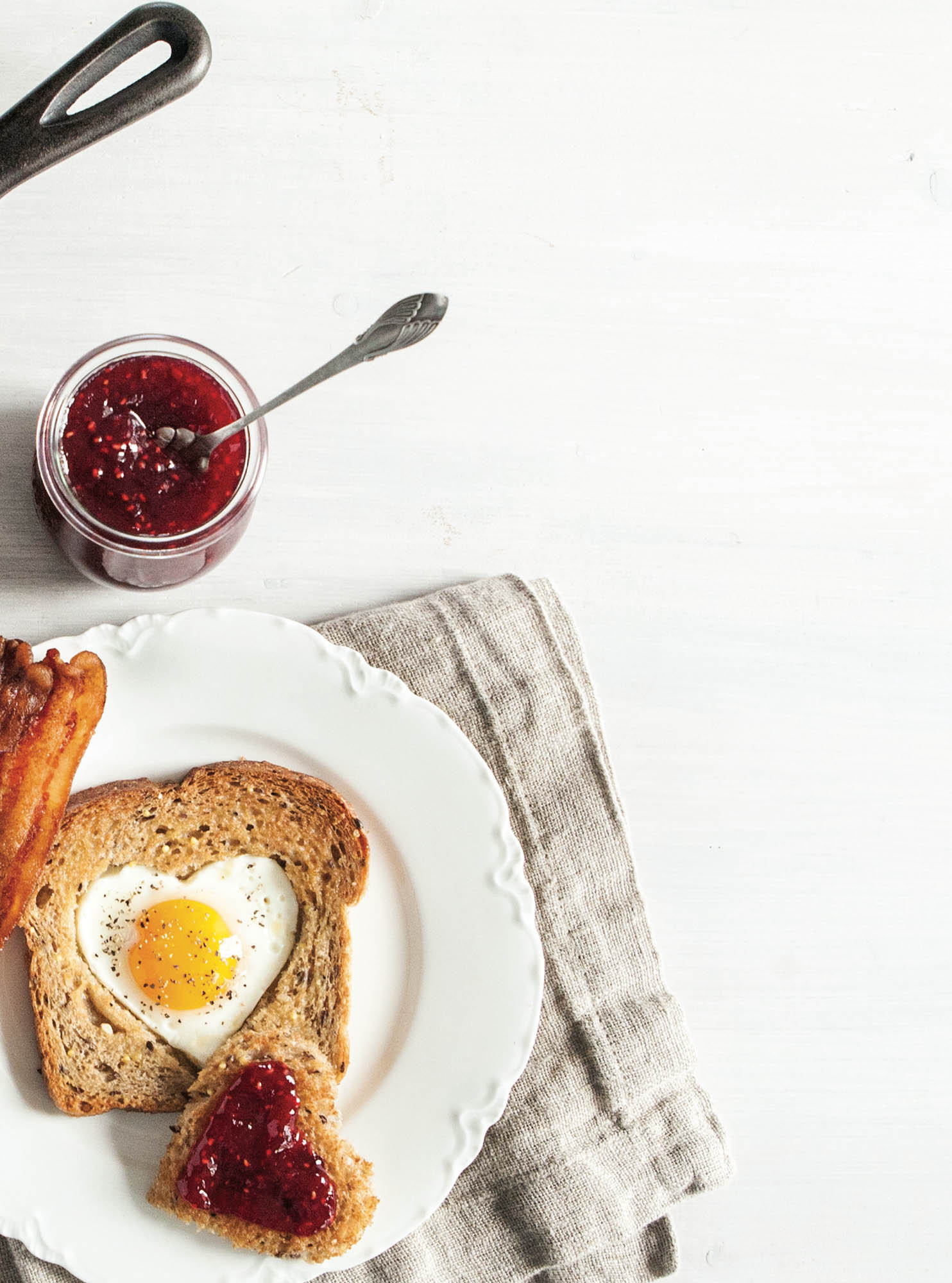
Dutch Baby
I’ve made at least one Dutch baby I’ll never forget. I was working for the Forest Service while living 27 miles from the end of a dirt road in the heart of the Selway-Bitterroot Wilderness. One of the airplane pilots who brought in supplies and food staples surprised me with a dozen fresh eggs, butter, and two cold beers on ice. I drank the first one while stoking my woodstove and warming up my trusty cast-iron skillet. It seems odd to me now, but a Dutch baby and a cold beer was the best lunch I’d eaten in a long while.
MAKES: 4 SERVINGS
3 T butter
4 eggs
1/2 cup flour
1/2 cup milk or coconut milk
2 T honey
1 t almond extract
1/4 t salt
powdered sugar
maple syrup
-
Preheat oven to 425°F.
-
In an 8” cast-iron skillet over medium heat, melt butter and distribute evenly. Remove skillet from heat and set aside.
-
In a medium bowl, beat eggs. Add flour, milk, honey, almond extract, and salt; beat until blended but still somewhat lumpy.
-
Pour batter into skillet and bake until puffy on the edges and golden brown, about 15 minutes.
-
Using a fine-mesh sieve, sprinkle with powdered sugar and drizzle with maple syrup.

Make it gluten free: Replace flour with white rice flour.
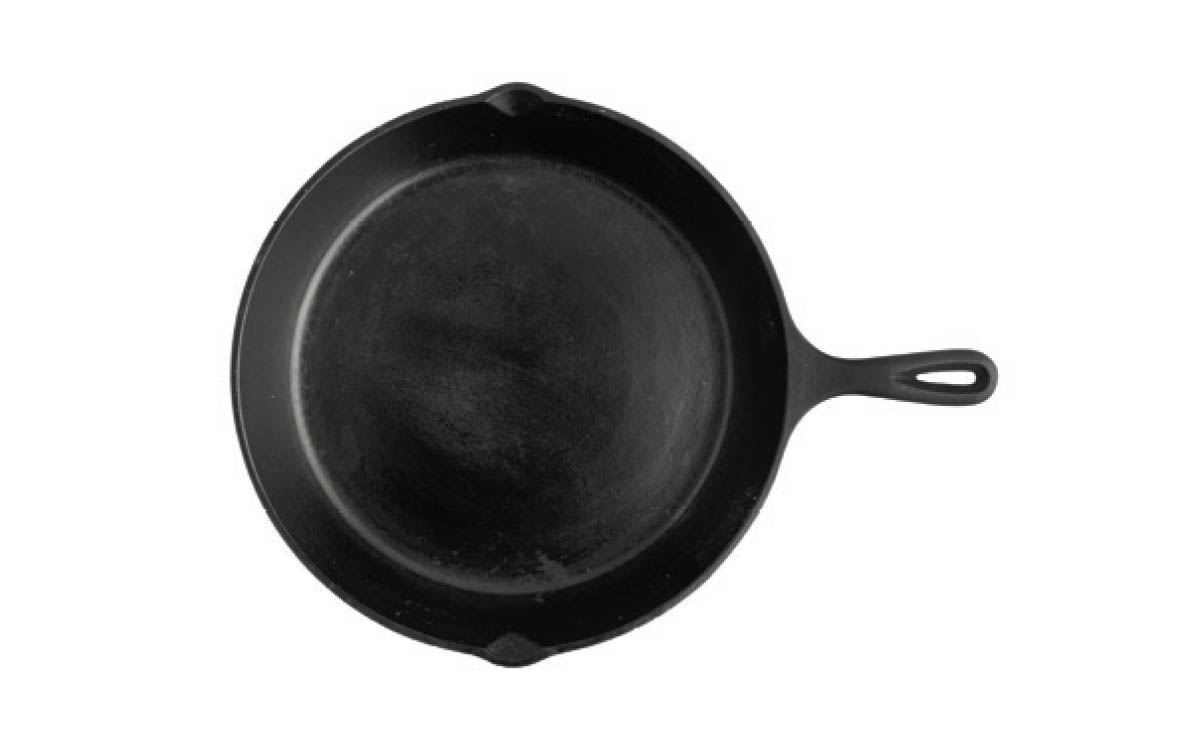
8” Cast-Iron Skillet
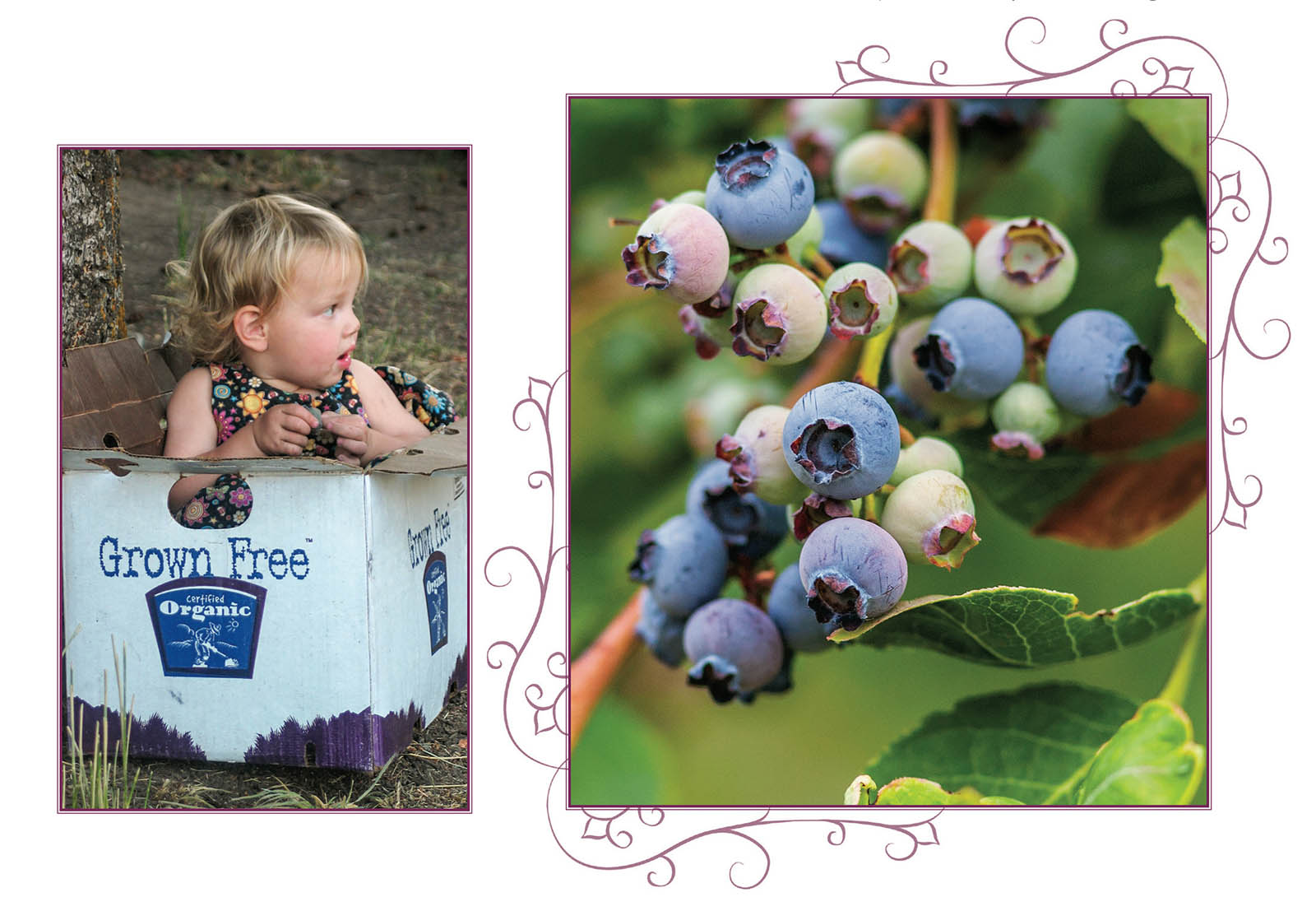
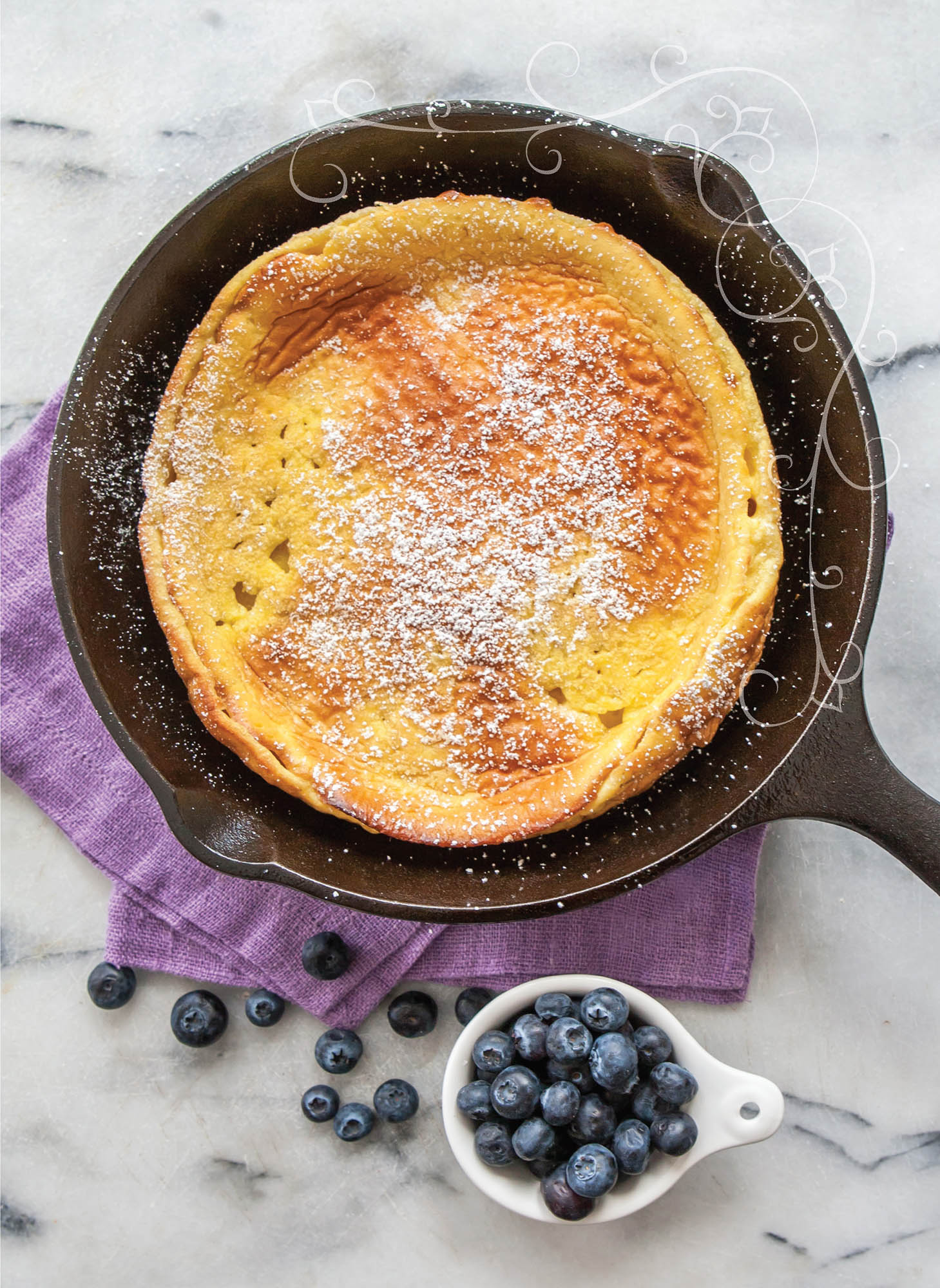
Mini Dutch Babies
Single-serve Dutch babies ensure that everyone gets plenty of yummy crust. I’ve served them to B&B guests with butter, sliced bananas, chopped walnuts, and maple syrup before, but my powdered-sugar/lemon-squeeze topping gets a 5-star review every time.
MAKES: 7 MINI DUTCH BABIES
3 T butter
4 eggs
1/2 cup flour
1/2 cup milk or coconut milk
1/4 t salt
1/8 t ground nutmeg
powdered sugar
fresh lemon juice
-
Preheat oven to 425°F.
-
Evenly divide butter between cups of a cast-iron mini-cake pan. Place pan in hot oven for 2–3 minutes to melt butter. Remove from oven, brush butter over bottom and sides of each cup; set aside.
-
In a medium bowl, beat eggs. Add flour, milk, salt, and nutmeg; beat until blended but still somewhat lumpy.
-
Evenly divide batter between cake-pan cups, place pan on a large baking sheet (to catch any drips), and bake until puffy on the edges and golden brown, about 15 minutes.
-
Using a fine-mesh sieve, sprinkle with powdered sugar and squeeze fresh lemon juice over the top.
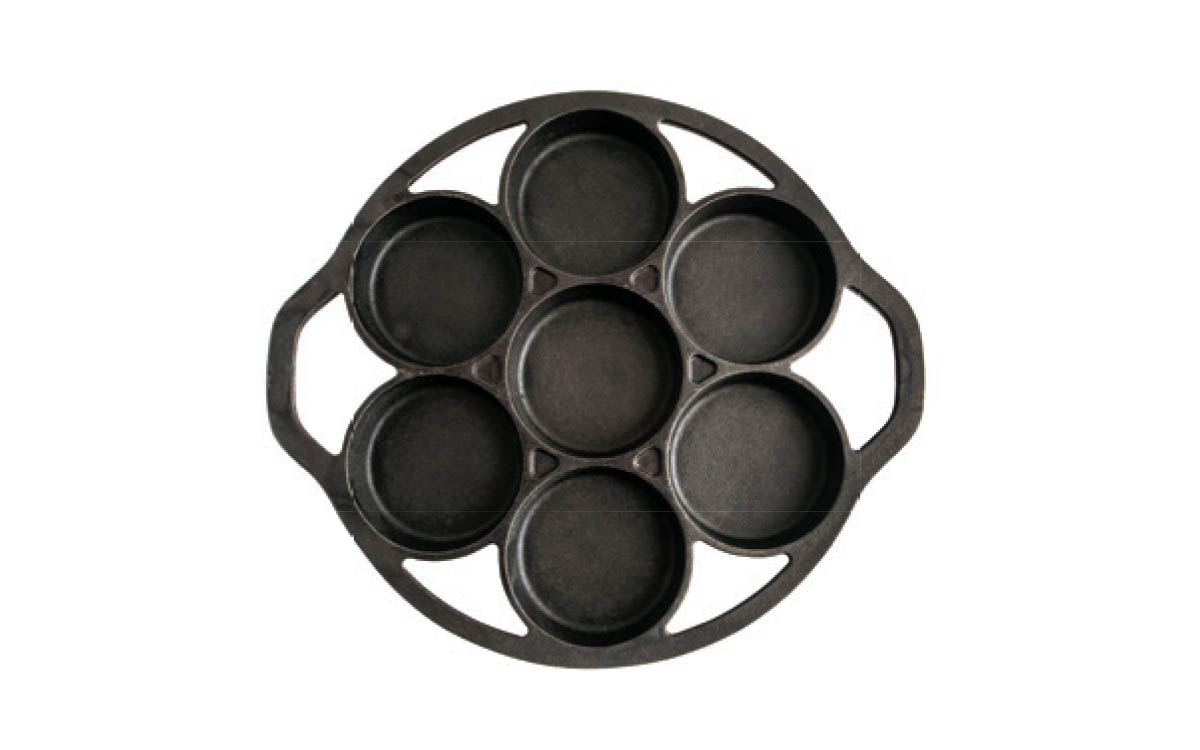
Cast-Iron Mini-Cake Pan

“Lemon tree very pretty, and the lemon flavor is sweet...”
—Brazilian Folk Song

Make it gluten free: Replace flour with white rice flour.
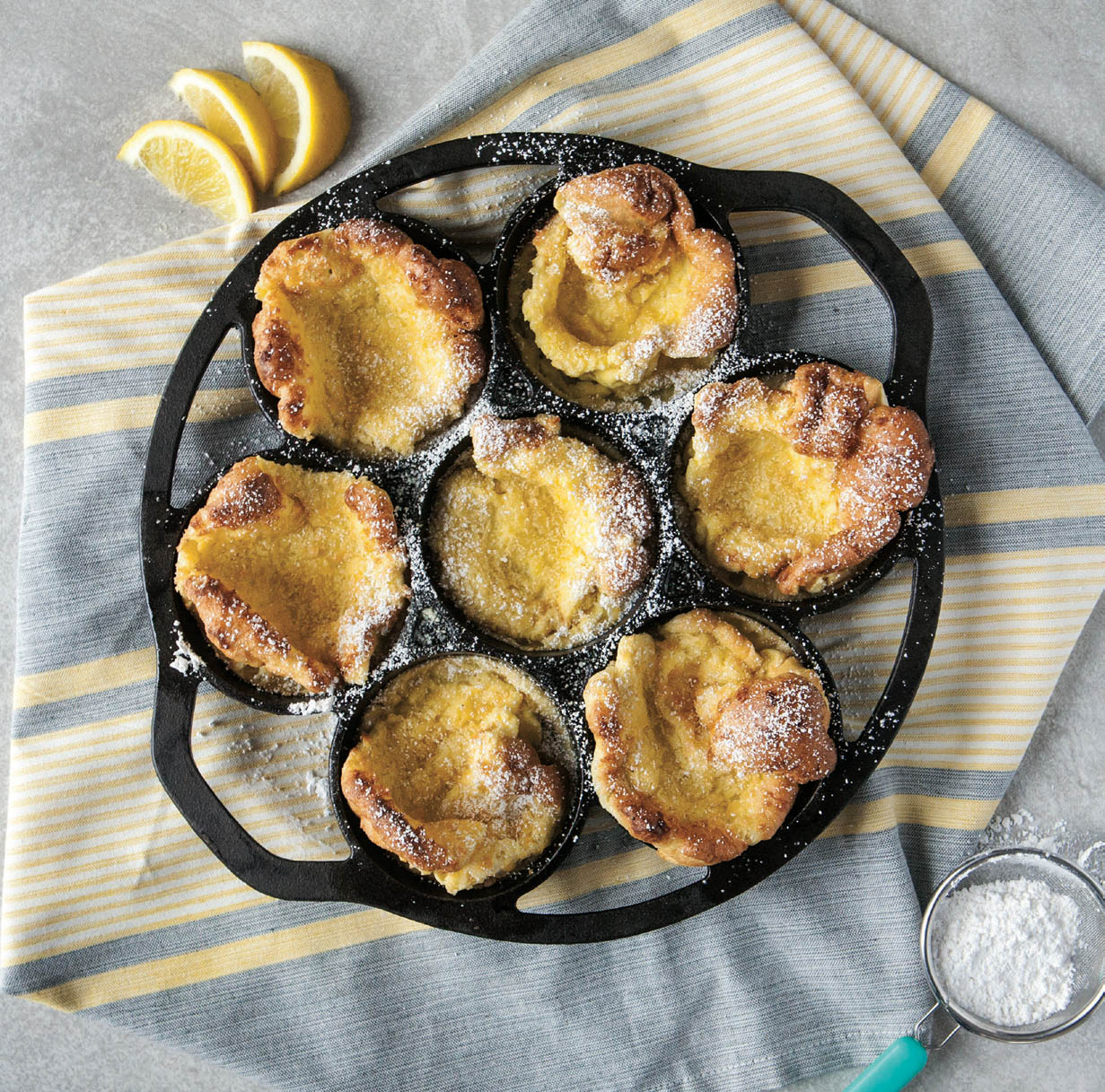
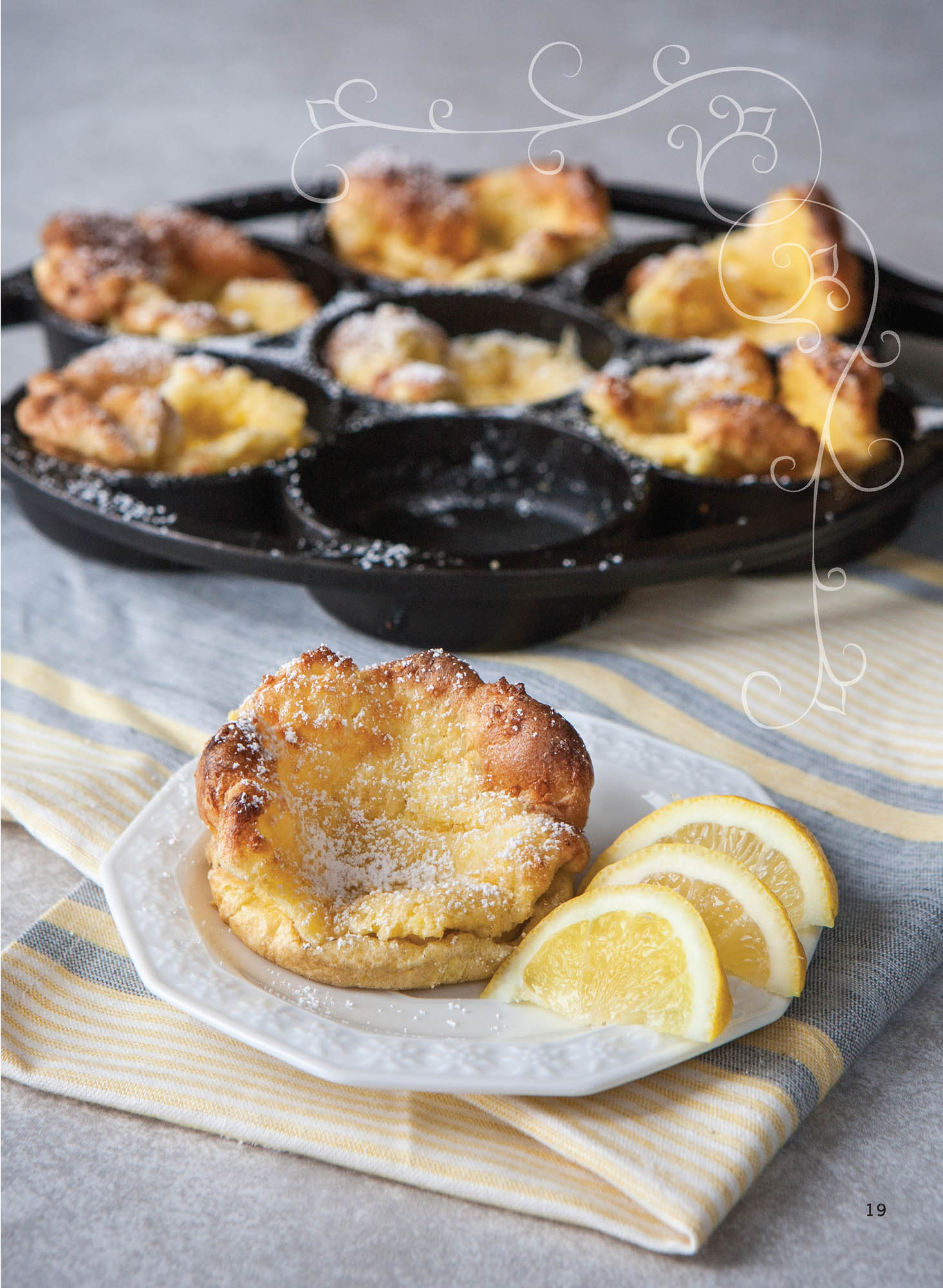
Savory Dutch Baby
I have a soft spot for savory breakfasts, and this Dutch baby with caramelized onion sauce offers a nice twist on a classic cast-iron dish. The savory-yet-sweet flavor of the onion sauce is a perfect match for the puffy, creamy Dutch-baby base, and greens add a peppery crunch.
MAKES: 4 SERVINGS
Caramelized Onion Sauce:
2 T olive oil
1 yellow onion, peeled, quartered, and sliced
1 T flour
2 T white wine
1/2 cup beef broth
1/2 t fresh thyme
1/8 t salt
Dutch Baby:
3 T butter
4 eggs
1/2 cup flour
1/2 cup milk or coconut milk
1/4 t salt
watercress
-
Make sauce: Preheat oil in a medium skillet over medium heat; add onion slices, coating evenly. Cover and cook 15 minutes, stirring occasionally. Remove cover; reduce heat to low. Continue cooking, stirring occasionally, until onions release their sugar and begin to caramelize and turn golden brown.
-
Add flour to onions and mix well. Add wine, cook for 30 seconds, and add beef broth. Continue to cook until sauce has thickened; stir in thyme and salt. Remove skillet from heat and set aside.
-
Make Dutch baby: Preheat oven to 425°F.
-
In an 8” cast-iron skillet over medium heat, melt butter and distribute evenly. Remove skillet from heat and set aside.
-
In a medium bowl, beat eggs. Add flour, milk, and salt. Beat until blended but still somewhat lumpy.
-
Pour batter into skillet and bake until puffy around the edges and golden brown, about 15 minutes.
-
Top with sauce and watercress.

8" Cast-Iron Skillet
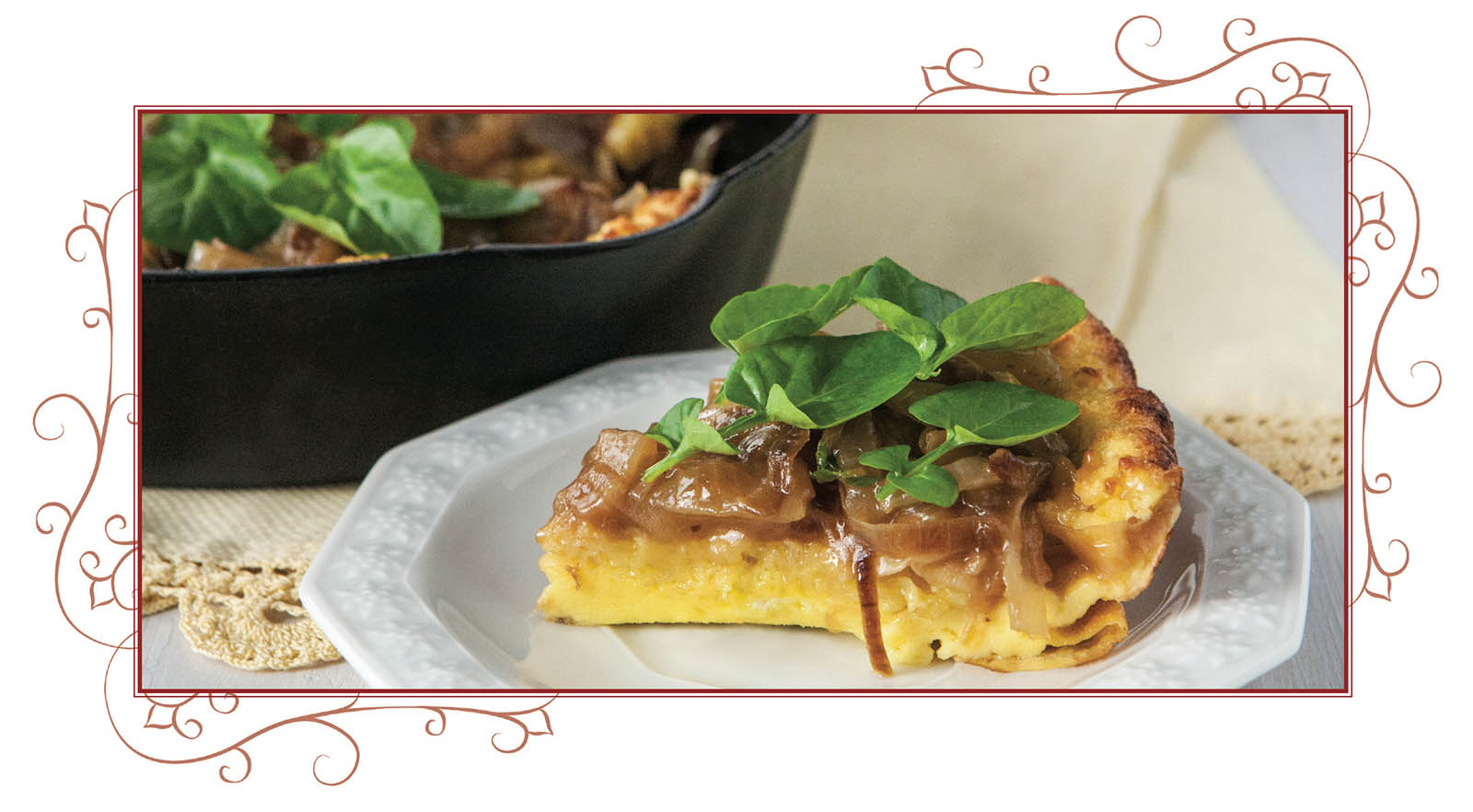
Mushroom Ragout Breakfast
This breakfast dish has it all—creamy polenta and rich, flavorful mushroom ragout, topped with eggs baked right in the sauce. It can also be made the night before, then popped in the oven the next morning for a fuss-free breakfast—just make sure to allow a few extra minutes of cooking time so it comes out of the oven piping hot.
MAKES: 4 SERVINGS
Mushroom Ragout:
2 T butter
1-1/2 lbs crimini mushrooms, quartered (about 6 cups)
3 garlic cloves, peeled and minced (about 1 T)
2 T white wine
1 15-oz can tomato sauce
1 14.5-oz can diced tomatoes
1/2 t fennel seed, lightly crushed
1/4 t salt
1/2 t pepper
1/4 t crushed red pepper
4 eggs
Polenta:
3 cups milk
1 cup dry polenta
2-1/2 ozs goat cheese (about 1/4 cup)
1 oz Parmesan cheese, shredded (about 1/4 cup)
1/4 cup fresh parsley, minced, plus more for serving
1 T fresh lemon juice (about 1 lemon)
1/2 t salt
1/4 t pepper, plus more for serving
-
Preheat oven to 400°F. Generously butter a 10” square cast-iron baking pan.
-
Make ragout: Melt butter in a large skillet over medium heat. Add mushrooms and garlic; cook, stirring frequently, until mushrooms are tender (about 10 minutes).
-
Add wine to skillet, cook for 30 seconds, and add tomato sauce, diced tomatoes (including liquid), fennel, salt, pepper, and crushed red pepper. Reduce heat to low and continue to simmer, stirring occasionally, for 20 minutes.
-
While ragout is cooking, make polenta: In a medium saucepan over medium heat, bring milk to a simmer. Whisk in polenta and continue to simmer, whisking frequently, until thickened. Add cheeses, parsley, lemon juice, salt, and pepper; mix well.
-
Add polenta to prepared baking pan and smooth out top. Top with mushroom ragout.
-
Make four divots in ragout, each large enough for 1 egg. Crack an egg in each divot, loosely cover baking pan with foil, and bake for 30 minutes. Remove foil and bake an additional 10–12 minutes, or until eggs are set. Just before serving, garnish with parsley and pepper.
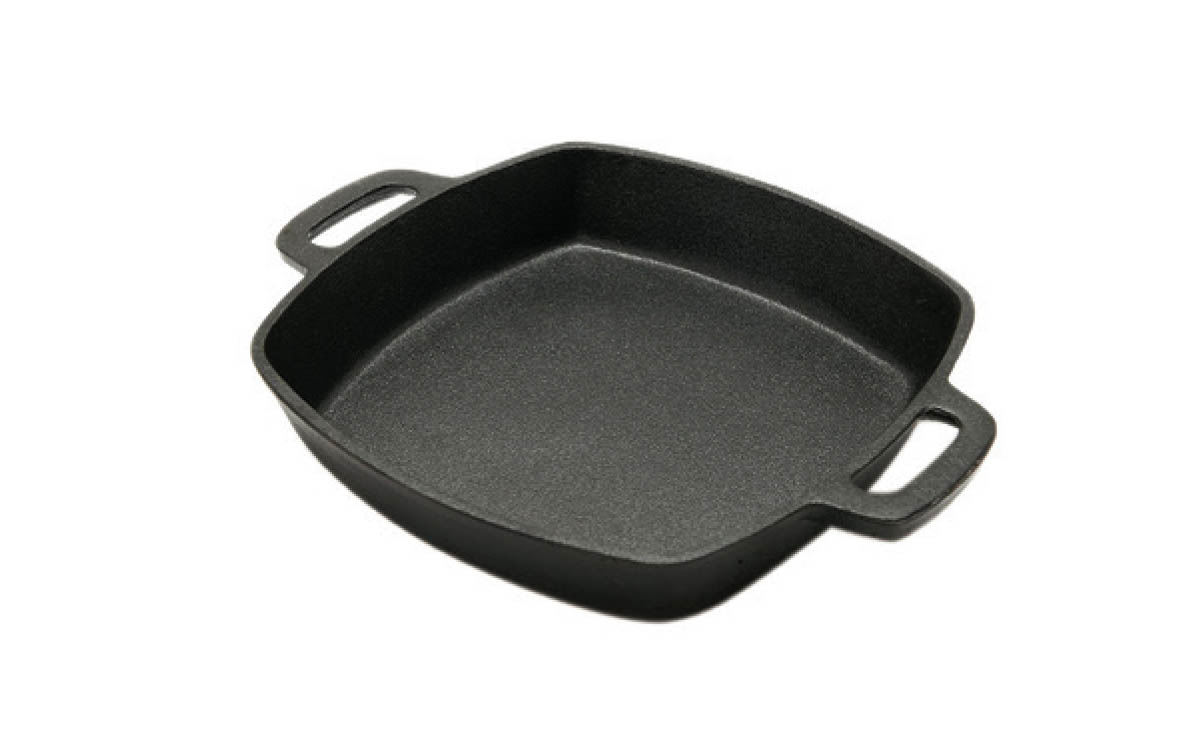
10” Square Cast-Iron Baking Pan
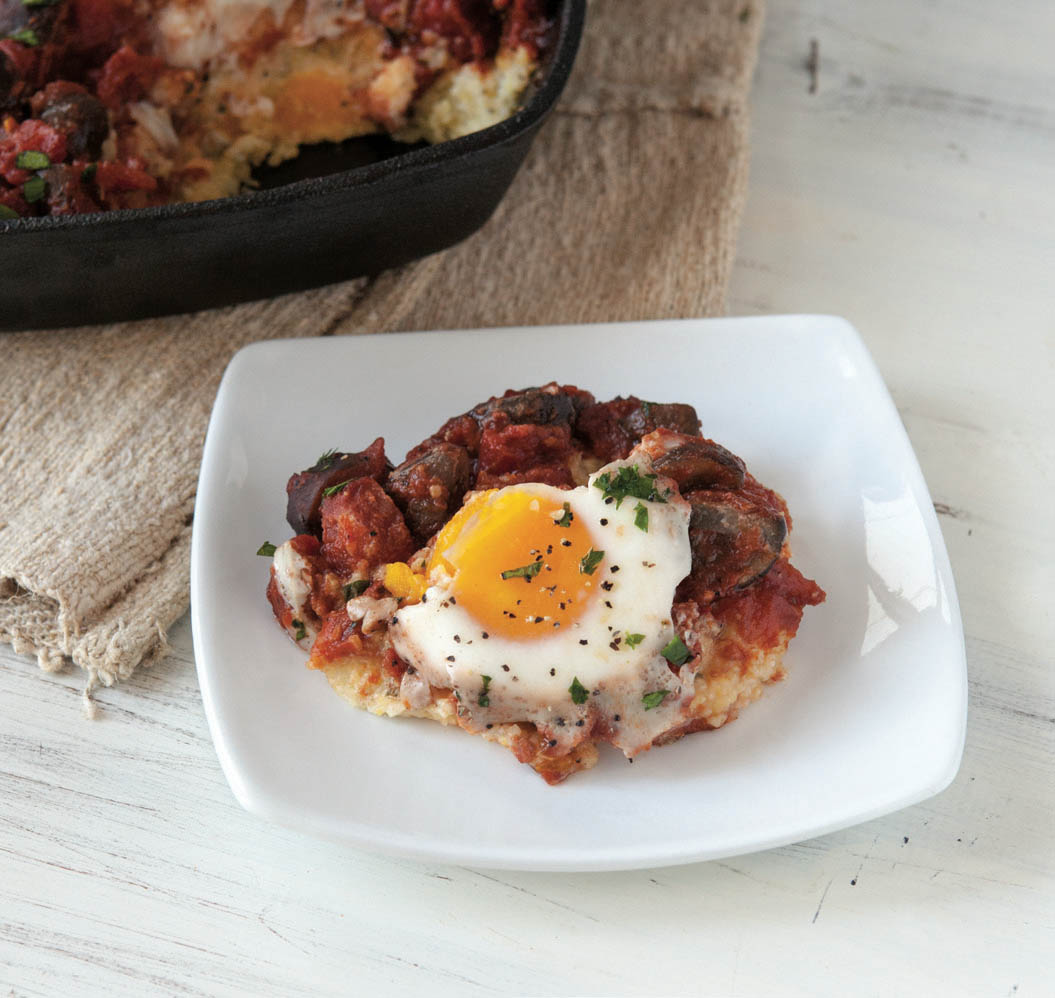
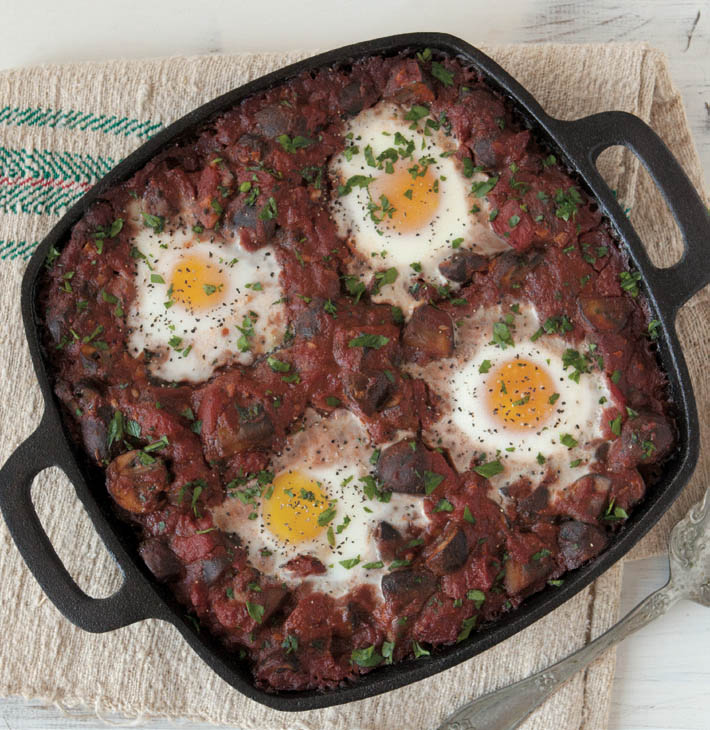
Ham, Mushroom & Asparagus Mini Quiches
I love the simplicity of single-serve dishes—especially if I’m feeding a crowd. In addition to simplifying the serving process, these mini quiches also bake up in less time than a traditional quiche, which leaves more time for enjoying company over coffee.
MAKES: 6 MINI QUICHES
Crust:
1-1/3 cups flour, plus more for dusting
1/4 t salt
9 T cold butter
3 T cold water
Filling:
2 t butter
3 crimini mushrooms, halved and sliced (about 3 T)
3 asparagus spears, sliced (about 1/4 cup)
1-1/2 ozs cooked ham, finely diced (about 1/4 cup)
3 eggs
2 t milk
1/8 t salt
1/8 t pepper
1 T shredded cheddar cheese
-
Make crust: Combine flour and salt in a medium bowl or food processor. Cut in butter until mixture resembles coarse crumbs. Sprinkle in water and blend just until dough forms. Shape into a disc, wrap in plastic wrap, and refrigerate for 30 minutes.
-
Preheat oven to 400°F. Lightly butter a 6-cavity cast-iron muffin pan.
-
On a lightly floured surface, roll the dough to 1/8 “ thickness. Cut dough into 6” circles and line prepared muffin pan cavities with dough. Shape edges, if desired. Bake for 12–15 minutes, or until outer edges turn golden brown.
-
Make filling: In a medium skillet, melt butter; cook mushrooms and asparagus for about 3 minutes. Remove from heat and stir in ham. Divide filling evenly between shells.
-
In a medium bowl, whisk eggs, milk, salt, and pepper together. Divide egg mixture evenly between shells. Top each quiche with cheese and bake at 400°F for 18–20 minutes, or until eggs are set.
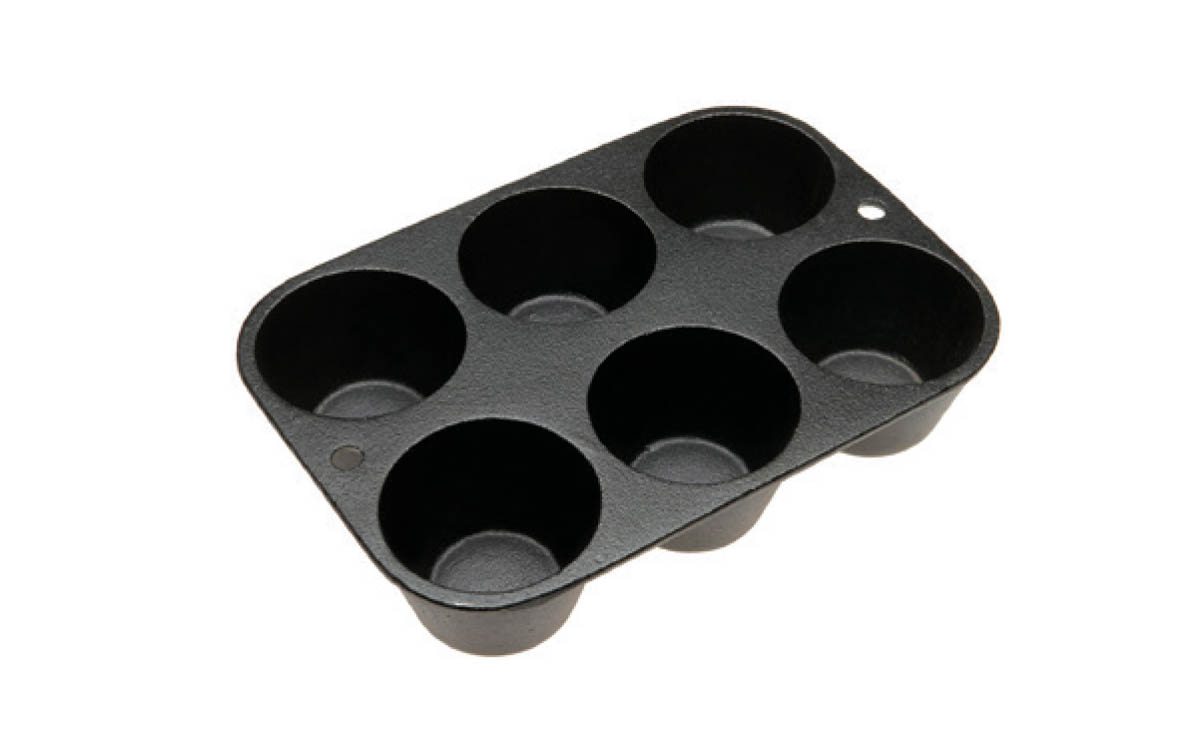
6-Cavity Cast-Iron Muffin Pan
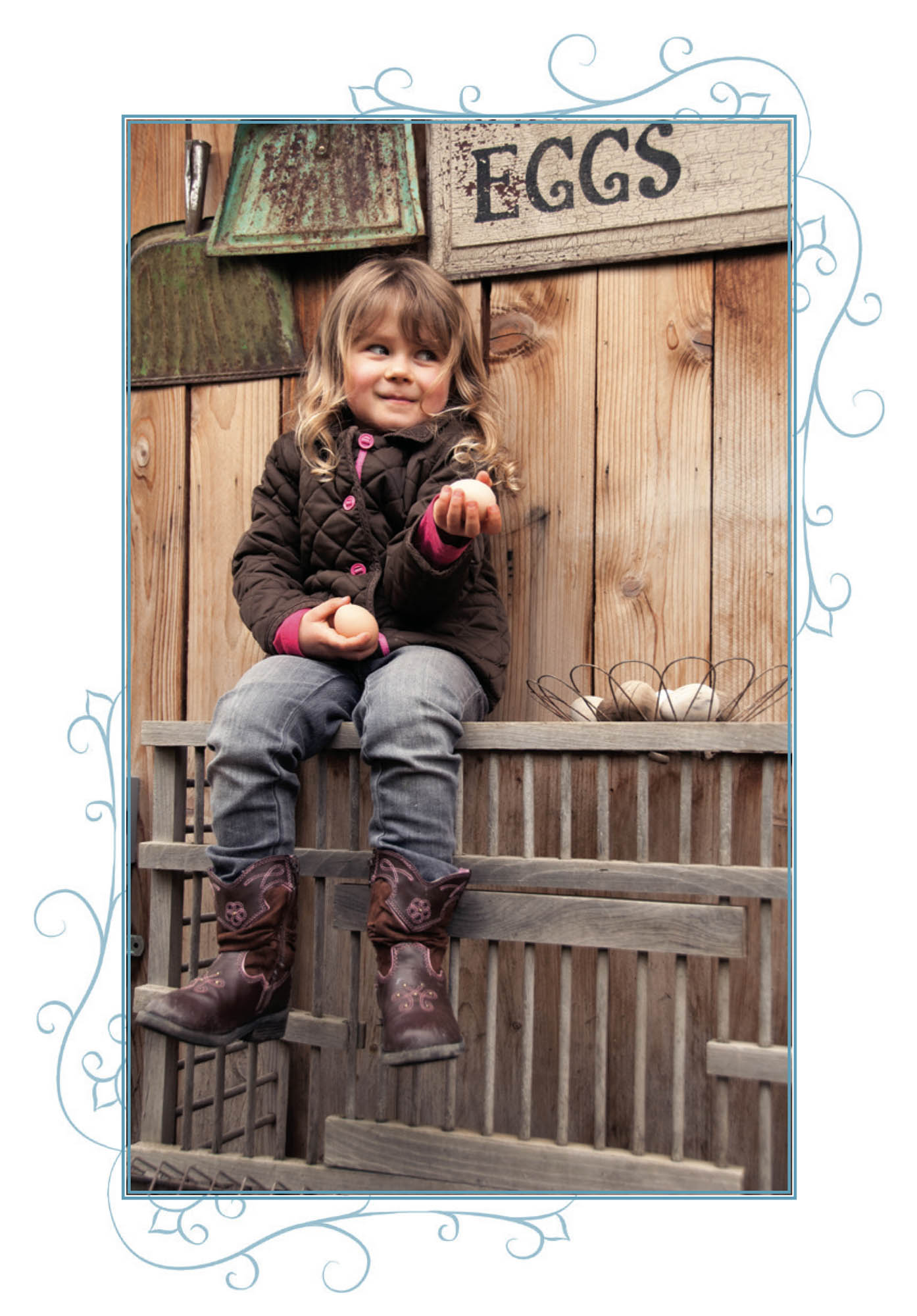
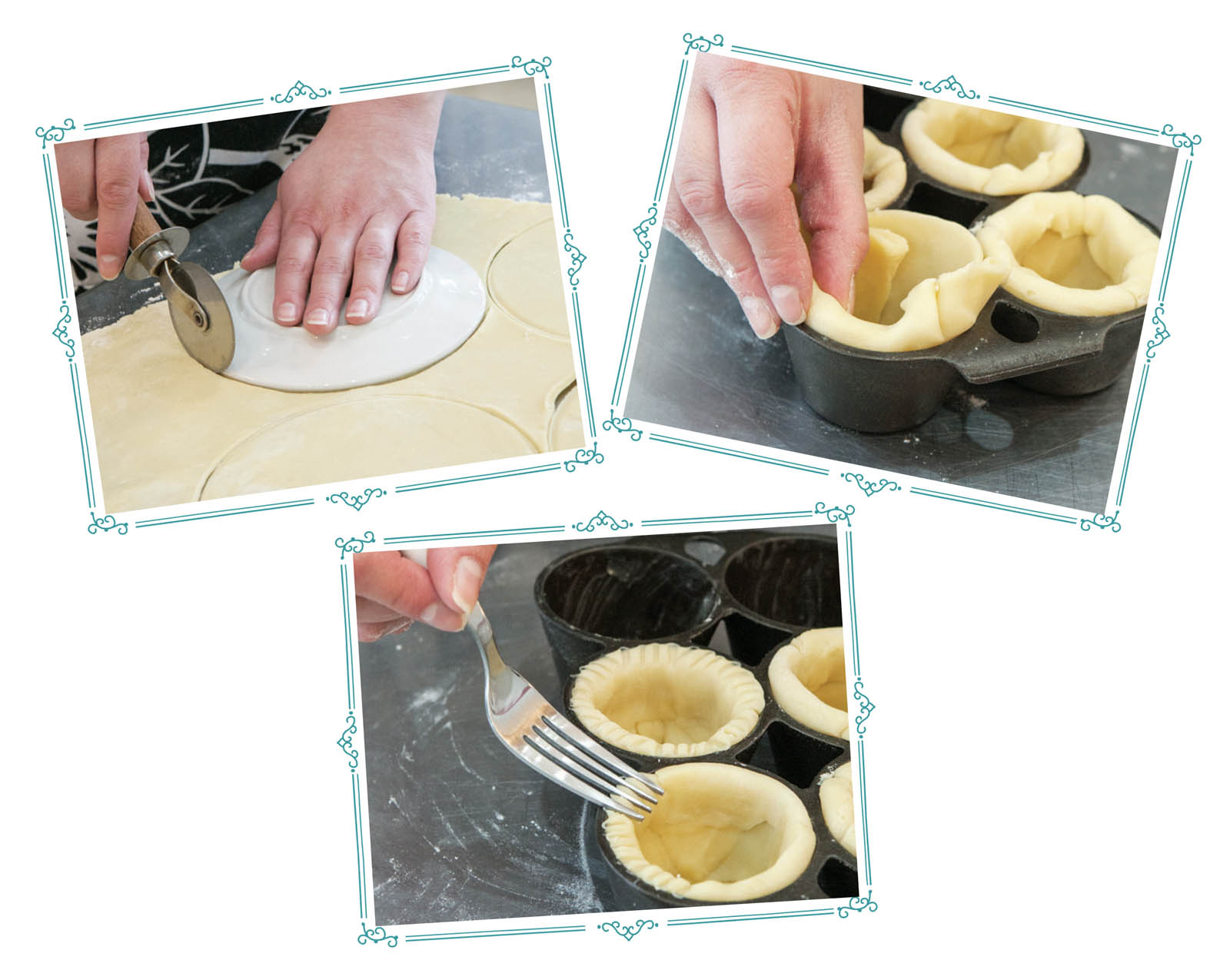

Pesto Muffins
These muffins fill the house with an intoxicatingly delicious pesto aroma. Once they’re out of the oven and barely cool enough to eat, they often disappear before my eyes—they’re that good.
MAKES: 6 MUFFINS
2-1/2 ozs extra-sharp Cheddar cheese, shredded (about 2/3 cup)
3 ozs feta cheese, crumbled (about 1/3 cup)
1/4 cup walnuts, coarsely chopped
1/3 cup pesto
1/2 cup buttermilk
1 egg
2 T butter, melted
1/4 t fresh lemon juice
1 cup flour
1-1/4 t baking powder
1/4 t salt
-
Preheat oven to 375°F. Line a 6-cavity cast-iron muffin pan with paper liners.
-
In a small bowl, combine cheeses, walnuts, and pesto.
-
In a small bowl, whisk together buttermilk, egg, melted butter, and lemon juice.
-
In a medium bowl, combine flour, baking powder, and salt. Add buttermilk mixture to flour mixture and stir just until blended.
-
Using as few strokes as possible, fold in cheese mixture.
-
Spoon into paper liners until full and well-rounded. (Mixture won’t rise much during baking, so mound ’em up!) Bake muffins for 22–25 minutes, or until a toothpick inserted into the center of a muffin comes out clean.

6-Cavity Cast-Iron Muffin Pan
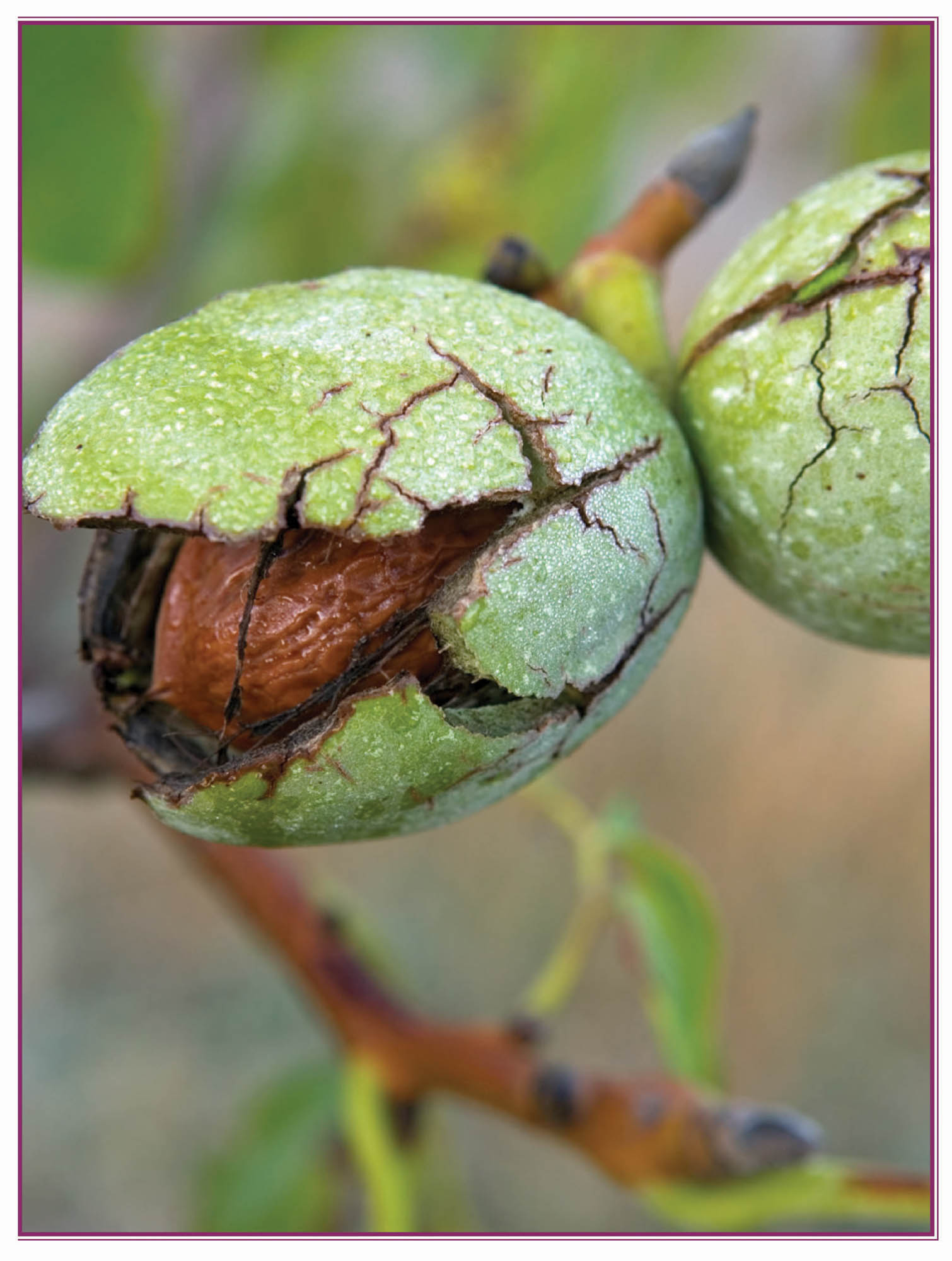
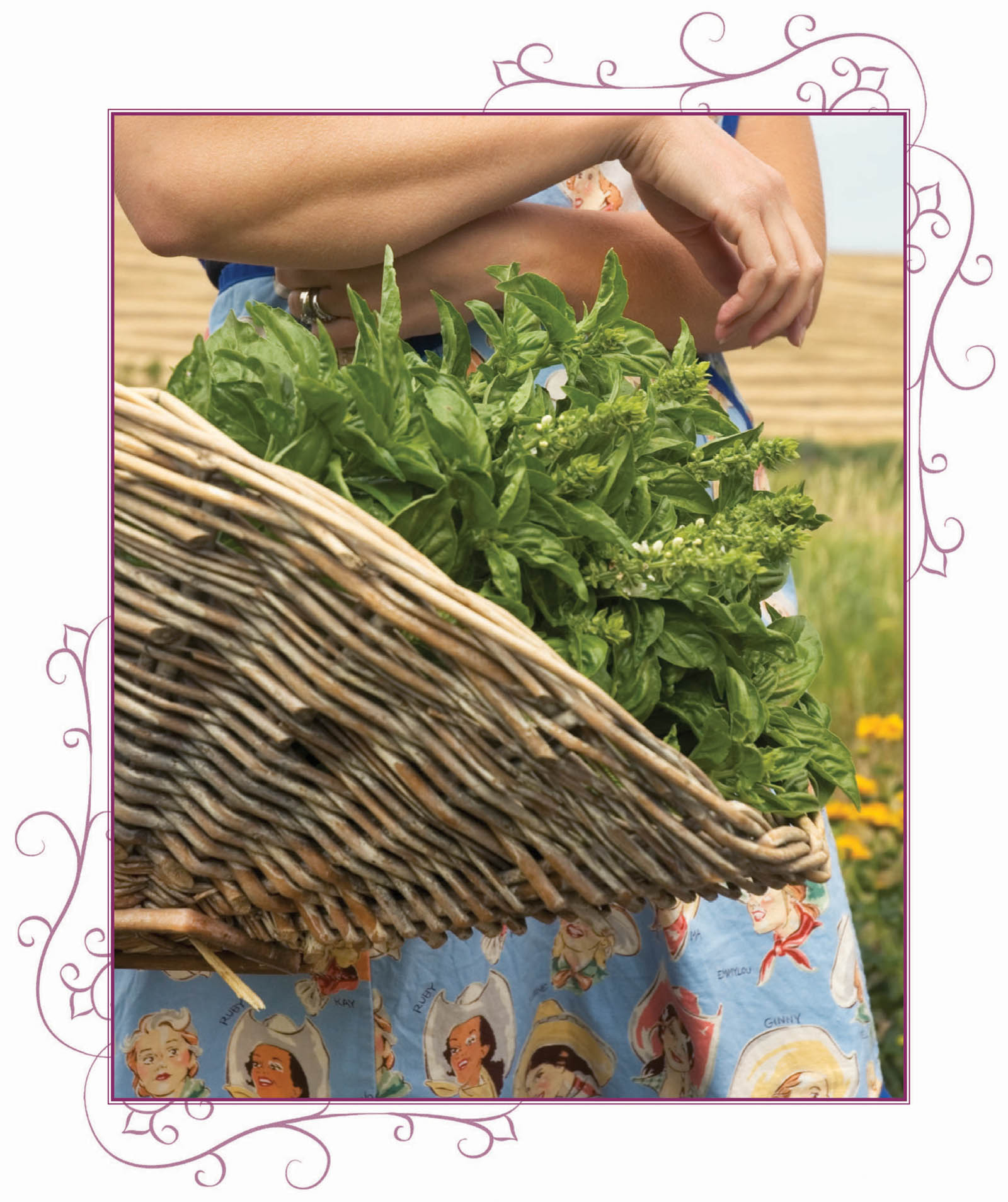
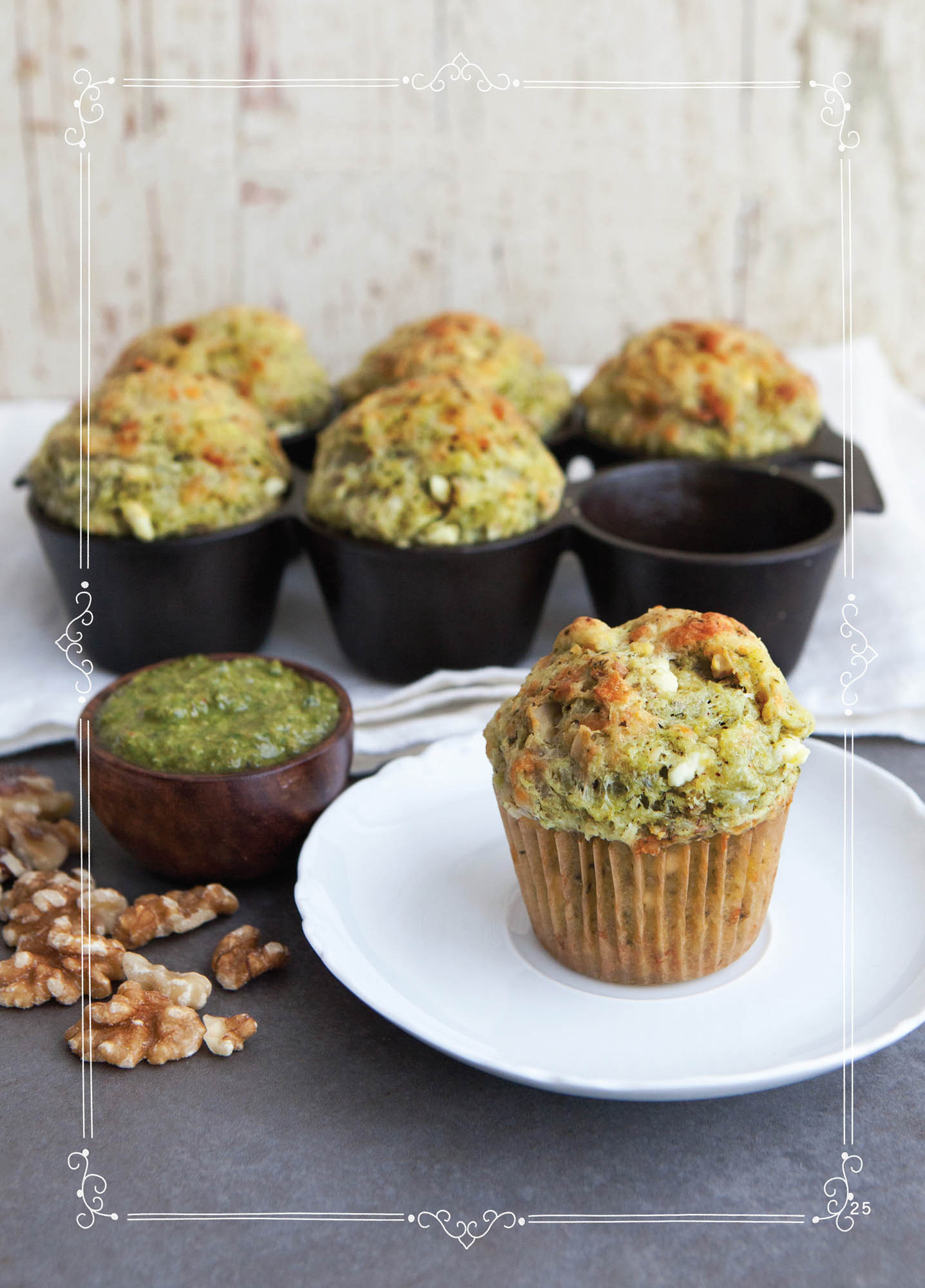
“Pounding fragrant things—particularly garlic, basil, and parsley—is a tremendous antidote to depression ... Pounding these things produces an alteration in one’s being—from sighing with fatigue to inhaling with pleasure.”
—Patience Gray, cookery author
Ham Muffins
If you’re craving something a little salty with a tangy edge, these muffins are for you. I love the pairing of kalamata olives and ham, and find it hard to resist nibbling on an extra olive or two while mixing up the batter.
MAKES: 6 MUFFINS
Optional: Spice things up a bit by adding 2 T finely chopped fresh poblano pepper and 1/4 t red pepper flakes to the olive mixture.
1/3 cup kalamata olives, chopped (reserve 3 T juice)
3 ozs cooked ham, cut into 1/4” cubes (about 1/2 cup)
2 ozs extra-sharp Cheddar cheese, shredded (about 1/2 cup)
1 t dried rosemary, crushed
1/4 t pepper
1/3 cup buttermilk
1 egg
2 T butter, melted
1/4 t fresh lemon juice
1 cup flour
1-1/4 t baking powder
1/4 t salt
-
Preheat oven to 375°F. Line a 6-cavity cast-iron muffin pan with paper liners.
-
In a small bowl, combine olives, ham, cheese, rosemary, and pepper.
-
In a small bowl, whisk together buttermilk, egg, melted butter, lemon juice, and reserved olive juice.
-
In a medium bowl, combine flour, baking powder, and salt. Add buttermilk mixture to flour mixture and stir just until blended.
-
Using as few strokes as possible, fold in olive mixture.
-
Spoon into paper liners until full and well rounded. (Mixture won’t rise much during baking, so mound ’em up!) Bake muffins for 22–25 minutes, or until a toothpick inserted into the center of a muffin comes out clean.

6-Cavity Cast-Iron Muffin Pan
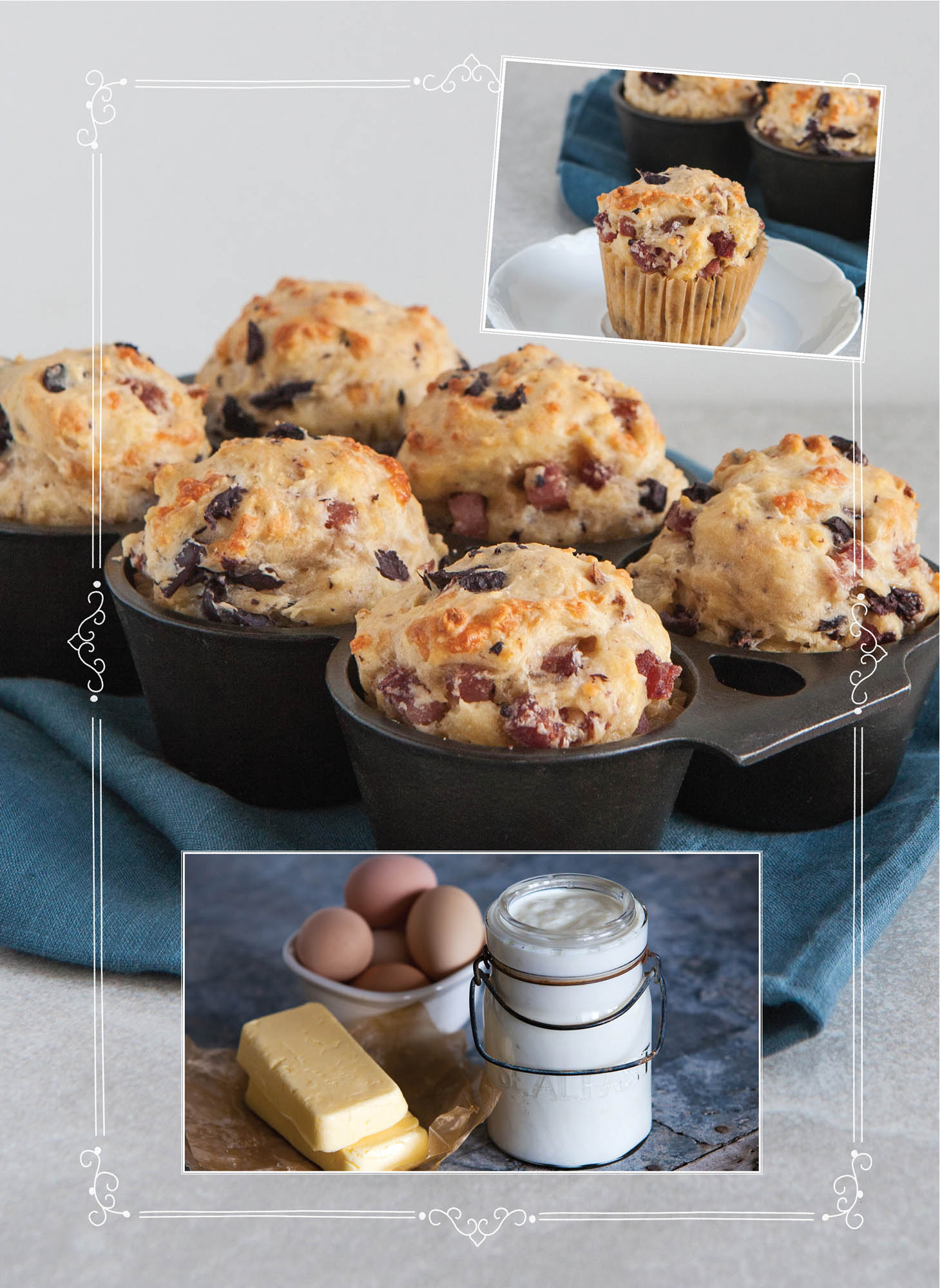
Bacon & Egg Cups
These cups embody everything I love about breakfast—crisp bacon, perfectly seasoned hash browns, cheese, and fluffy scrambled eggs, all dressed up with a spoonful of fresh salsa.
MAKES: 6 EGG CUPS
8 ozs frozen hash browns (about 2 cups), thawed
4 ozs sharp Cheddar cheese, shredded (about 1 cup)
3 slices bacon (about 3 ozs), cooked and diced
2 T flour
2 T minced chives
1/4 t salt
1/8 t pepper
6 eggs, divided
salsa (optional)
sour cream (optional)
-
Preheat oven to 400°F. Generously butter a 6-cavity cast-iron muffin pan.
-
In a medium bowl, combine hash browns, cheese, bacon, flour, chives, salt, and pepper; stir to combine.
-
In a small bowl, gently whisk 1 egg and stir into the hashbrown mixture. Evenly divide mixture between prepared muffin cups. Firmly press mixture into the bottom and up the sides of each muffin cavity.
-
Bake for 30–35 minutes or until hash browns begin to turn golden brown. Let cool for 10 minutes.
-
While hash-brown cups are cooling, whisk together remaining eggs. Generously butter a medium skillet and scramble eggs over medium-low heat.
-
Carefully run a dull knife around the inside of each muffin cup to remove from pan. Evenly divide scrambled eggs between hash-brown cups. If desired, serve with salsa and sour cream.

6-Cavity Cast-Iron Muffin Pan

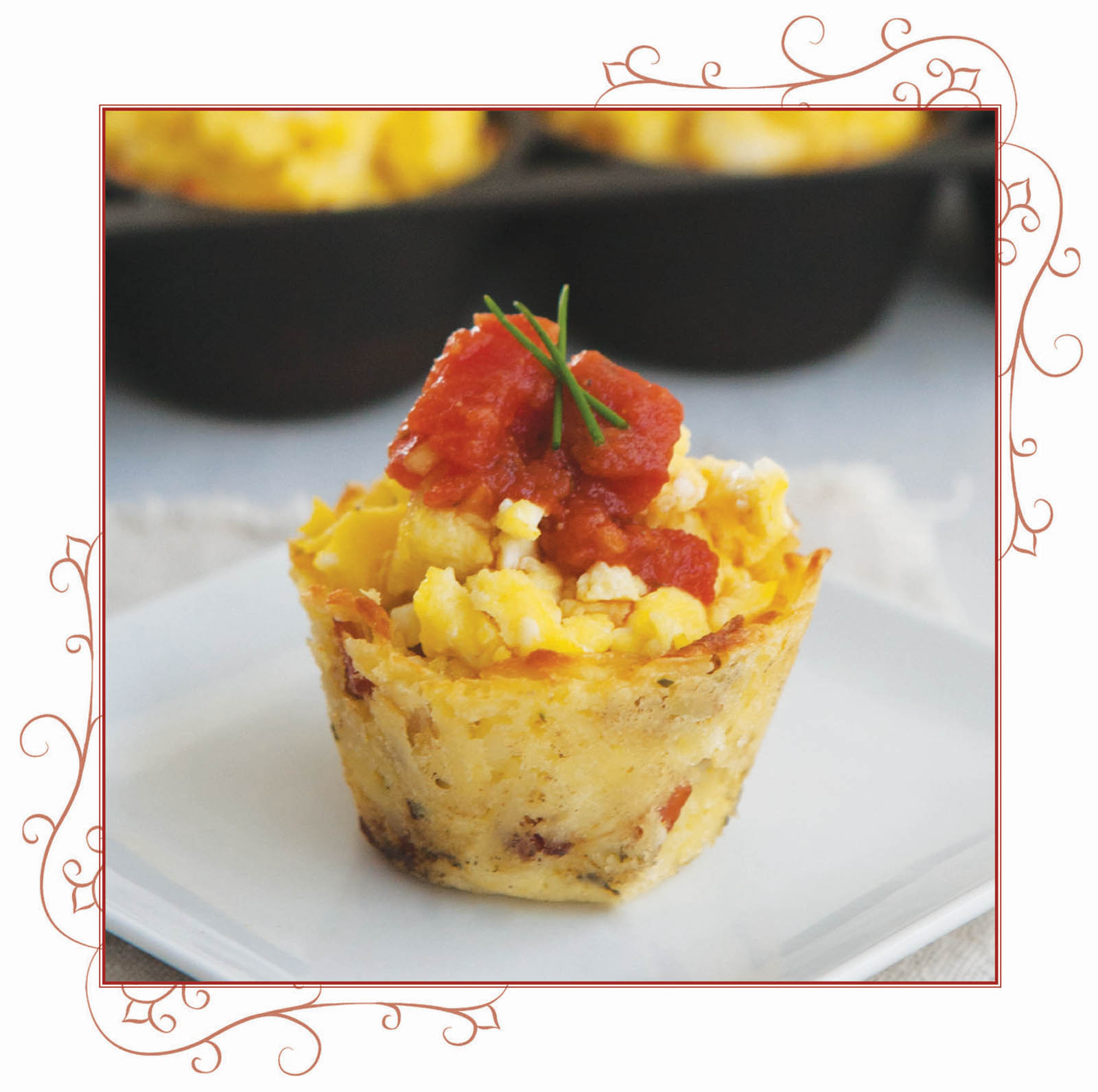

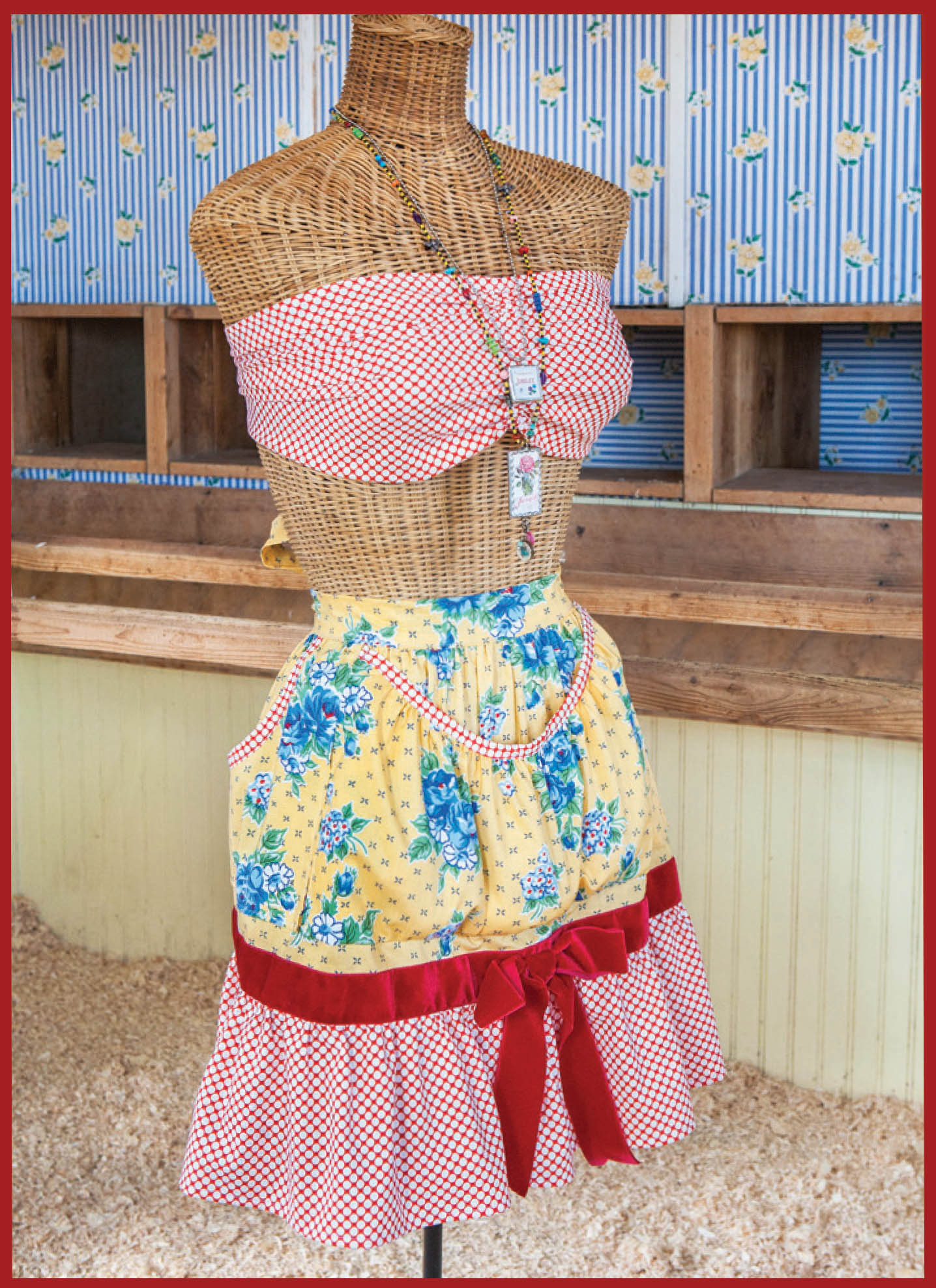
Fresh from our (wallpapered) henhouse to yours. What a wonderful surprise when our patterns for both children’s and adults’ egg-gathering aprons sold out the first day we put them up for sale. I mean, who can be without an egg-gathering apron that’s also handy for garden produce, notebook and pencil, hankie, or maybe a baby kitten or two?
Basic Aebleskiver
Aebleskiver are round Danish “puff pancakes”—solid like a pancake or griddlecake, but light and fluffy like a popover. The name means, literally, “apple slices,” and traditional aebleskiver often contained apples. They are such a part of Danish culture that annual Danish celebrations are often called “Aebleskiver Days.”
MAKES: 35 AEBLESKIVER
3 eggs
2 cups buttermilk
1 t vanilla extract
2 cups flour
1-1/2 t sugar
1/2 t salt
1 T baking powder
1 t baking soda
1/2 t pulverized cardamom seeds (about 4 pods)
3/4 cup safflower oil
powdered sugar
-
Separate the egg yolks from the whites into two medium bowls. Beat the yolks with the buttermilk and vanilla; set aside.
-
In a large bowl, combine flour, sugar, salt, baking powder, baking soda, and cardamom; add yolk-buttermilk mixture and stir well.
-
Beat egg whites until stiff. Carefully fold them into the flour mixture without breaking them down.
-
Place a cast-iron aebleskiver pan on the stove over medium heat. Add 1 t safflower oil to each cup and continue heating for a few minutes.
-
With a spoon, fill each cup with batter about 3/4 full. Do not overfill. If the oil is ready, the batter will sizzle when it’s dropped. Reduce heat to low.
-
When the aebleskiver are ready to be turned, they will start to bubble and separate from the sides of the pan. (Be patient—this can take several minutes.) At this point, run a dull knife around the inside edges of the cups to make sure they’re loose enough to turn. Using a knitting needle, chopstick, or knife, rotate each aebleskiver a quarter turn. Let cook for a minute and continue turning until a ball is formed. After each ball is golden brown, remove from pan with a spoon to a serving plate. Repeat steps 5 & 6 with remaining batter.
-
Add powdered sugar to a fine-mesh sieve. Just before serving, dust aebleskiver with powdered sugar and serve with applesauce and preserves or maple syrup.
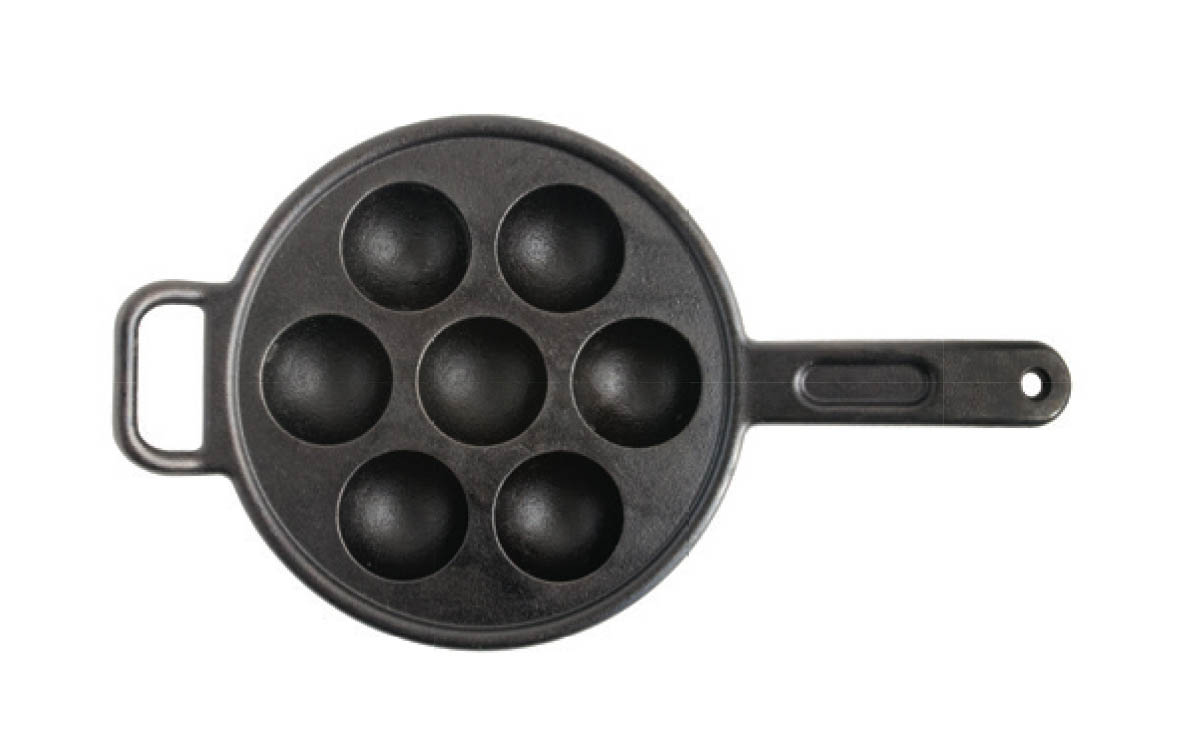
Cast-Iron Aebleskiver Pan
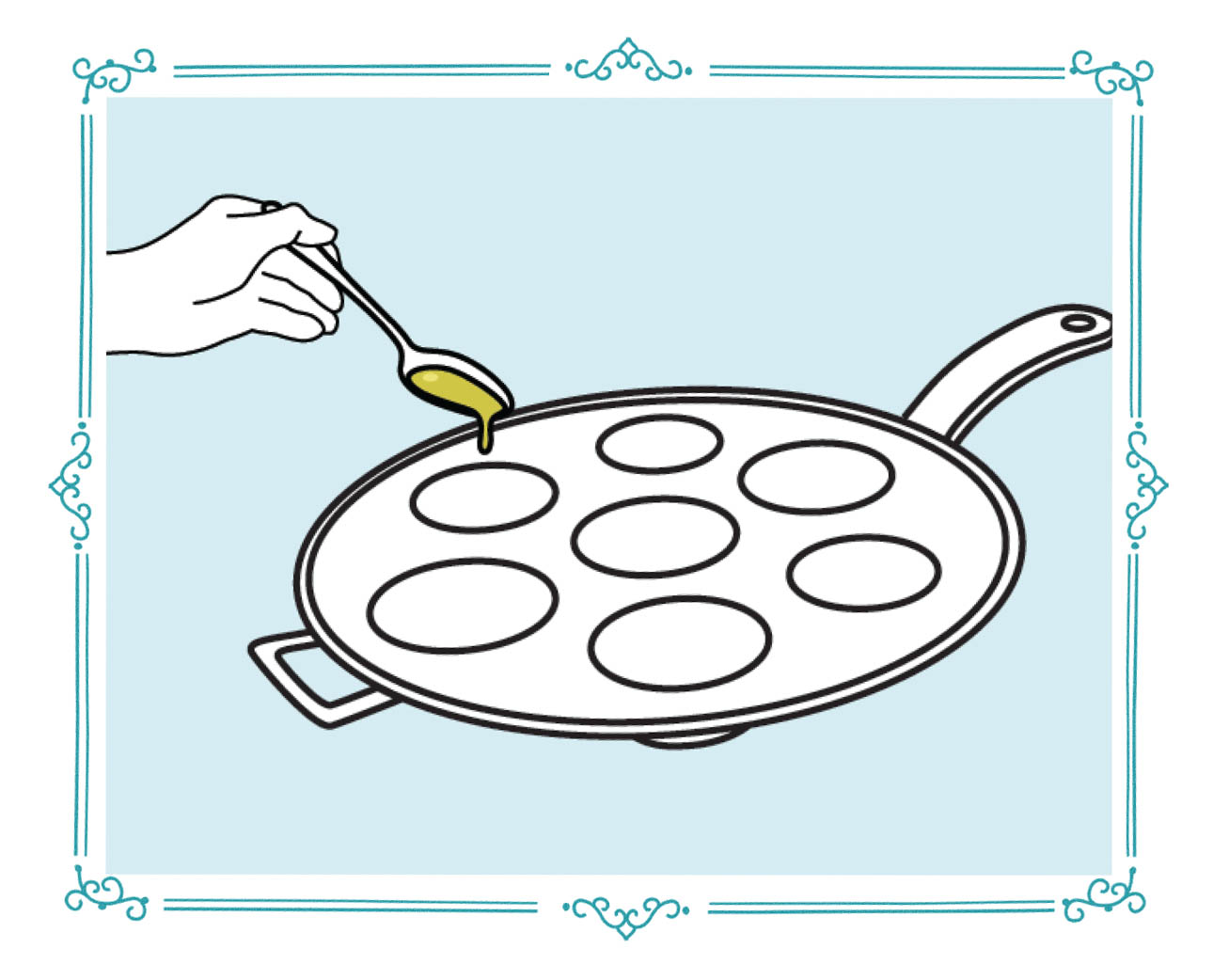
Above and below: How to roll an aebleskiver
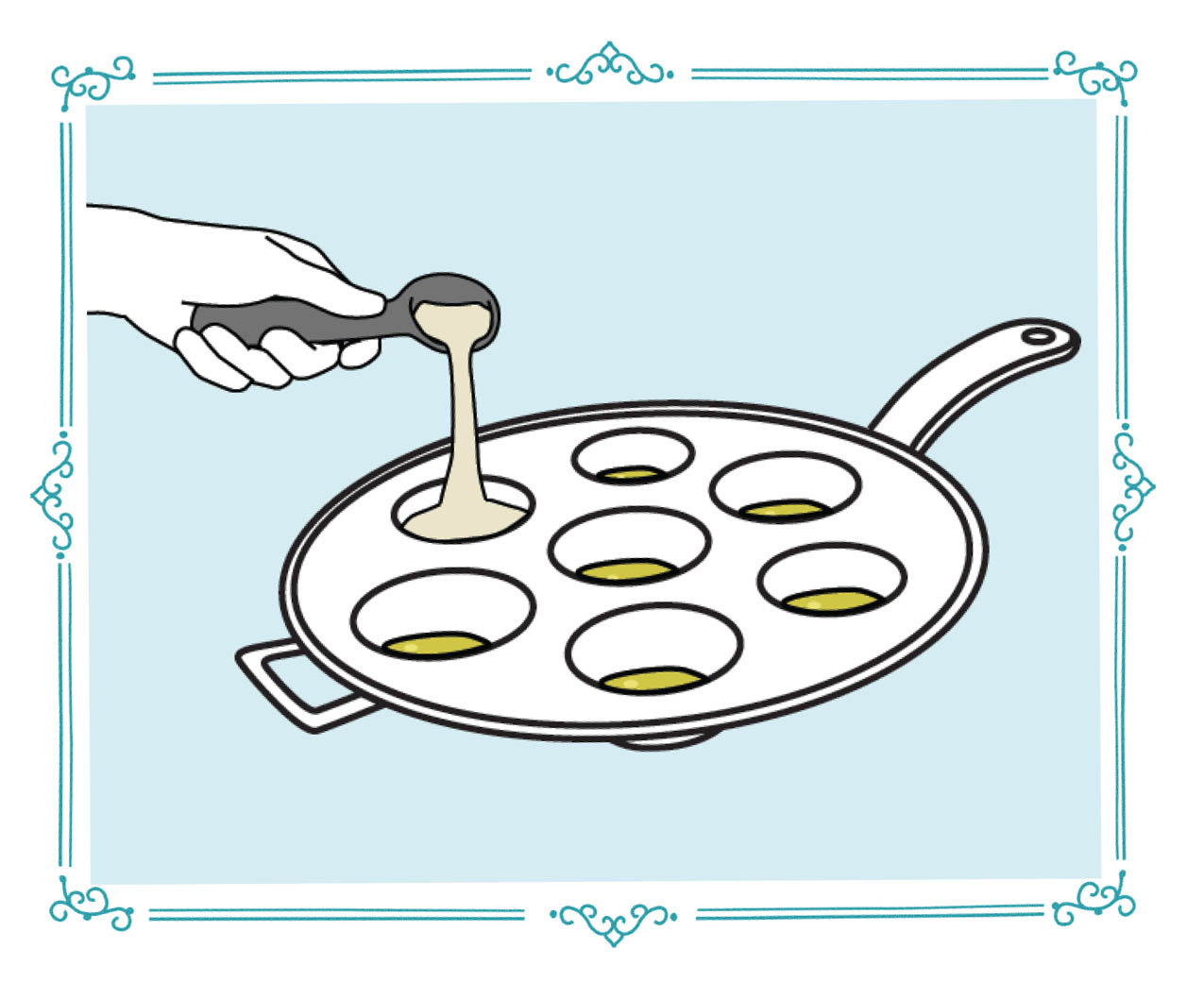
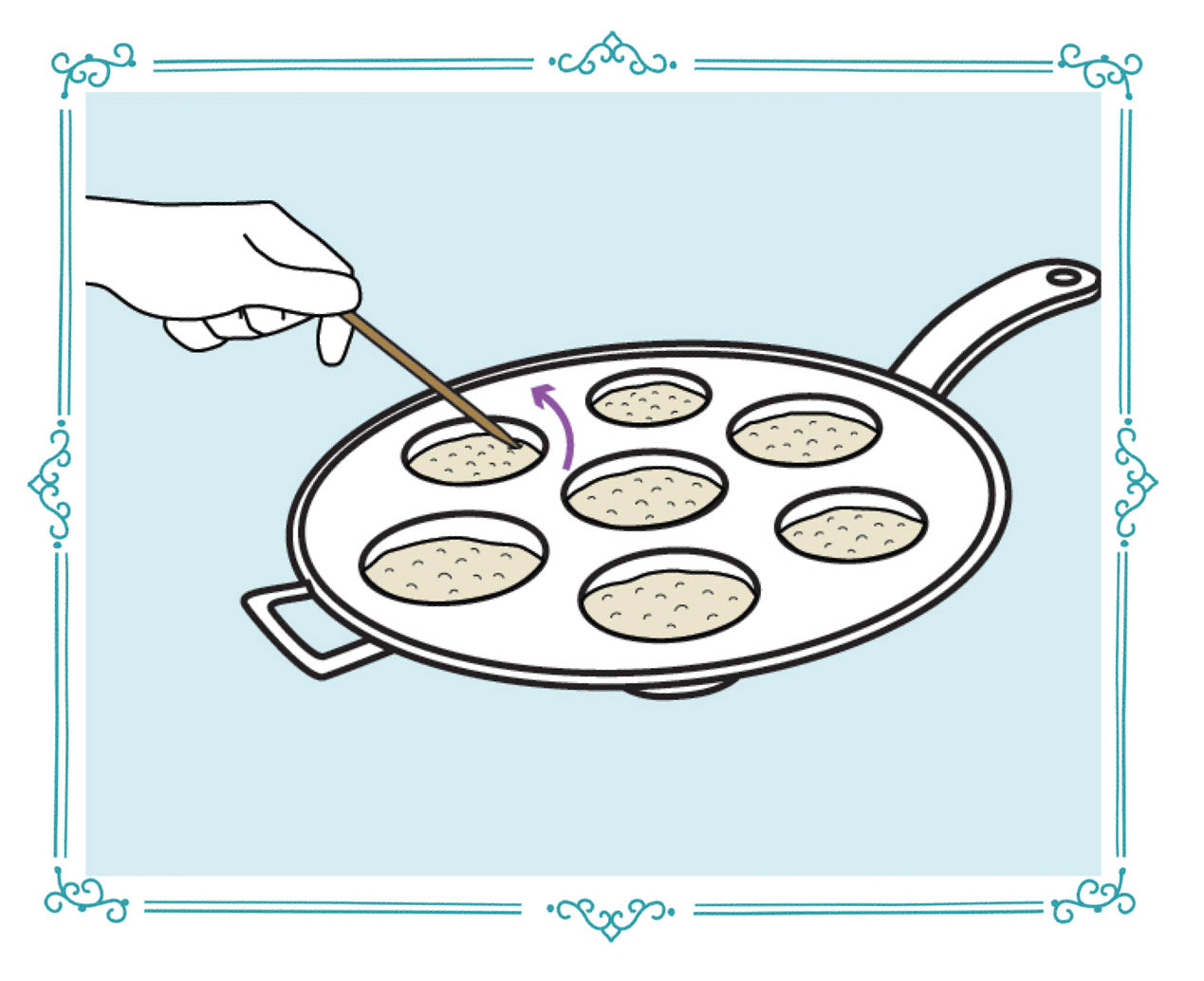
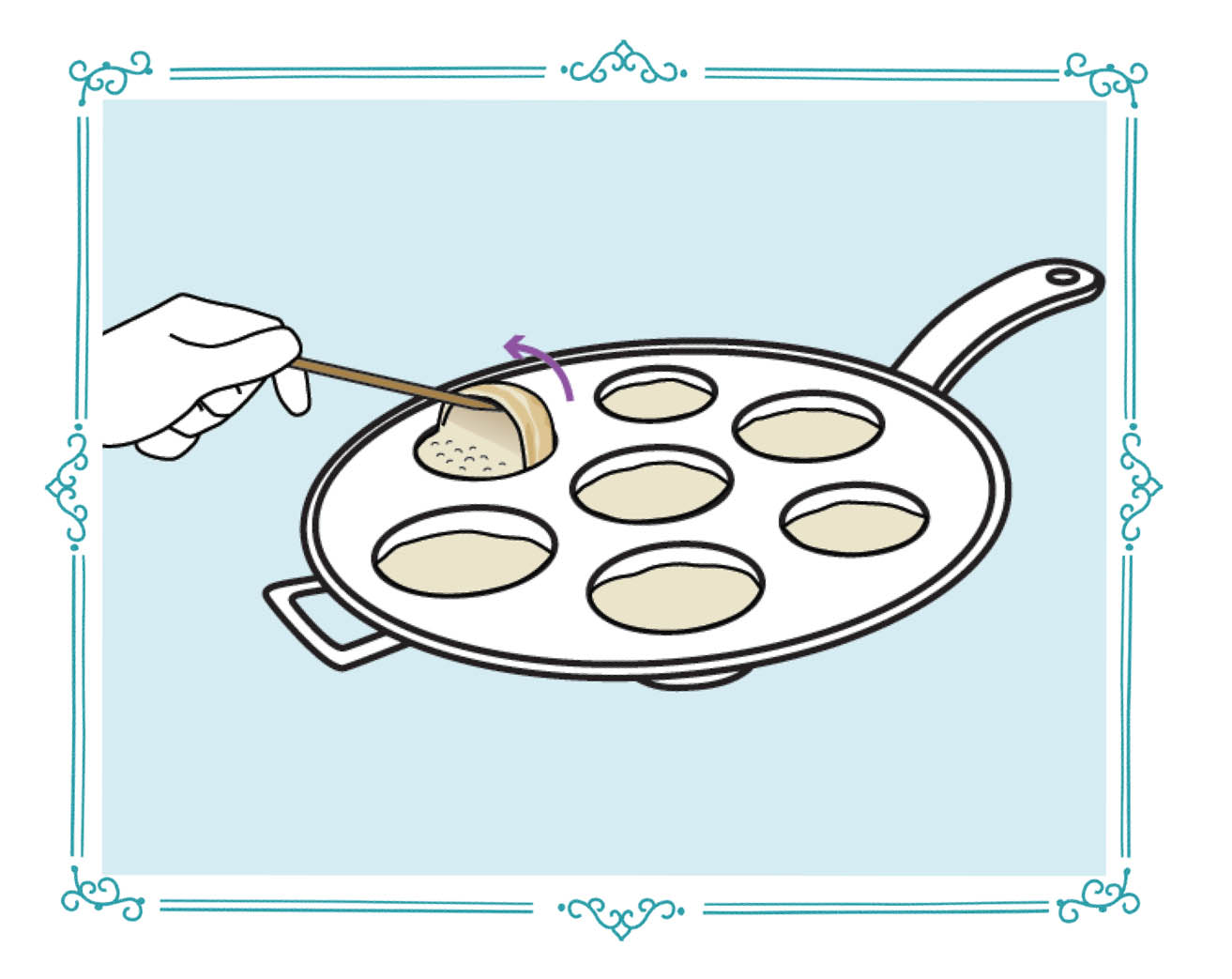
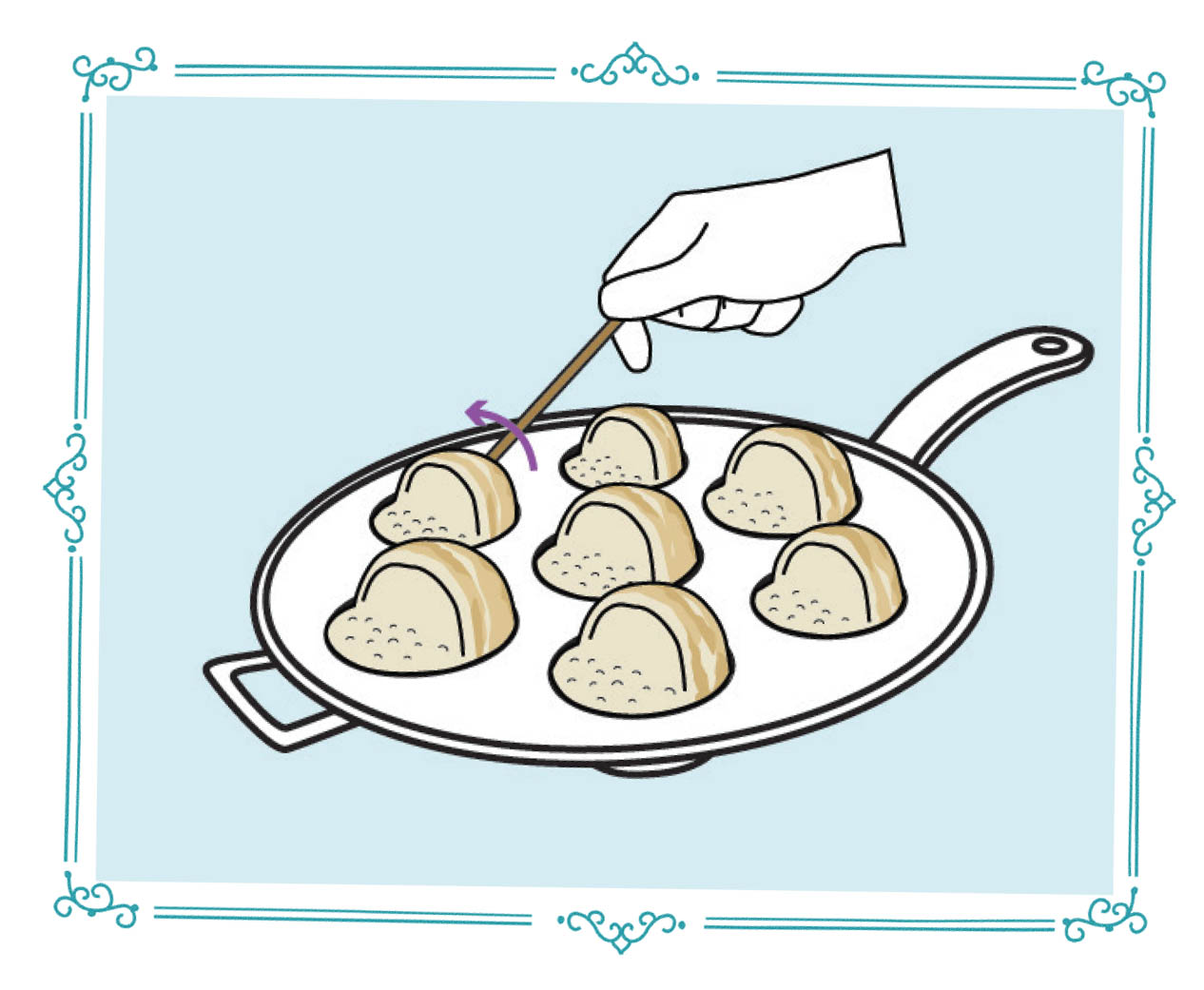
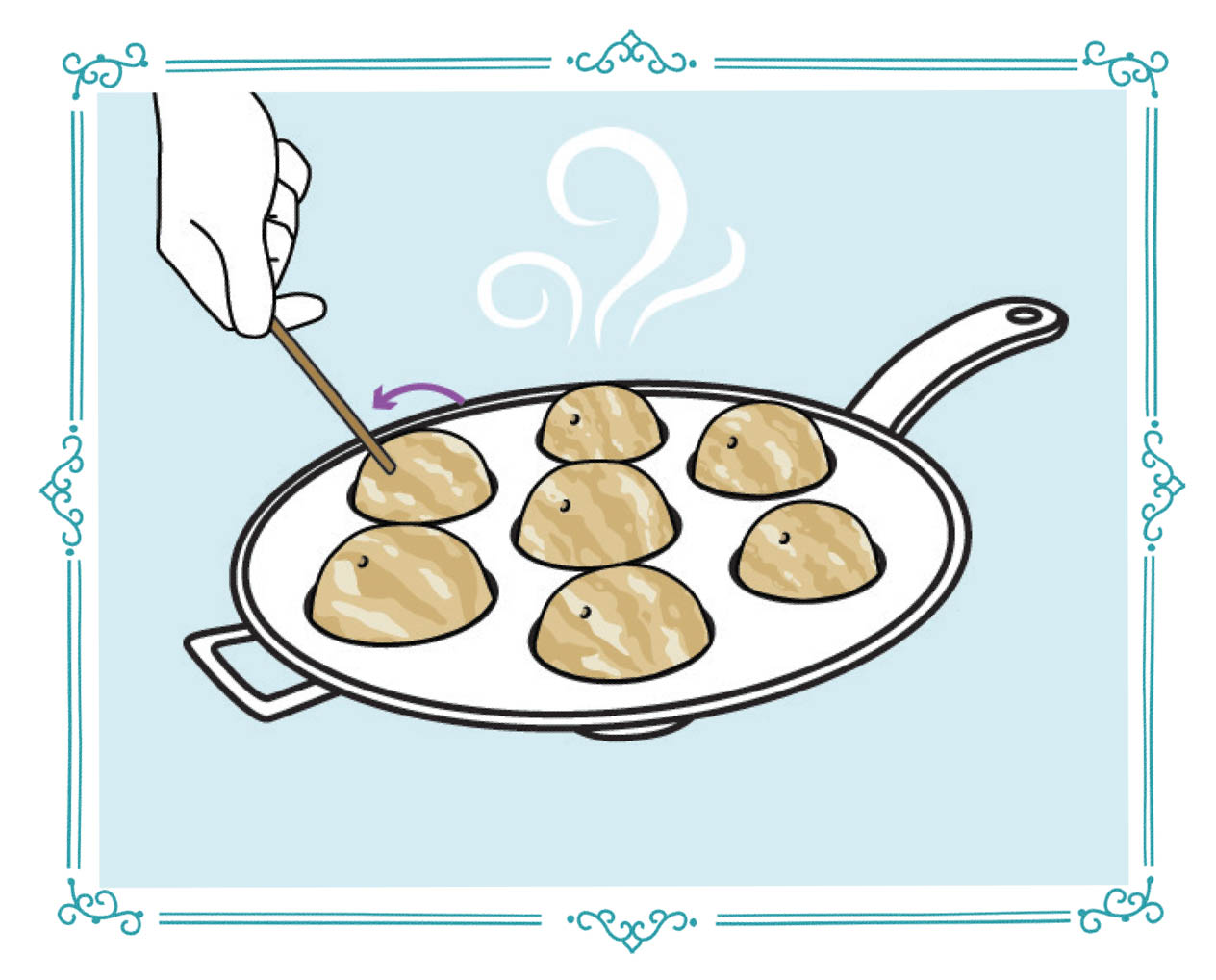

You might notice that I seem to be talking about one little lone aebleskiver in my recipes. But no … like the word “moose,” the word “aebleskiver” is both singular and plural. (Meese? Mooses?) It’s a Danish word that loosely translates to “apple slices,” since aebleskiver are traditionally served with apples. The reason my recipe makes 35 is because, if this is your first time making aebleskiver, your first few attempts might not be exactly plateable.
Cherry Aebleskiver
MAKES: 35 AEBLESKIVER
3 eggs
2 cups buttermilk
1 t vanilla extract
2 cups flour
1-1/2 t sugar
1/2 t salt
1 T baking powder
1 t baking soda
1/2 t pulverized cardamom seeds (about 4 pods)
3/4 cup safflower oil
powdered sugar
-
Separate the egg yolks from the whites into two medium bowls. Beat the yolks with the buttermilk and vanilla; set aside.
-
In a large bowl, combine flour, sugar, salt, baking powder, baking soda, and cardamom; add yolk-buttermilk mixture and stir well.
-
Beat egg whites until stiff. Carefully fold them into the flour mixture without breaking them down.
-
Place a cast-iron aebleskiver pan on the stove over medium heat. Add 1 t safflower oil to each cup and continue heating for a few minutes.
-
With a spoon, fill each cup with batter about 1/3 full. Quickly add a dollop of Cherry Pie Freezer Jam, then cover with a dollop of batter. Do not overfill. If the oil is ready, the batter will sizzle when it’s dropped. Reduce heat to low and follow the basic aebleskiver cooking technique as described in step 6 of the Basic Aebleskiver recipe.
-
Add powdered sugar to a fine-mesh sieve. Just before serving, dust aebleskiver with powdered sugar and serve with additional cherry preserves.

Cast-Iron Aebleskiver Pan
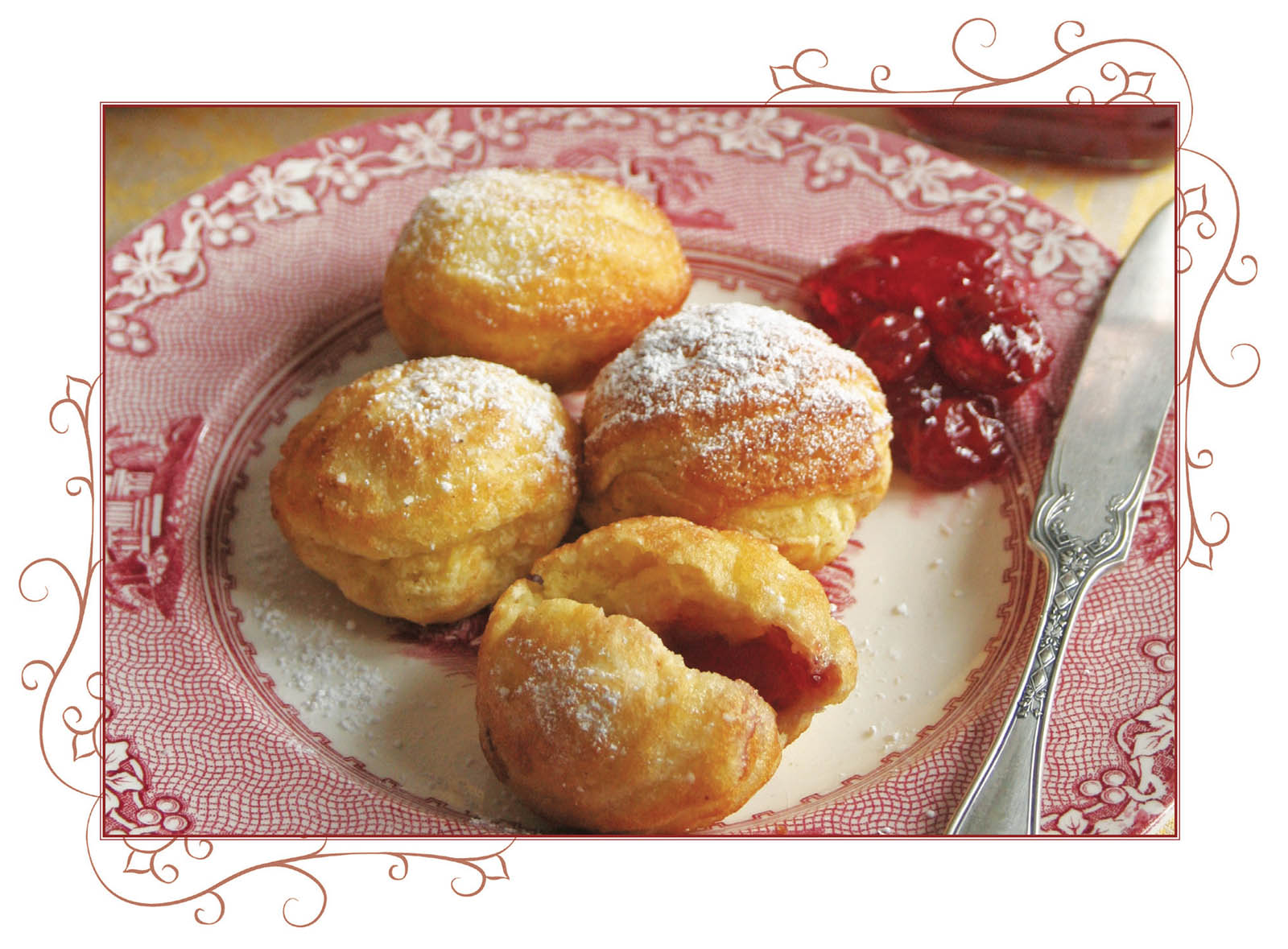
Chocolate Aebleskiver
MAKES: 35 AEBLESKIVER
3 eggs
2 cups half-and-half
1 t vanilla extract
1-2/3 cups flour
1/3 cup cocoa powder
2 t sugar
1/2 t salt
1 T baking powder
1 t baking soda
1/2 t cinnamon
3/4 cup safflower oil
powdered sugar
whipped cream
-
Separate the egg yolks from the whites into two medium bowls. Beat the yolks with half-and-half and vanilla; set aside.
-
In a large bowl, combine flour, cocoa powder, sugar, salt, baking powder, baking soda, and cinnamon; add yolk mixture and stir well.
-
Beat egg whites until stiff. Carefully fold them into the flour mixture without breaking them down.
-
Place a cast-iron aebleskiver pan on the stove over medium heat. Add 1 t safflower oil to each cup and continue heating for a few minutes.
-
With a spoon, fill each cup with batter about 3/4 full. Do not overfill. If the oil is ready, the batter will sizzle when it’s dropped. Reduce heat to low and follow the basic aebleskiver cooking technique as described in step 6 of the Basic Aebleskiver recipe.
-
Add powdered sugar to a fine-mesh sieve. Just before serving, dust aebleskiver with powdered sugar and serve with whipped cream.

Cast-Iron Aebleskiver Pan
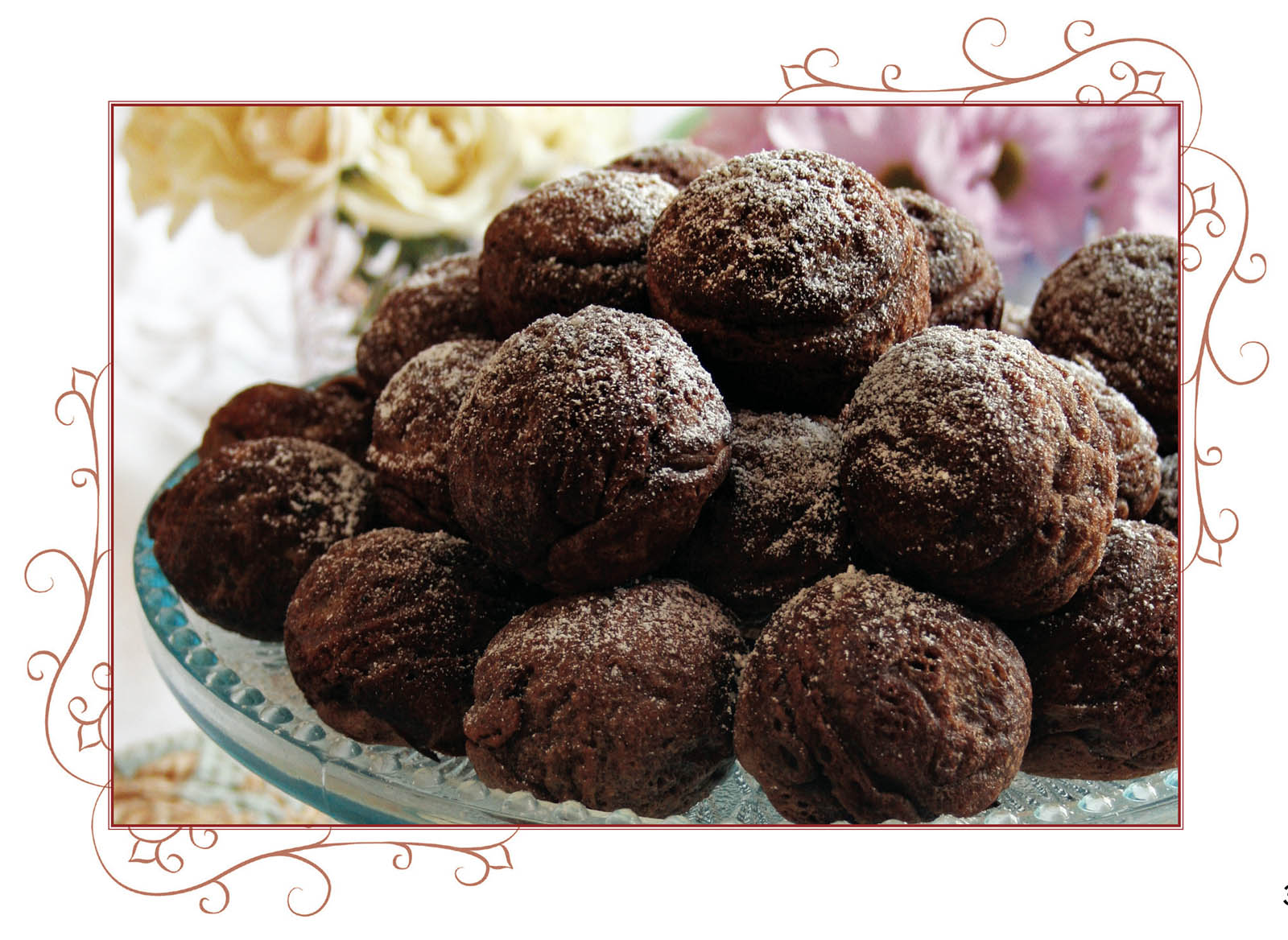
Canadian-Bacon Mini Quiches
I love dreaming up new ways to serve dishes traditionally made with crusts. This particular recipe transforms an ordinary piece of Canadian bacon into a bite-sized crust that is tender with just the right amount of crispness around the edges.
MAKES: 7 MINI QUICHES
7 3-1/4”-round slices
Canadian bacon
2 T finely diced red bell pepper
1 T finely diced zucchini
1 egg
1/2 t milk
1/2 oz sharp Cheddar cheese, shredded (about 2 T)
-
Preheat oven to 400°F.
-
Line cups of a cast-iron aebleskiver pan with a slice of Canadian bacon, pinching in each slice so it makes a bowl in the half-round cup of the pan.
-
Evenly divide pepper and zucchini between Canadian-bacon bowls.
-
In a small bowl, combine egg, milk, and salt; evenly divide mixture between Canadian-bacon bowls.
-
Bake for 15–18 minutes, or until egg mixture has set. Remove pan from oven, sprinkle tops with cheese, and bake 2 more minutes, or until cheese is melted.

Cast-Iron Aebleskiver Pan

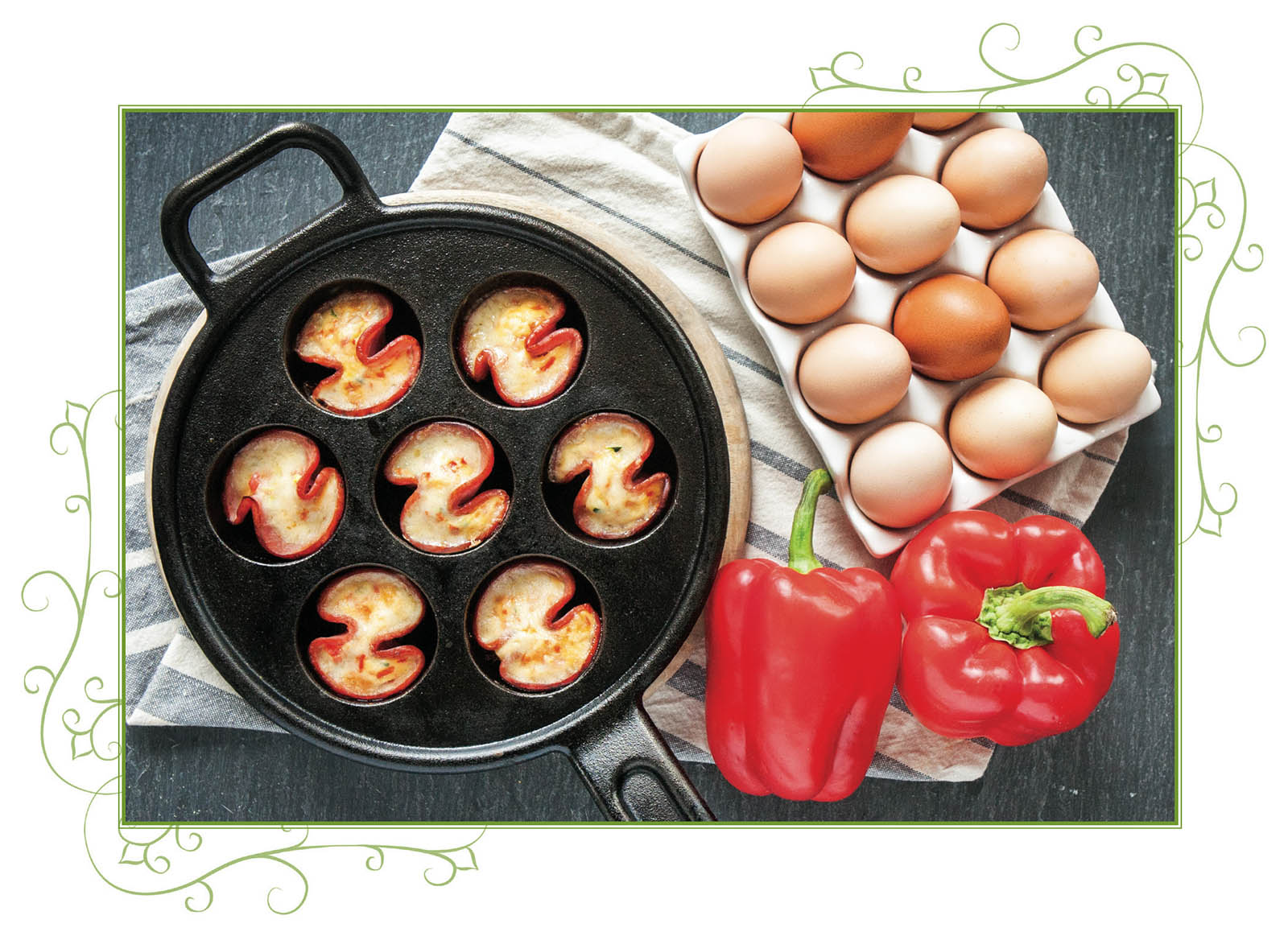
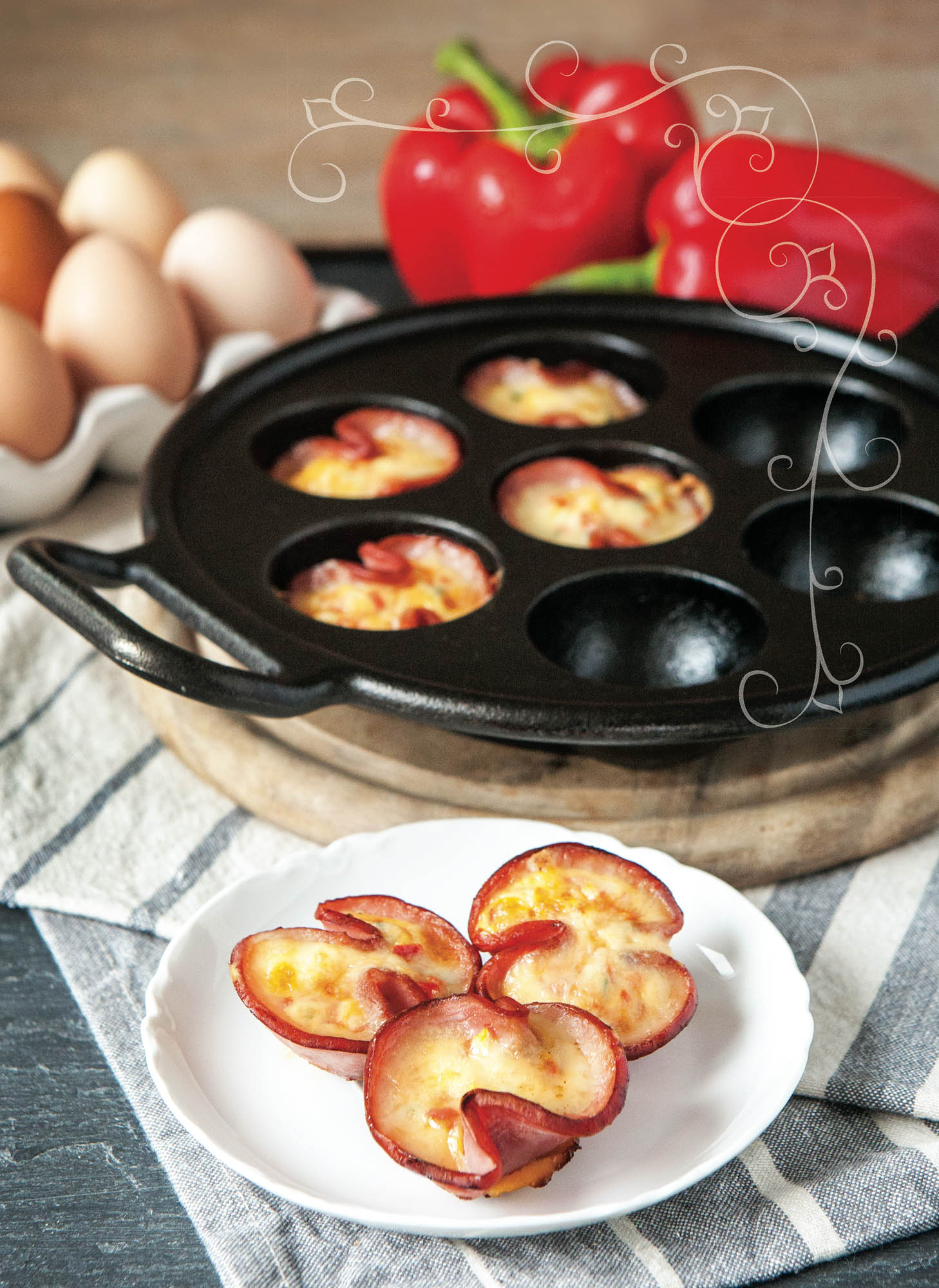
Almond Waffles
When I’m in the mood for something sweet and simple for breakfast, nothing beats these almond waffles. I love the smell of waffles cooking in the morning, and the scent of almond as the waffles cook adds an extra layer of enjoyment to the process.
MAKES: 4 SERVINGS
2 T coconut oil, melted
4 eggs, room temperature
1/4 cup applesauce, room temperature
1 t almond extract
1/4 t sea salt
1 t baking soda
1/2 t apple-cider vinegar
2 cups almond flour
maple syrup
-
In a large bowl, whisk together the oil, eggs, applesauce, almond extract, salt, baking soda, and vinegar. Add almond flour and whisk just until smooth.
-
Preheat a cast-iron waffle iron over medium heat.
-
Once the waffle iron is hot, brush with coconut oil. Spoon about 1/4 of the batter into the waffle iron. Cook for about 2-1/2 minutes on each side or until golden. Repeat with remaining batter.
-
Serve waffles with butter and maple syrup.
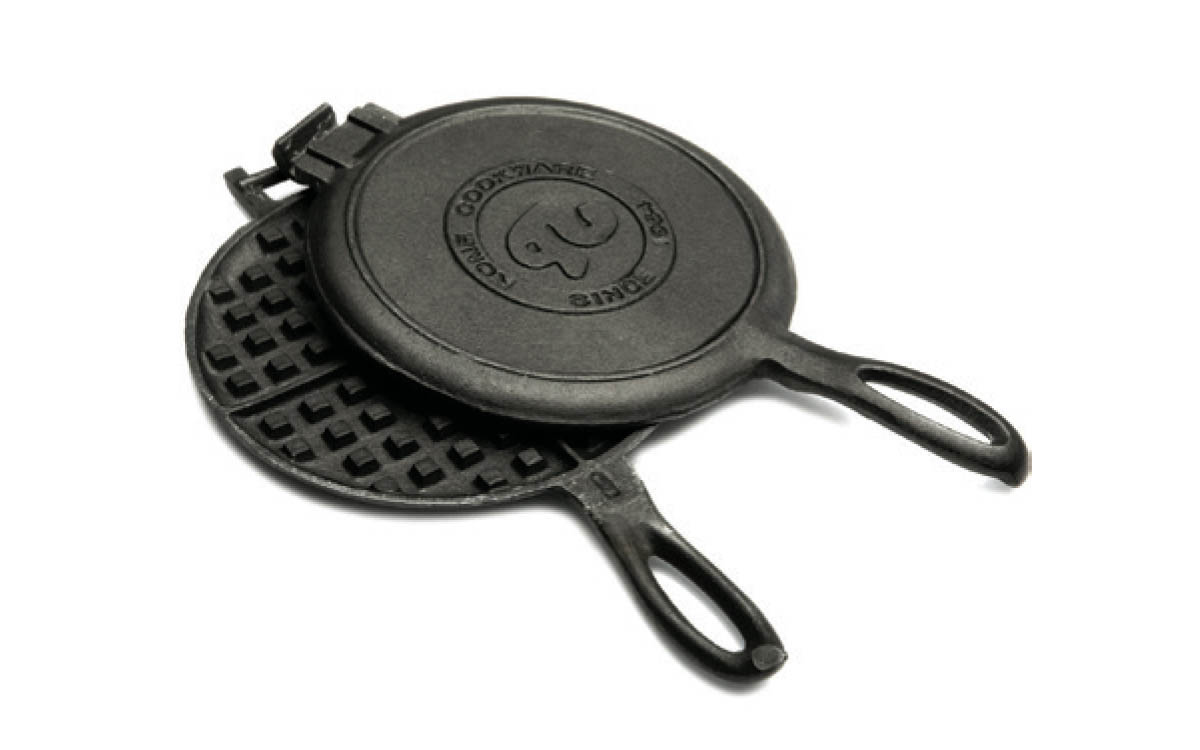
Cast-Iron Waffle Iron

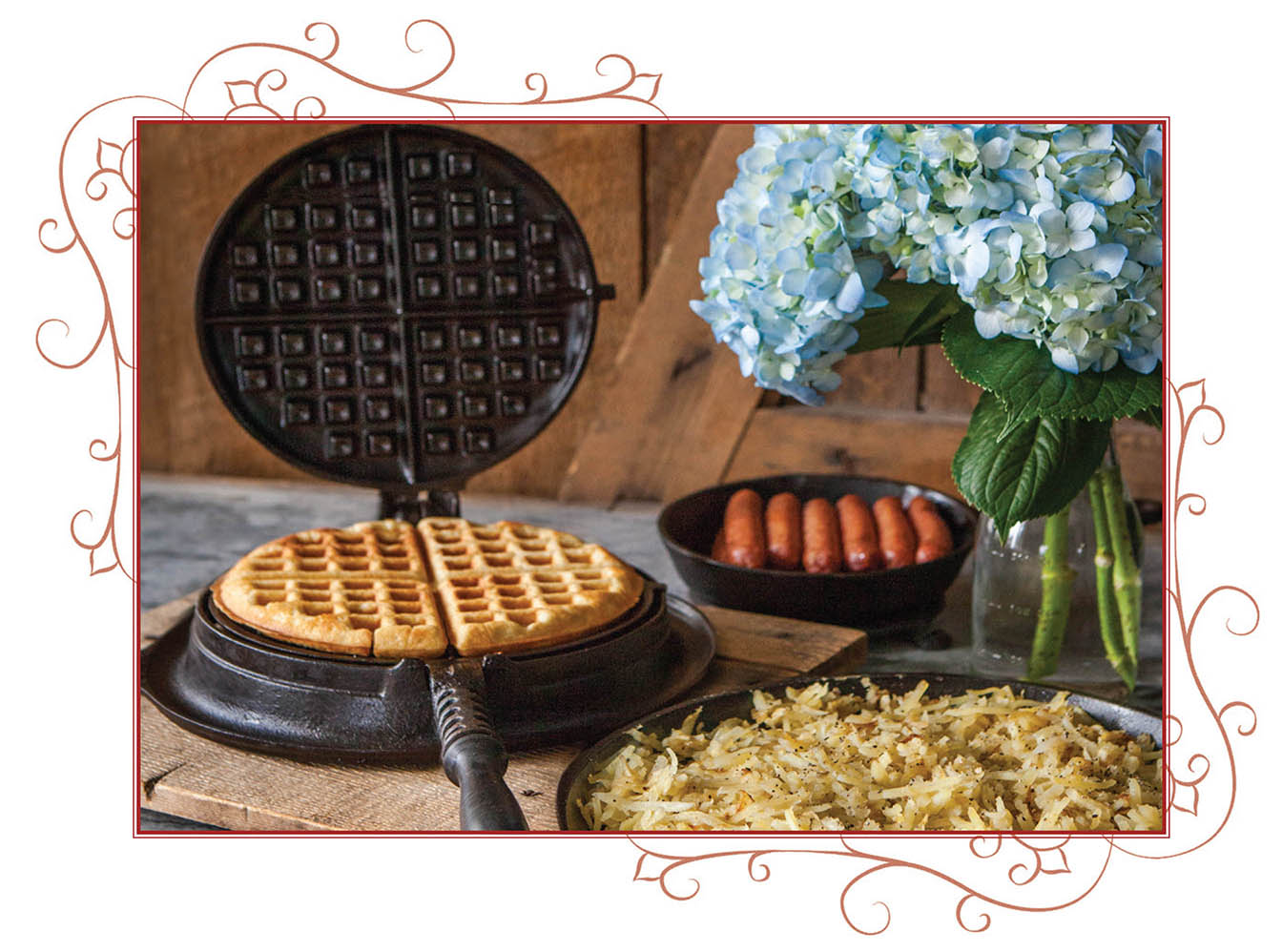
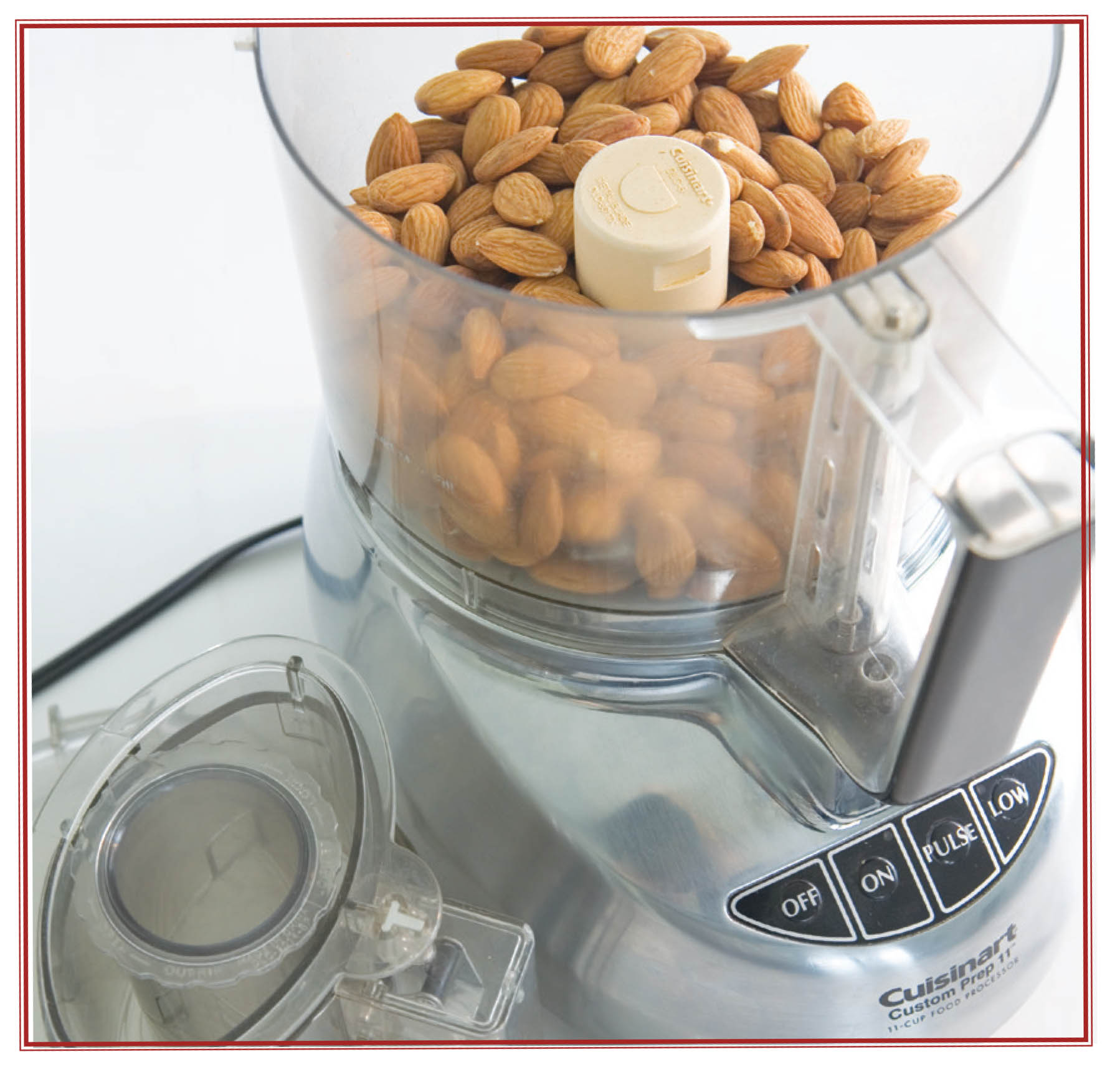
Above and below: Because store-bought almond flour can sit on the shelf too long and go rancid, I make my own, using a food processor.
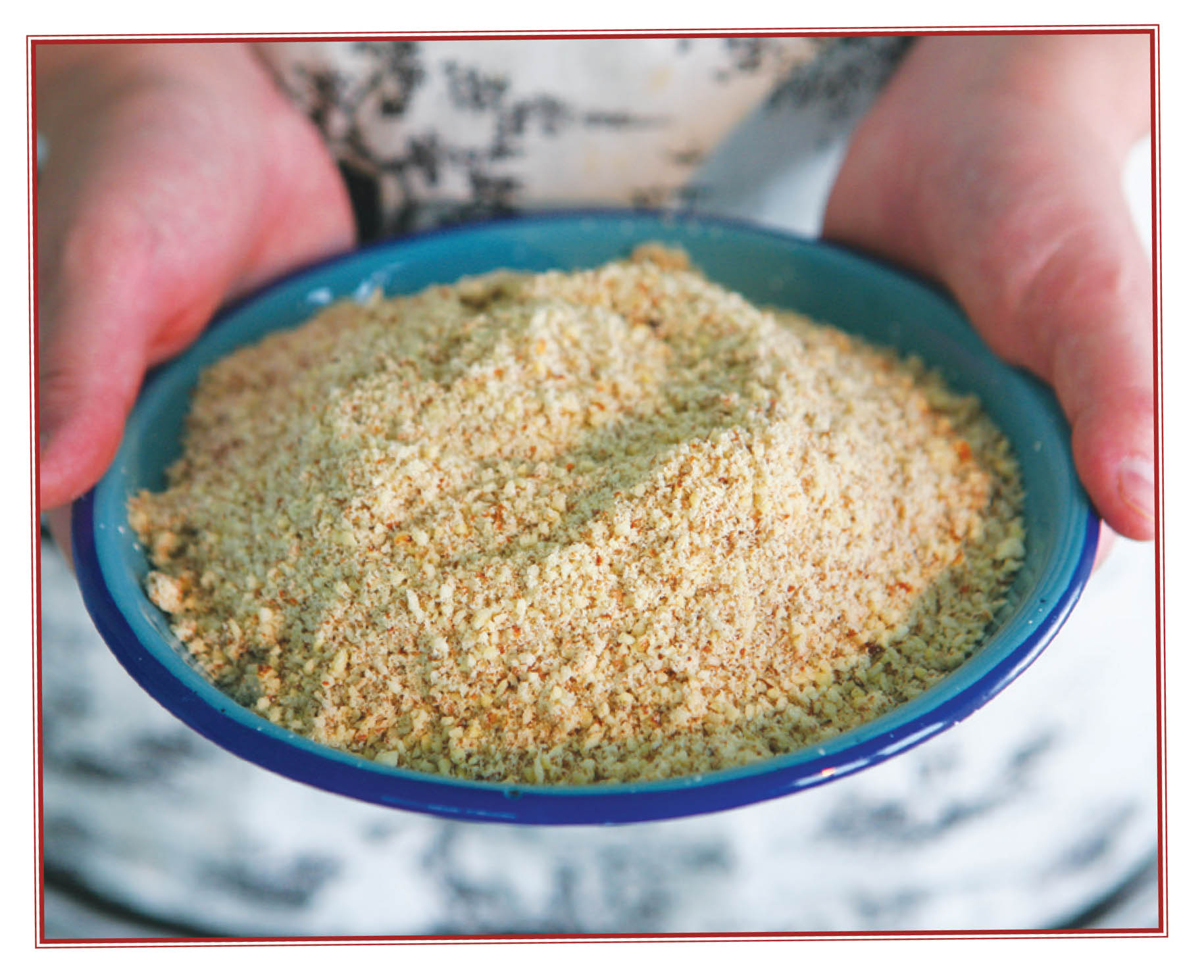
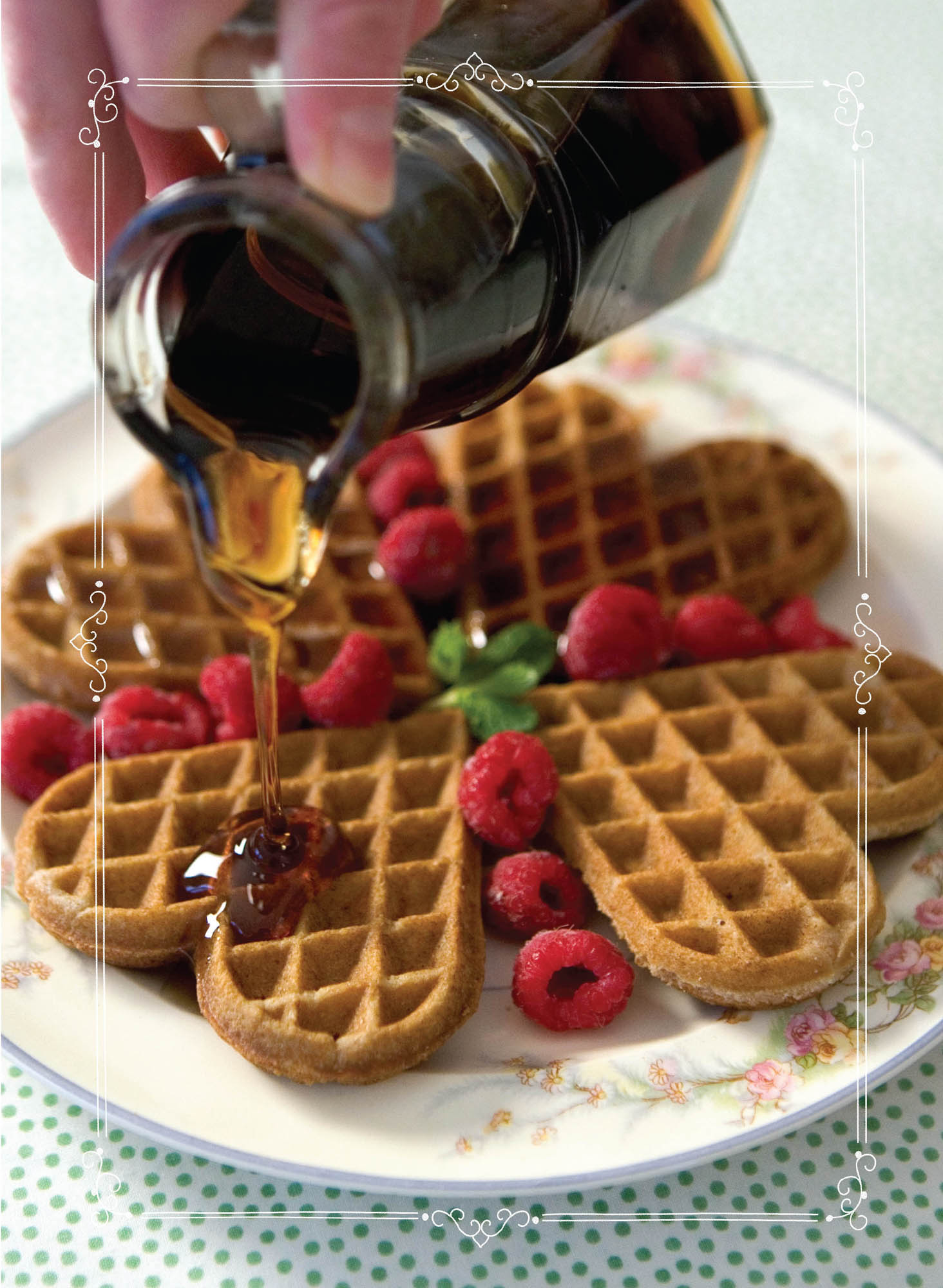
Savory Potato & Buckwheat Waffles
This recipe offers a wonderfully unique twist on waffles. The potatoes give the waffles a moist, tender base, and the buckwheat and caraway complement each other perfectly. The cabbage, fennel, andouille sausage, and barbecue sauce toppings make it a truly memorable dish.
MAKES: 4 WAFFLES
12 ozs potatoes, peeled and diced (about 2-1/4 cups)
2 cloves garlic, peeled
1 bay leaf
1/4 cup olive oil
3/4 cup buttermilk
1/4 cup buckwheat flour
3 eggs
1/2 t salt
1/4 t caraway seeds
1 t baking powder
1/2 t baking soda
coconut oil
-
Place potatoes, garlic cloves, and bay leaf into a 4-qt saucepan. Fill pan with enough water to cover the potatoes and bring to a boil over high heat.
-
Reduce heat to simmer. Once potatoes are fork tender, drain off the water and discard the bay leaf.
-
Add olive oil and buttermilk. Using a potato masher, mash the potatoes until they have a smooth, creamy consistency.
-
Add buckwheat flour, eggs, salt, caraway, baking powder, and baking soda. Mix well.
-
Preheat a cast-iron waffle iron over medium-high heat.
-
Once the waffle iron is hot, brush with coconut oil. Spoon about 1/4 of the batter into waffle iron. Cook for about 2-1/2 minutes on each side or until golden. Repeat with remaining batter.
-
Serve with Cabbage and Fennel Hash.

Cast-Iron Waffle Iron

Cabbage & Fennel Hash
MAKES: TOPPING FOR 4 WAFFLES
8 ozs andouille sausage, cooked and sliced into 1/4” coins
1/2 cup barbecue sauce
1-1/2 T olive oil
12 ozs green cabbage, shredded (about 2-1/2 cups)
1/2 cup purple cabbage, shredded
1/2 fennel bulb, trimmed and shredded (about 1 cup)
1/4 onion, peeled and shredded (about 1/2 cup)
1/2 t salt
1/2 t pepper
-
In a 2-qt saucepan, heat sausage and barbecue sauce. Set aside.
-
In a large skillet, heat olive oil over medium heat. Add remaining ingredients.
-
Cook for 3–5 minutes, stirring frequently, until cabbage is tender-crisp.
-
Top waffles with cabbage mixture, then sausage.
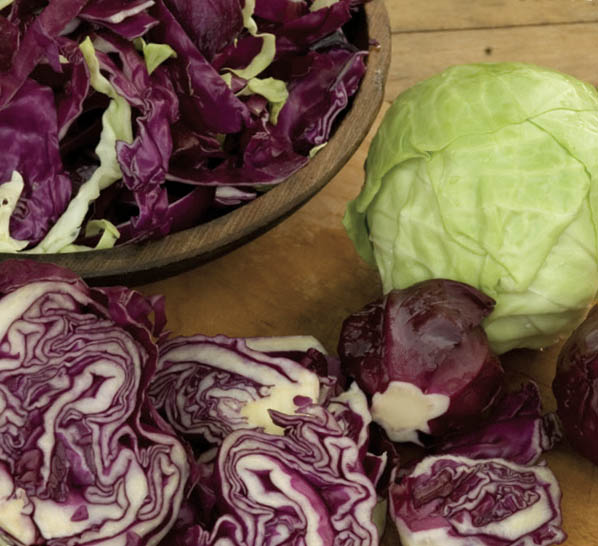

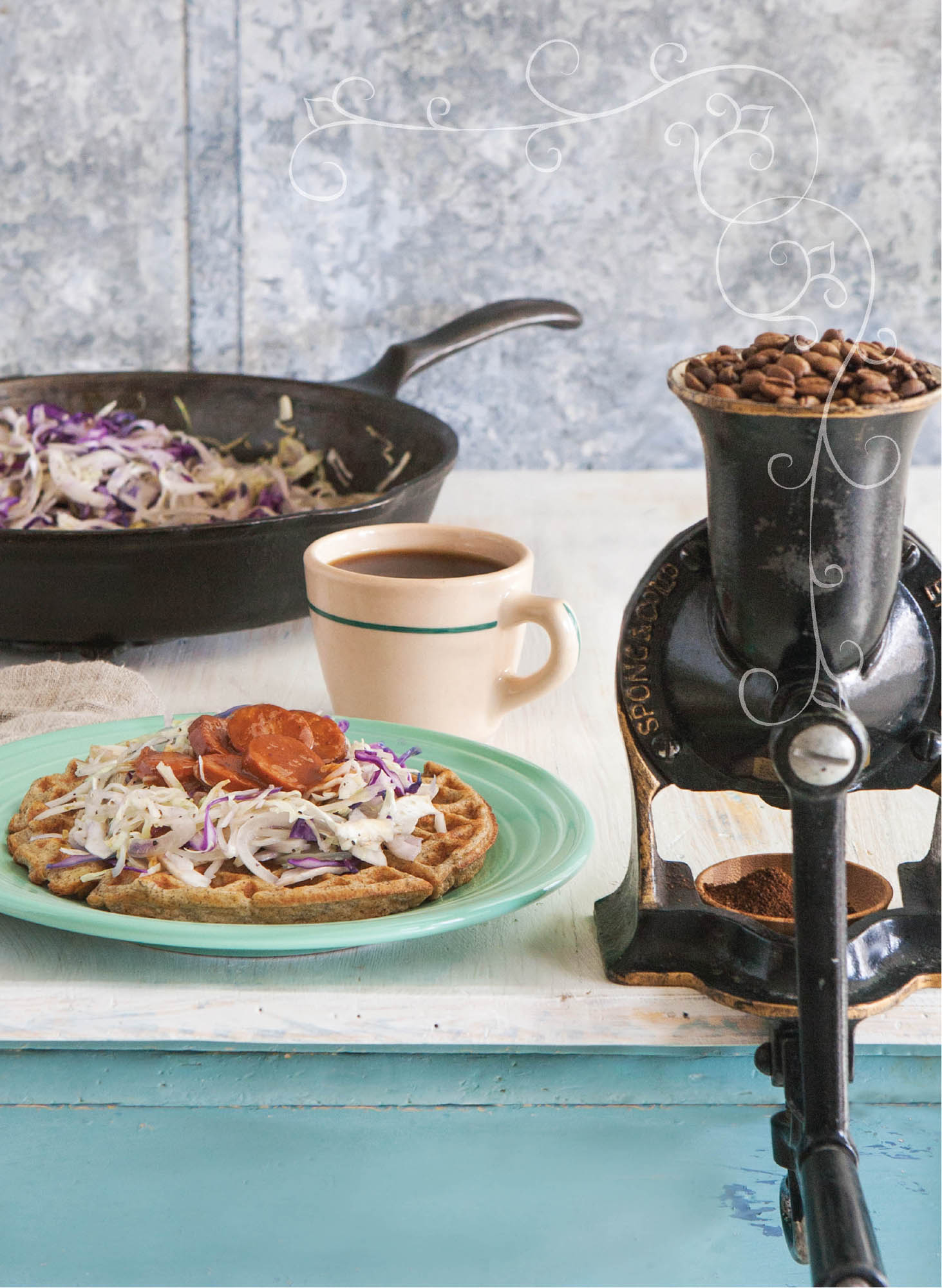
Did you know that waffles and pancakes are best when made using whole-grain flour? That’s because the high amount of gluten in white flour makes them more sticky. Plus, you don’t have to worry about over-mixing the batter when you use whole grain.
This nifty vintage cast-iron coffee grinder attaches to your table. You can also use it to grind nuts. This one’s marked “made in England.” I love to think of a proper British lady kicking aside all that tea and grinding up a cup of joe.
Hash-Brown Patties
Have you ever diced up potatoes for breakfast, tossed them in a skillet with a little oil, and cooked them for what seems like forever, only to end up with a batch of undercooked potatoes? Disappointing, right? But once I started using my spiralizer to make these hash-brown patties, I bid adieu to undercooked, starchy potatoes, and happily welcomed these crisp, flavorful patties to my breakfast table.
MAKES: 6 PATTIES
1 large russet potato (about 1 lb)
3 T safflower oil, divided
3/4 t salt
1/2 t pepper
1/4 t paprika
1/4 t granulated onion
Special Equipment: Spiralizer
-
Using a spiralizer, cut potato into noodles using noodle blade.
-
Using a knife, cut potatoes into manageable lengths and transfer to large bowl. Add 1 T safflower oil, salt, pepper, paprika, and onion to potatoes. Toss to combine.
-
Preheat a cast-iron griddle over medium-low heat. Once griddle is hot, add 1 T safflower oil. Add potatoes in mounds (roughly 3/4 cup for each mound). Spread out each mound and flatten with the back side of a spatula. Cook for 4–5 minutes, flip over and cook an additional 4–5 minutes.
-
Repeat this process with remaining potato mixture, adding remaining safflower oil as needed. Serve hash-brown patties immediately.
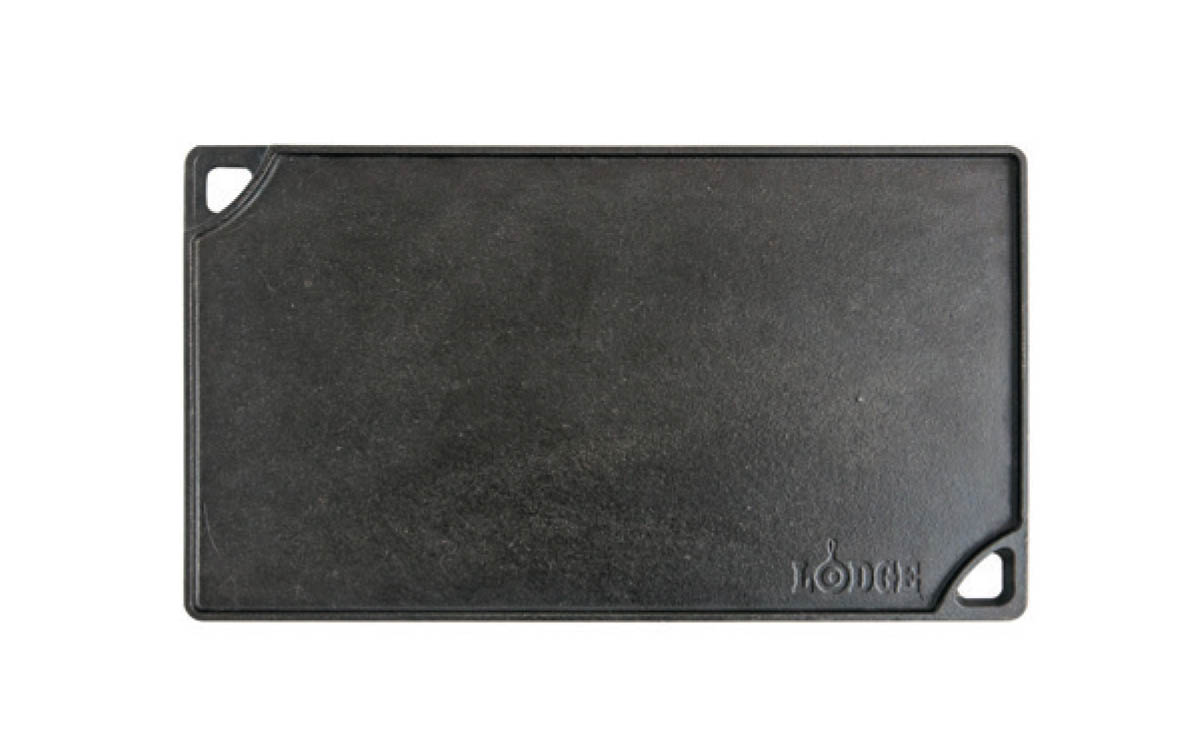

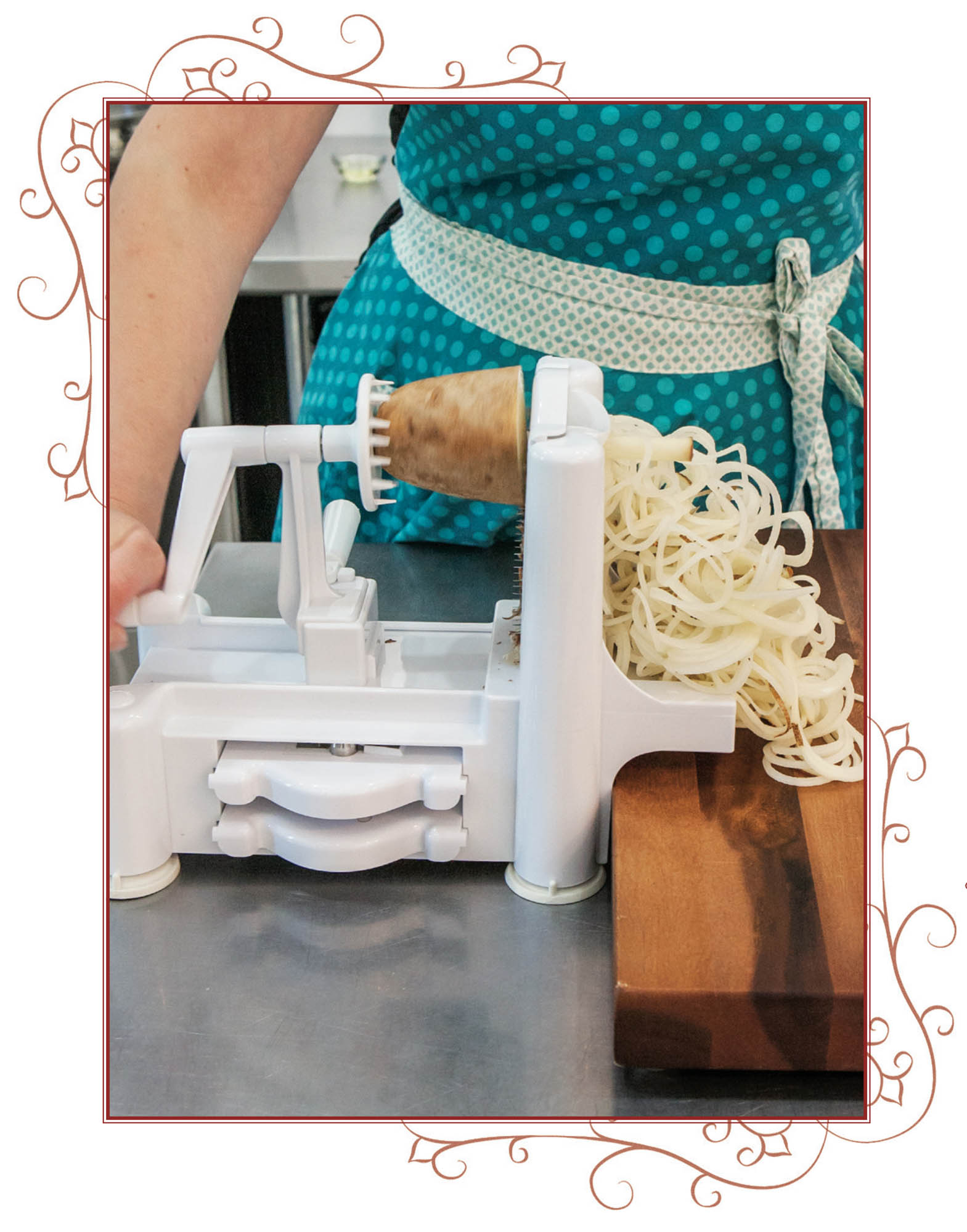
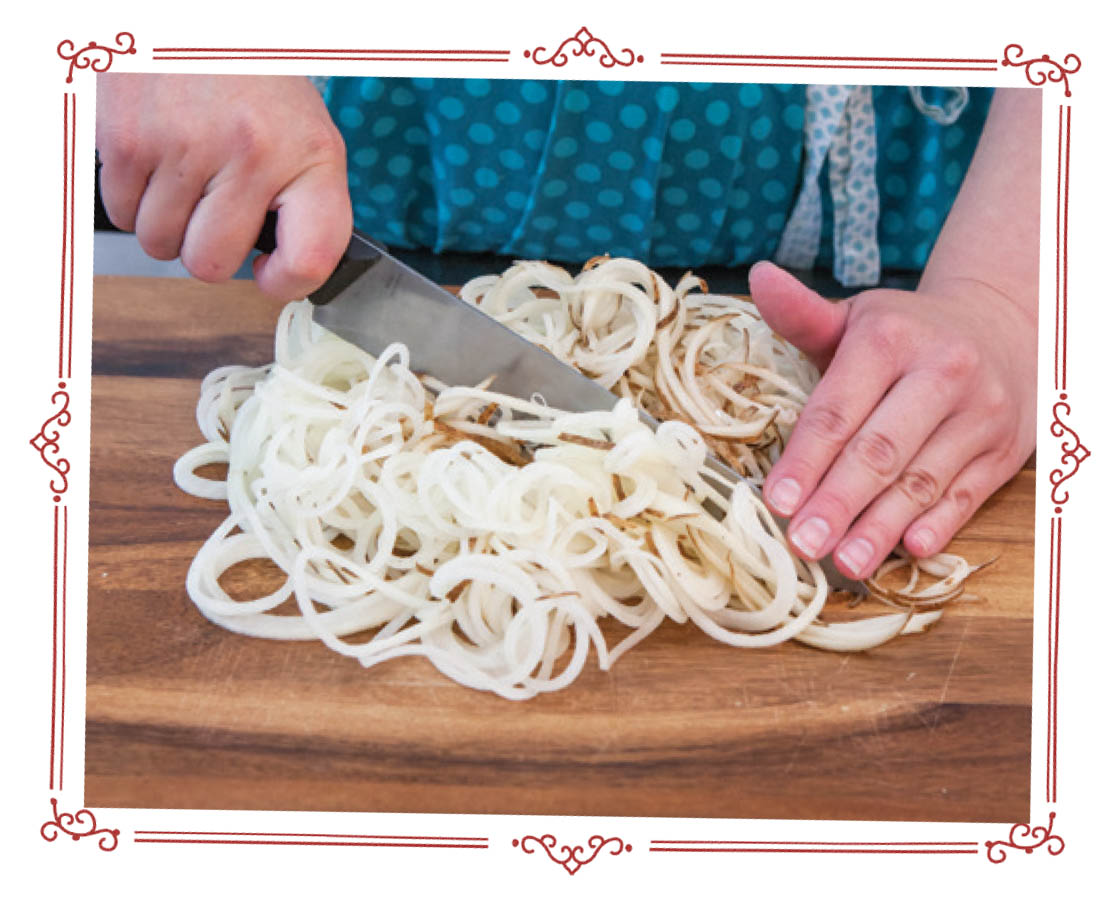
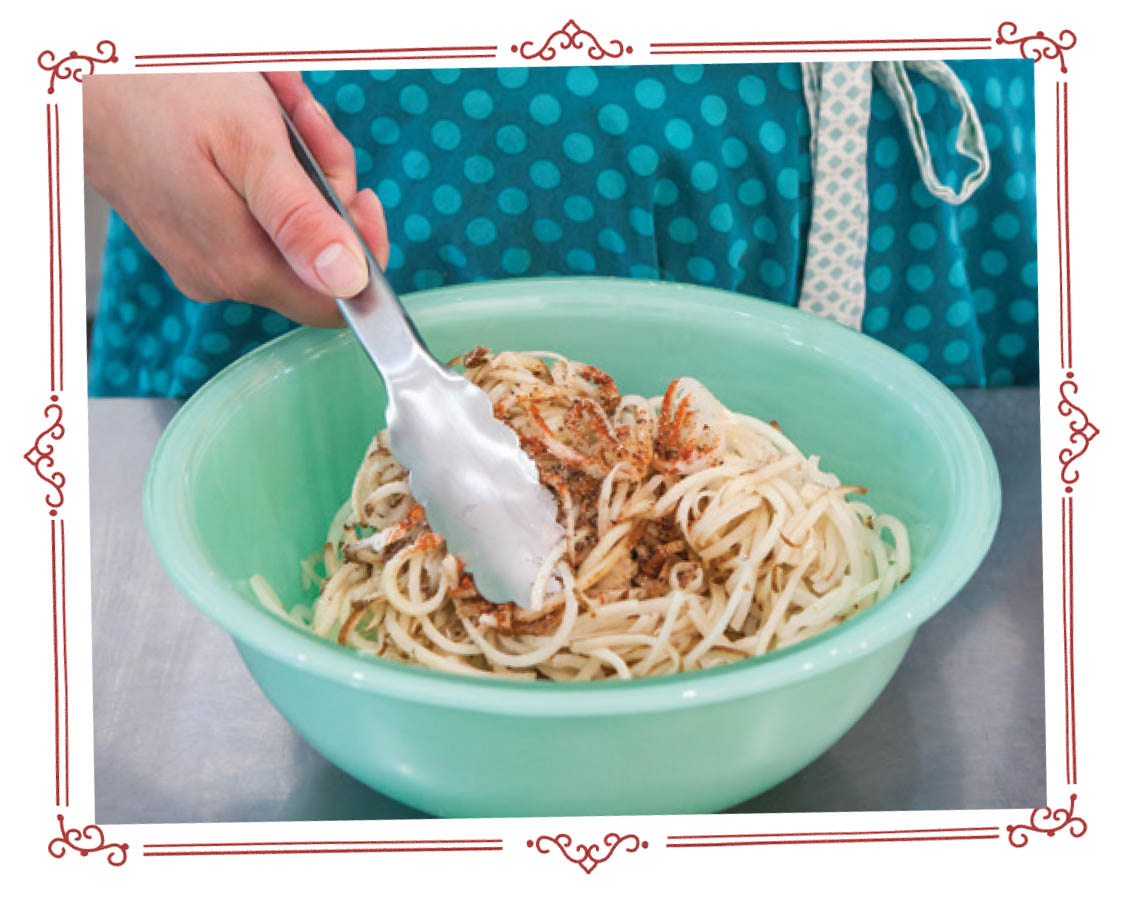
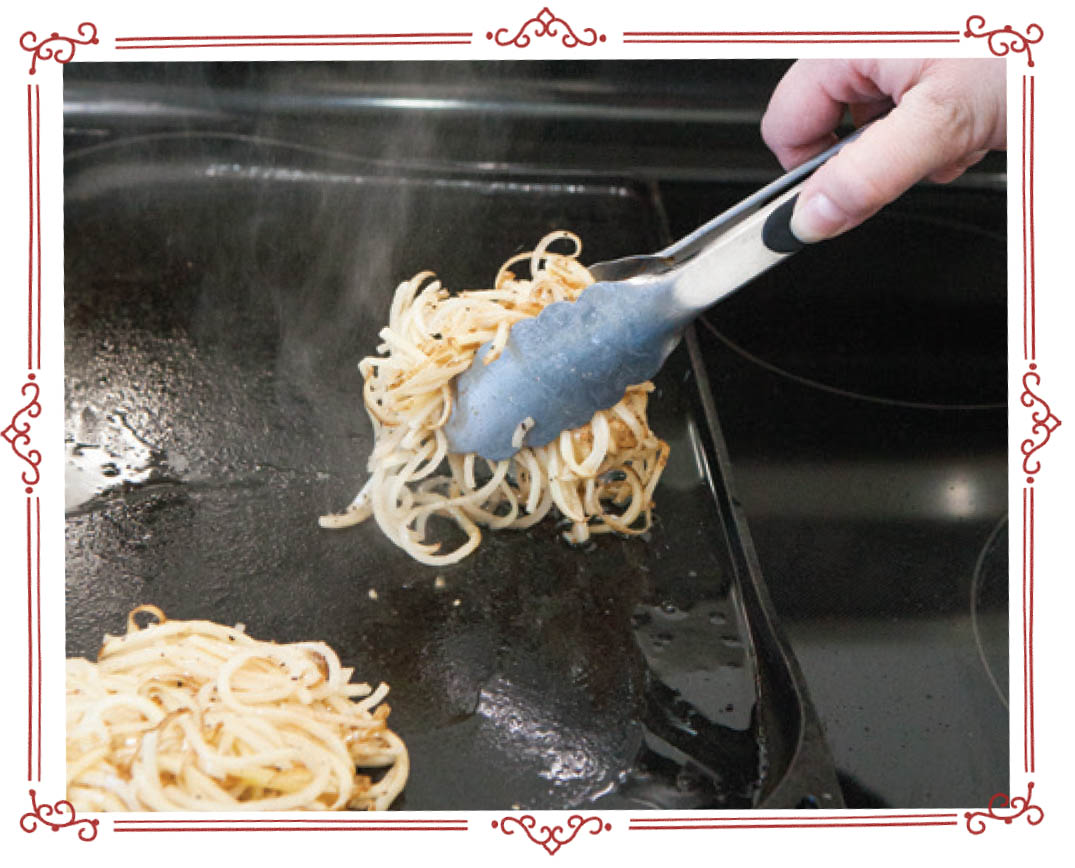
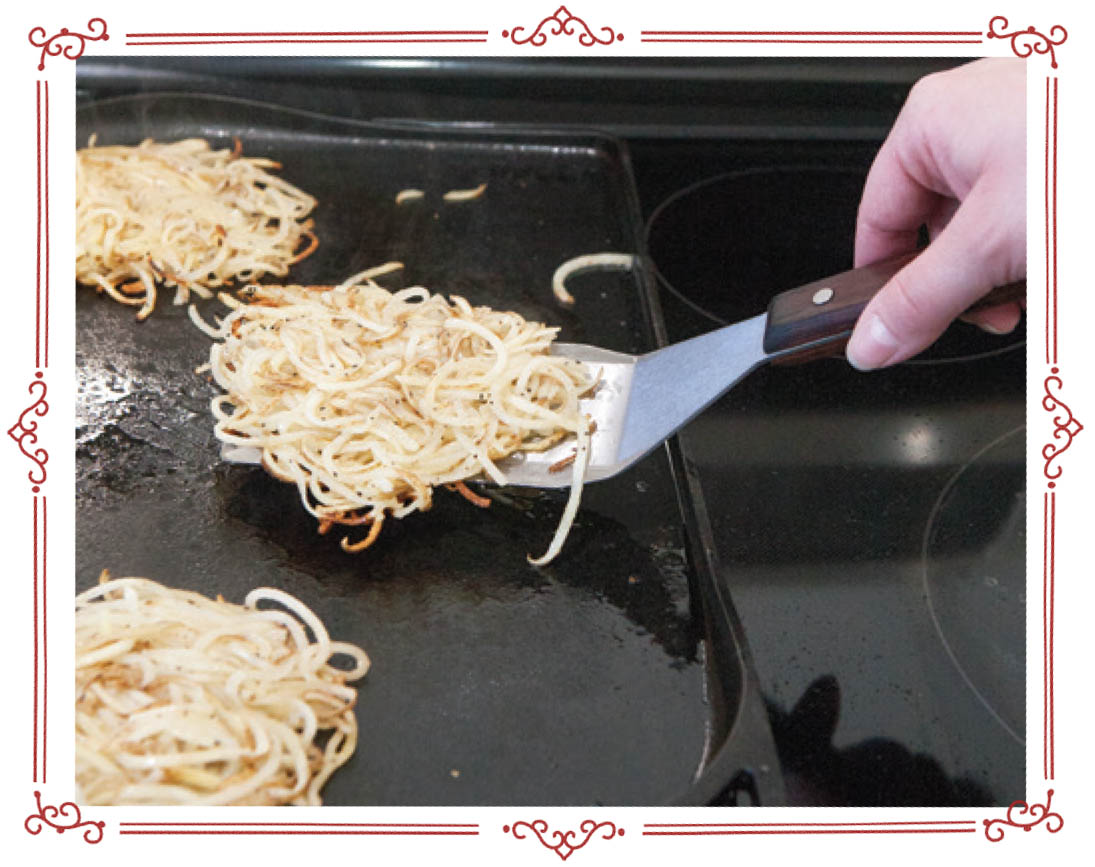
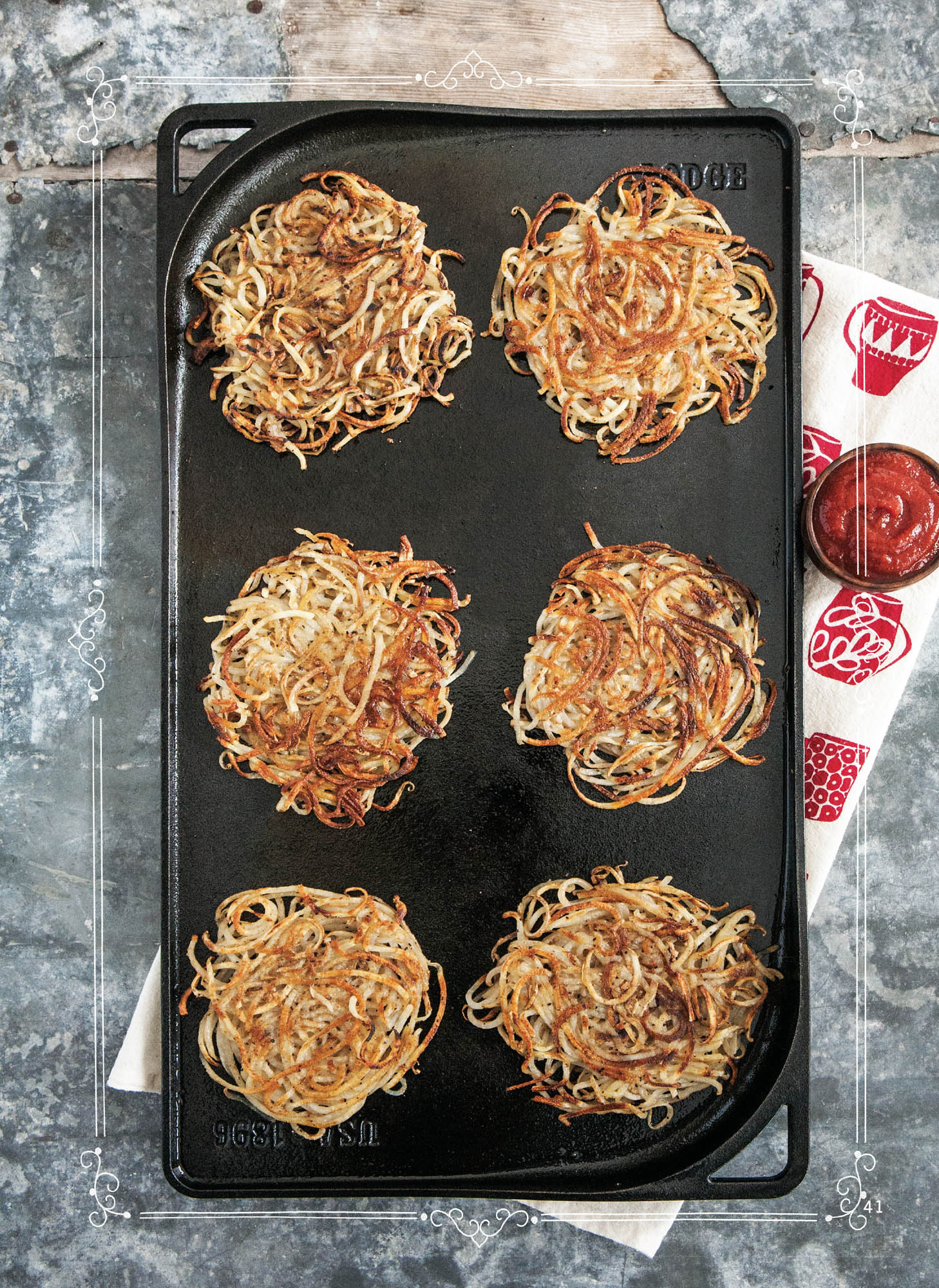
Sausage, Zucchini & Hash-Brown Biscuits
Sometimes, simplicity wins out, and nothing sounds more appetizing than a classic buttermilk biscuit sandwich. Just mix up a little sausage with zucchini, hash browns, and garlic; fry it up on your trusty cast-iron griddle; and top with cheese. A comforting classic is ready for the taking.
MAKES: 8 BISCUITS
Biscuits:
1 full batch Buttermilk Biscuits
Sausage Patties:
1 lb breakfast sausage
1 zucchini, shredded (about 3/4 cup)
4 ozs frozen hash browns, thawed (about 1 cup)
2 garlic cloves, peeled and minced (about 2 t)
1/4 t pepper
4 ozs Cheddar cheese, sliced
-
Prepare a full batch of Buttermilk Biscuits.
-
In a medium bowl, combine sausage, zucchini, hash browns, garlic, and pepper. Form into 8 patties.
-
Heat a cast-iron griddle over medium heat. Cook patties for 6–7 minutes, flip over, and cook for an additional 5 minutes. Top with cheese, and continue to cook until cheese is melted.
-
Serve sausage patties on Buttermilk Biscuits.

Cast-Iron Grill/Griddle
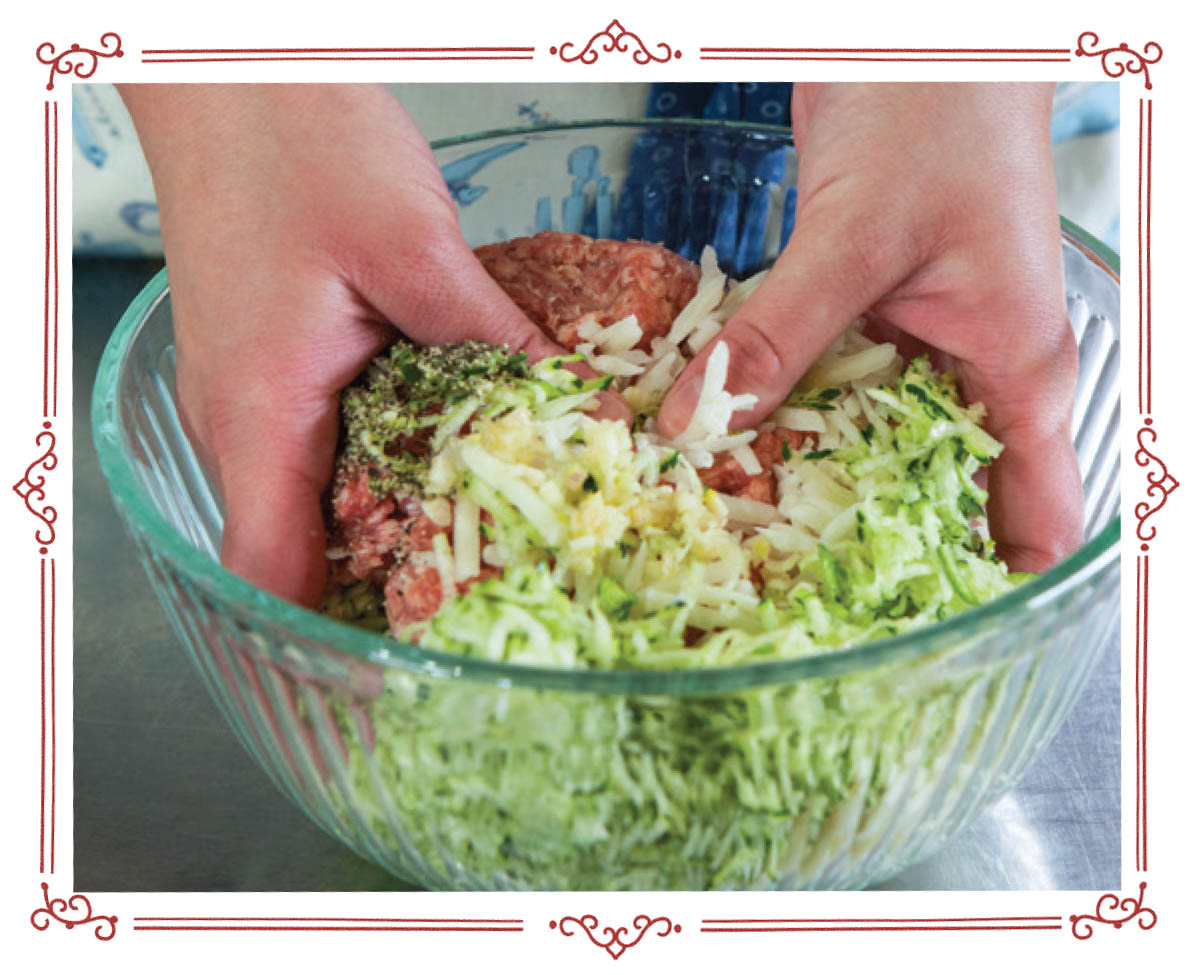
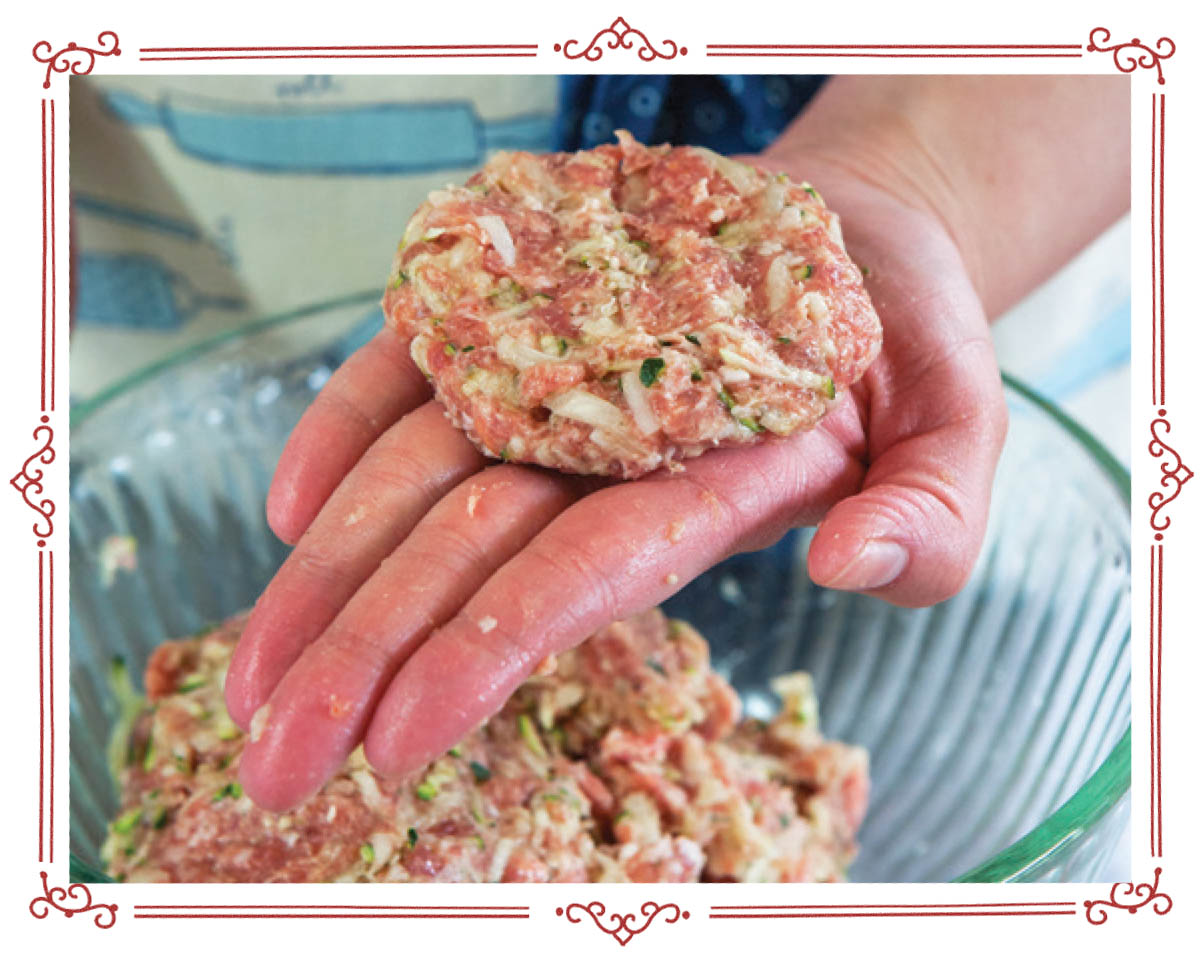
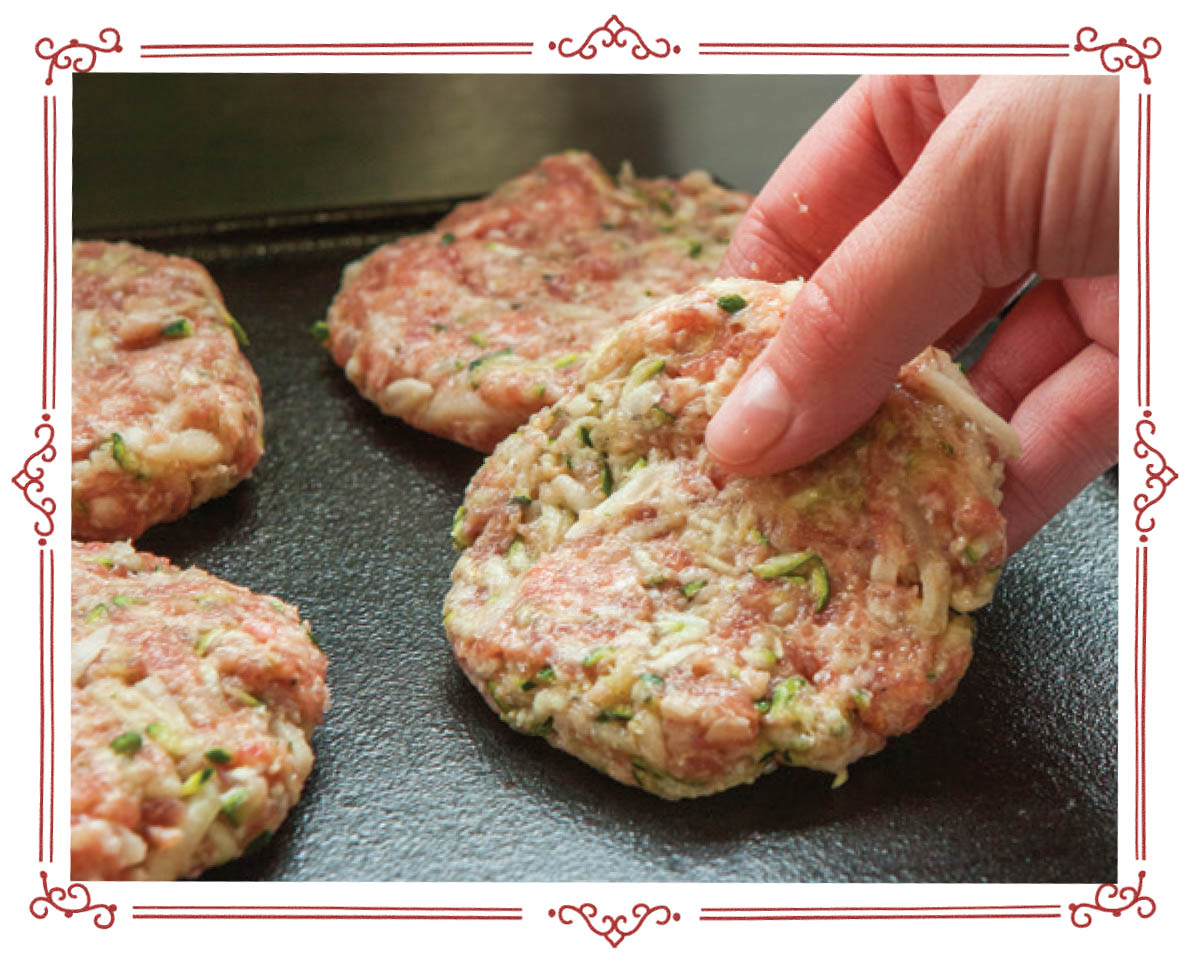
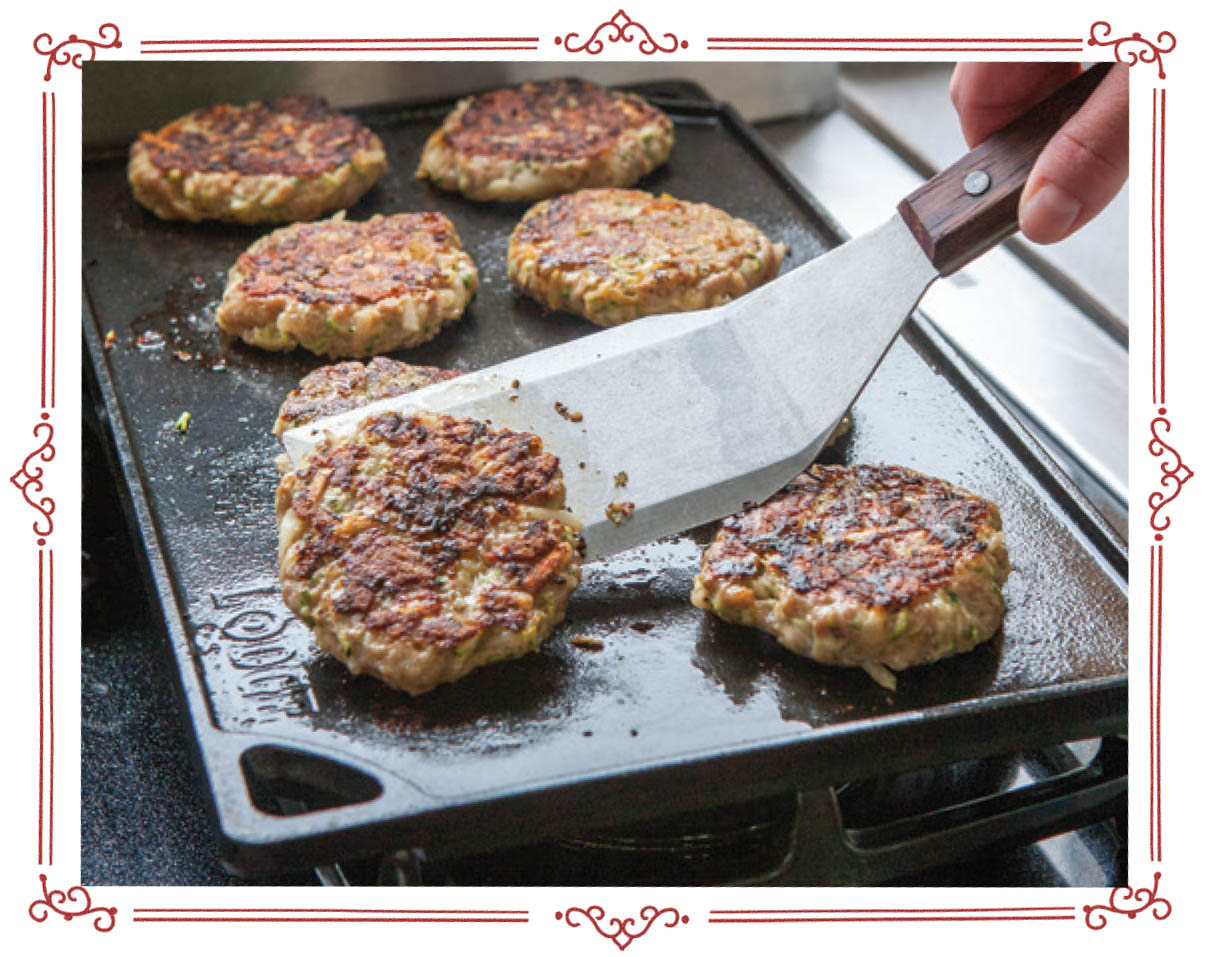
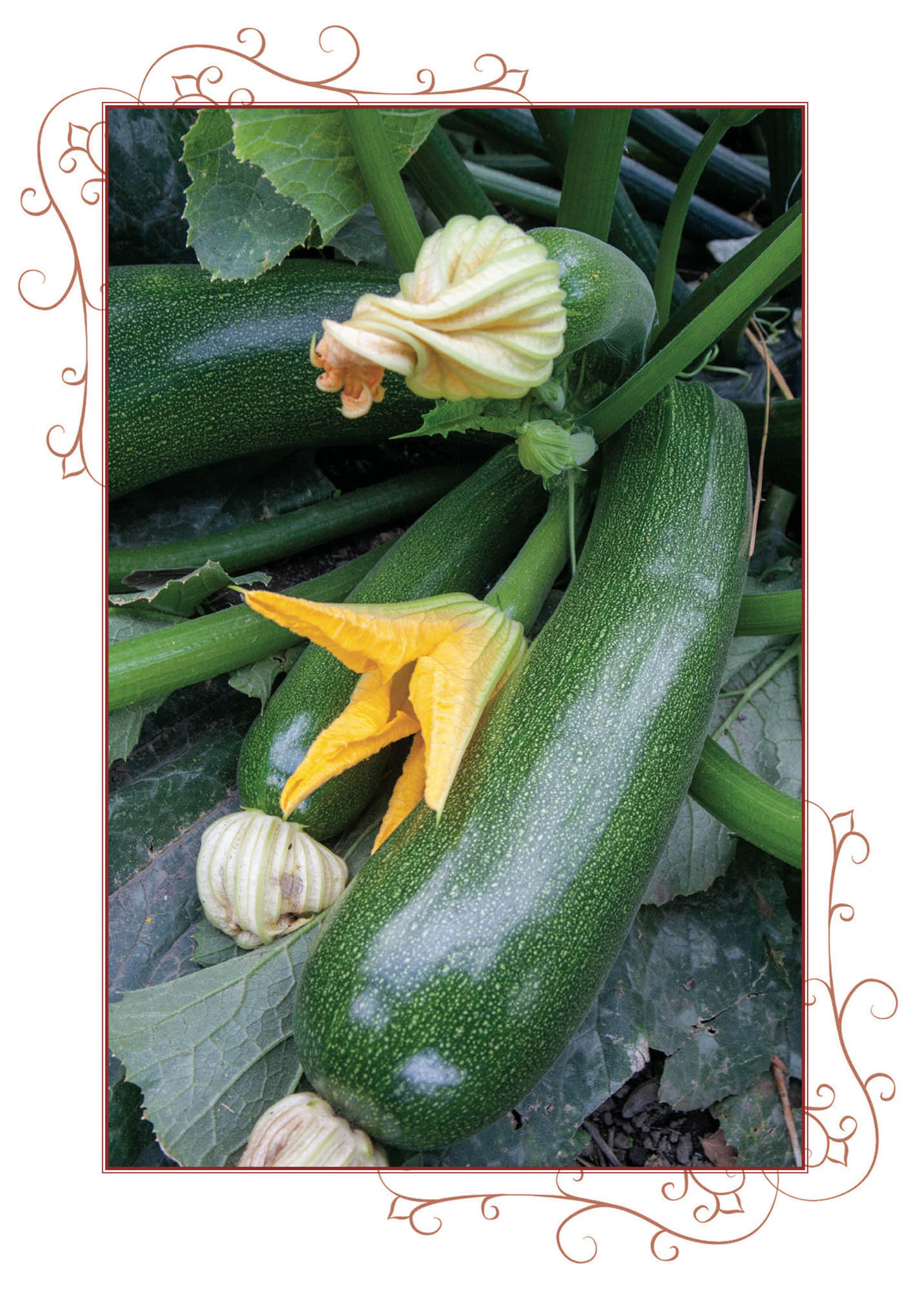
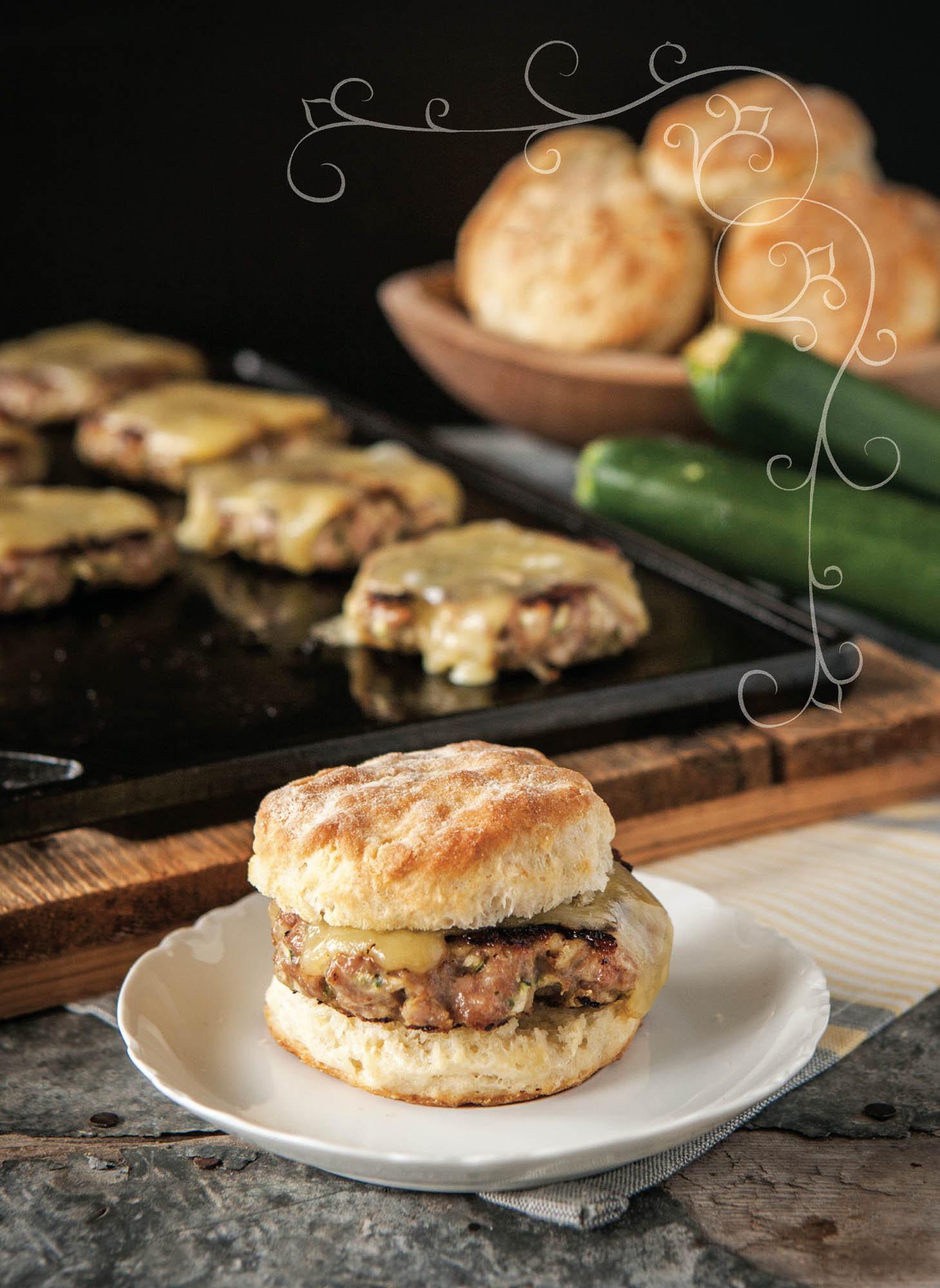
Savory Strata
Of all the dishes in my breakfast repertoire, this one is my go-to recipe. I’ve turned to it more times than I can count. The winning combination of sausage, tomatoes, feta, and green onions has never let me down.
MAKES: 4 SERVINGS
1 T butter
4 ozs crimini mushrooms, halved and sliced (about 1 cup)
3 cups 1” day-old baguette cubes
1/2 lb Italian sausage links, cooked, quartered, and sliced
4 ozs cherry tomatoes, quartered (about 3/4 cup)
3 green onions, sliced (about 1/2 cup), plus more for garnish
3 ozs crumbled feta cheese (about 1/3 cup)
3 eggs
1/3 cup milk
2 ozs Cheddar cheese, shredded (about 1/2 cup)
-
Generously butter a 10” square cast-iron baking pan.
-
Add butter to another medium skillet and sauté mushrooms over medium heat until tender (about 5 minutes). Add mushrooms to a medium bowl.
-
Add baguette cubes, sausage, tomatoes, green onions, and feta to bowl with mushrooms. Toss to combine. Add to prepared baking pan.
-
In a medium bowl, whisk eggs and milk together. Pour over bread mixture. Using a spatula, press ingredients down into liquid.
-
Cover with plastic wrap and refrigerate overnight.
-
Remove strata from refrigerator 30 minutes prior to baking. Preheat oven to 350°F.
-
Remove plastic wrap, cover with aluminum foil, and bake 45 minutes. Remove foil, top with Cheddar cheese, and bake an additional 15 minutes. If desired, garnish with green onions.
Alternatively, prepare single-serve stratas in four enameled cast-iron round mini cocottes: Generously butter cocottes and place on a large baking sheet. Evenly divide bread and egg mixtures between cocottes, cover with plastic wrap, and refrigerate overnight. Remove stratas from refrigerator 30 minutes prior to baking. Preheat oven to 350°F. Bake, uncovered, for 35 minutes. If desired, garnish with green onions.

10” Square Cast-Iron Baking Pan
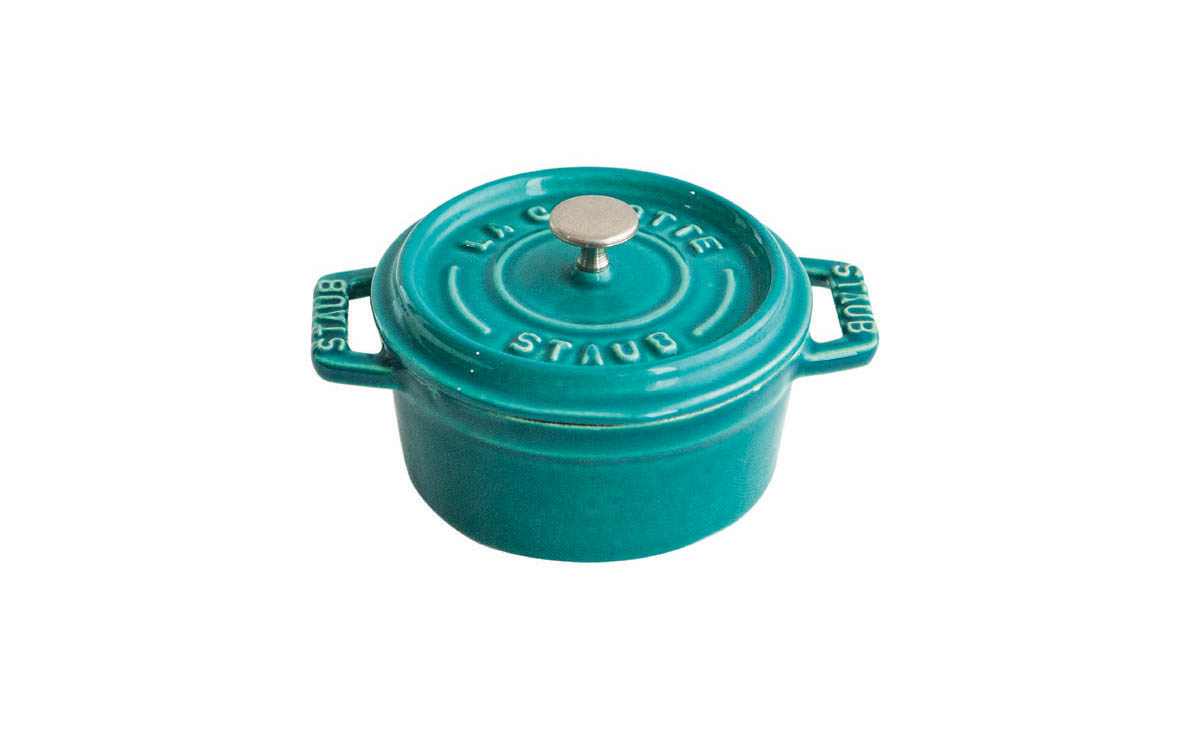
Optional: Enameled Cast-Iron Mini Round Cocotte
(Note: this recipe calls for 4 cocottes)
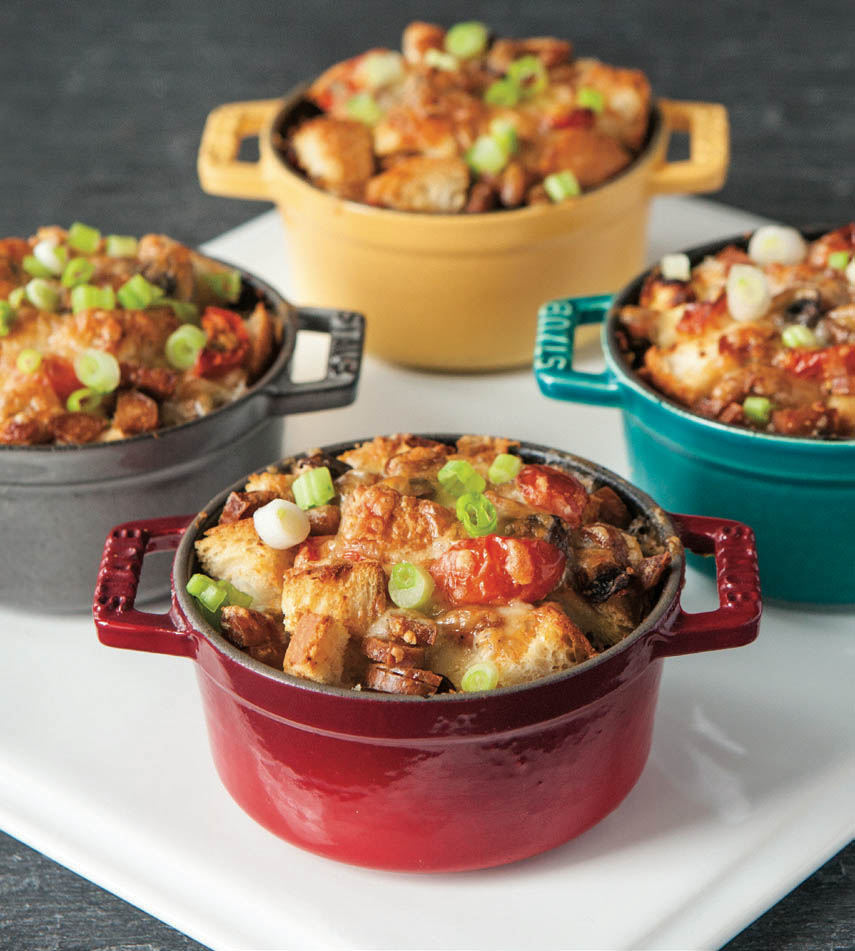

Sweet Strata
This dish always gets rave reviews from our B&B guests. It’s a regular on our breakfast menu because it’s something we can prep the night before and then pop into the oven the next morning. Just make sure you use good quality organic baguettes. The maple cream syrup has a unique flavor—a cross between something caramel-y and maple-y that’s as smooth as ice cream melting in your mouth.
MAKES: 4 SERVINGS
3 cups 1” day-old baguette cubes
2 ozs cream cheese (about 1/4 cup), cut into 1/2” cubes
1/4 cup fresh or thawed frozen blueberries
3 eggs
1/2 cup milk
1-1/2 T maple syrup
-
Generously butter a 10” square cast-iron baking pan.
-
In a medium bowl, combine baguette cubes, cream cheese, and blueberries; add to prepared baking pan.
-
In a small bowl, combine eggs, milk, and syrup. Pour over bread mixture. Using a spatula, press ingredients down into liquid.
-
Cover with plastic wrap and refrigerate overnight.
-
Remove strata from refrigerator 30 minutes prior to baking. Preheat oven to 350°F.
-
Remove plastic wrap, cover with aluminum foil, and bake for 35 minutes.
-
Remove foil and bake until top is golden brown and mixture is set in the center, about 15 minutes.
-
Serve topped with Maple Cream Syrup.
Alternatively, prepare single-serve stratas in four enameled cast-iron round mini cocottes: Generously butter cocottes and place on a large baking sheet. Evenly divide bread and egg mixtures between cocottes, cover with plastic wrap and refrigerate overnight. Remove stratas from refrigerator 30 minutes prior to baking. Preheat oven to 350°F. Bake, uncovered, for 25 minutes. Serve topped with Maple Cream Syrup.

10” Square Cast-Iron Baking Pan

Optional: Enameled Cast-Iron Mini Round Cocotte
(Note: this recipe calls for 4 cocottes)
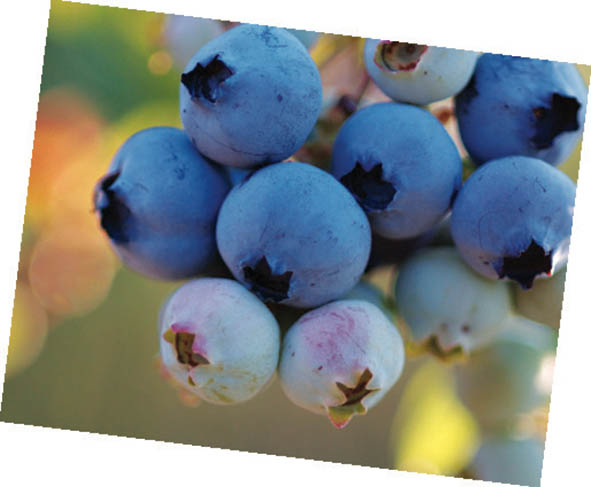
Maple Cream Syrup
MAKES: 4 SERVINGS
1/2 cup maple syrup
1 cup heavy cream
-
In a small saucepan, combine maple syrup and cream. Stir over medium heat until thickened, approximately 15 minutes. Drizzle over strata.
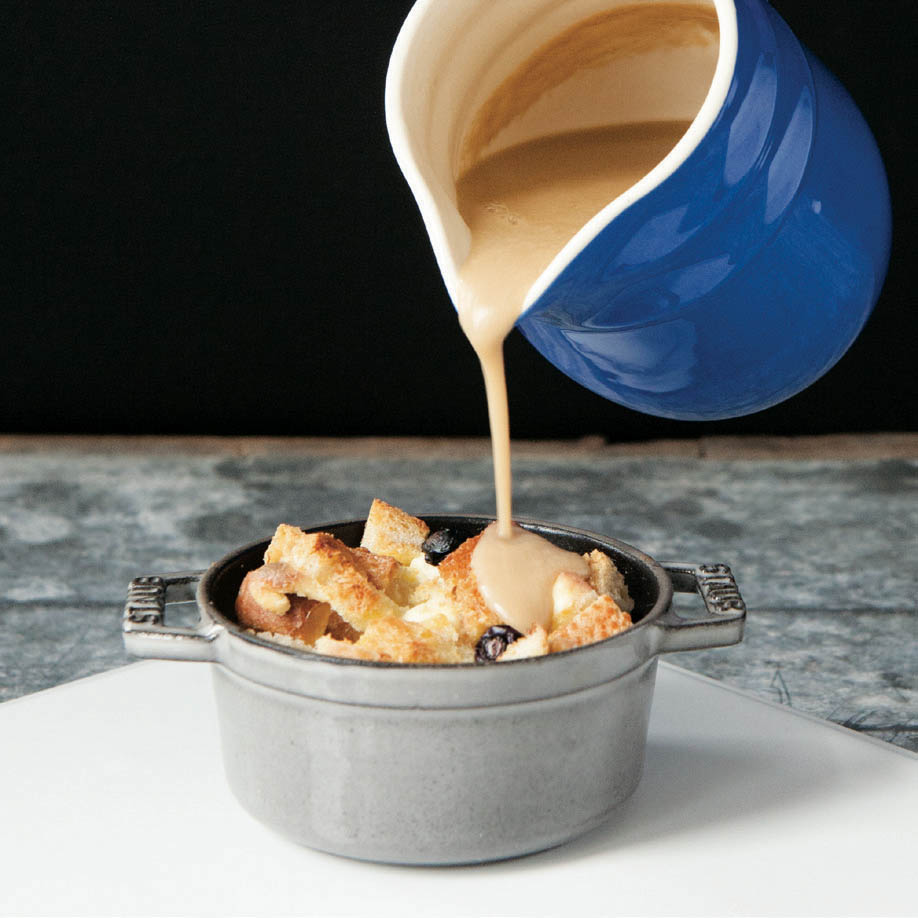
Roesti (Swiss Potato Cake)
Roesti is a simple dish with many variations. Usually, the potatoes need to be cooked at least one day beforehand. Sometimes they are shredded raw. In either case, they are pressed together in the skillet to make a compacted cake. Roesti must not be stirred while cooking; it must be able to form its signature golden-brown crust.
MAKES: 6 SERVINGS
2-1/2 lbs potatoes, unpeeled
4 t safflower oil, divided
2 t butter, divided
1 t salt
4 rosemary sprigs, de-stemmed and minced (about 2 t)
2 T milk
8 oz sliced or shredded cheese, such as Swiss, Emmentaler, Gruyère, raclette, Appenzeller, or Cheddar)
-
The day before, boil or bake potatoes until semi-tender. Cool completely and refrigerate.
-
The next day, peel potatoes, if desired, and shred.
-
Heat 2 t safflower oil and 1 t butter over medium heat in a 10-1/4” cast-iron skillet. Spread potatoes evenly in the skillet and sprinkle with salt and rosemary. Using a large spatula, firmly press into a round cake. Sprinkle with milk.
-
Reduce heat to medium-low when potatoes begin to sizzle. Cook slowly, periodically pressing down with spatula, approximately 20 minutes or until a nice brown crust forms. Loosen with spatula, place platter or flat pan over skillet, and quickly turn upside down. Add remaining 2 t safflower oil and 1 t butter to skillet. Slide Roesti back into skillet, cooked side up.
-
Top with cheese and cover until cheese is melted and bubbly and bottom of Roesti is also browned. Cut into wedges and serve.

10-1/4” Cast-Iron Skillet

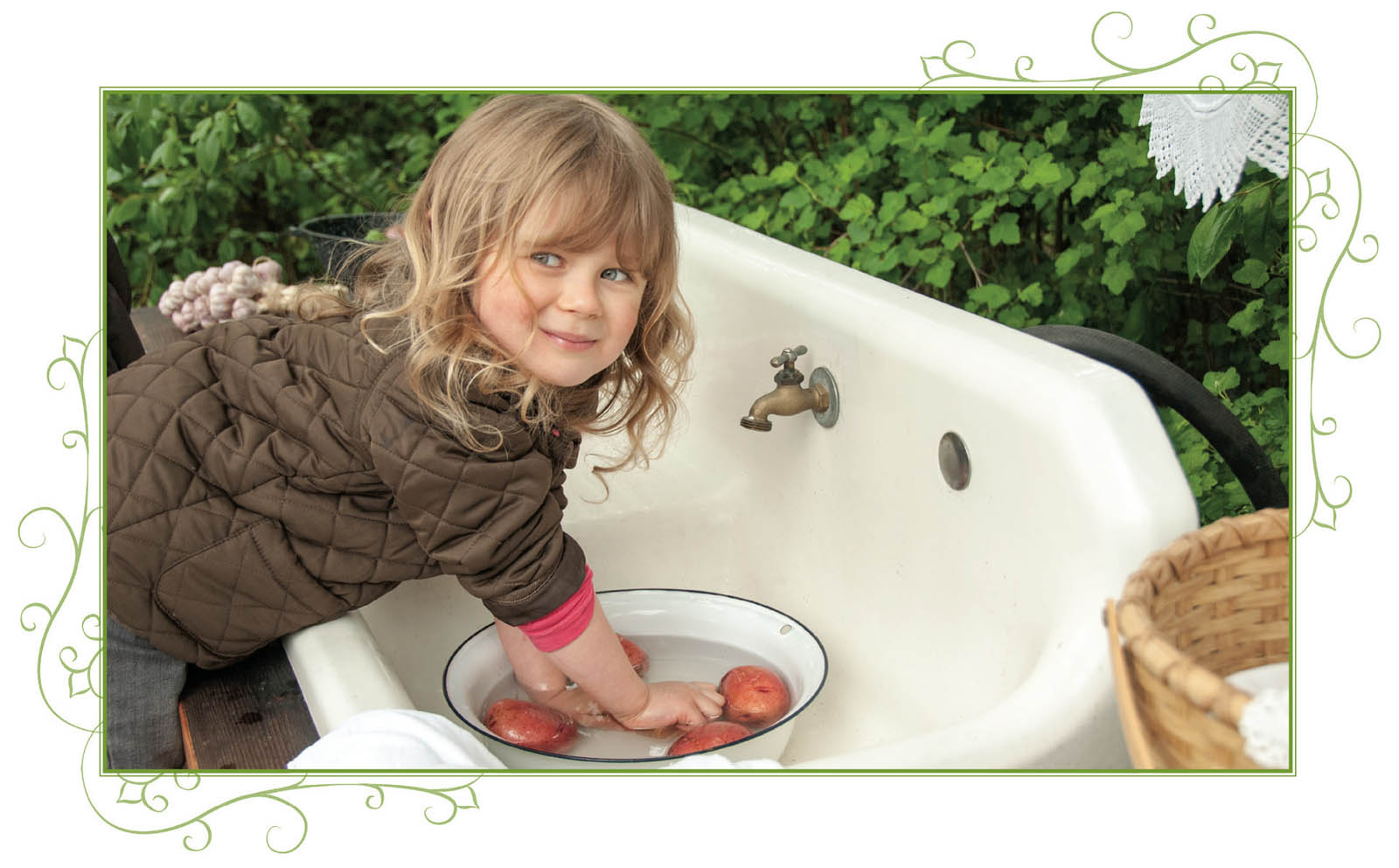
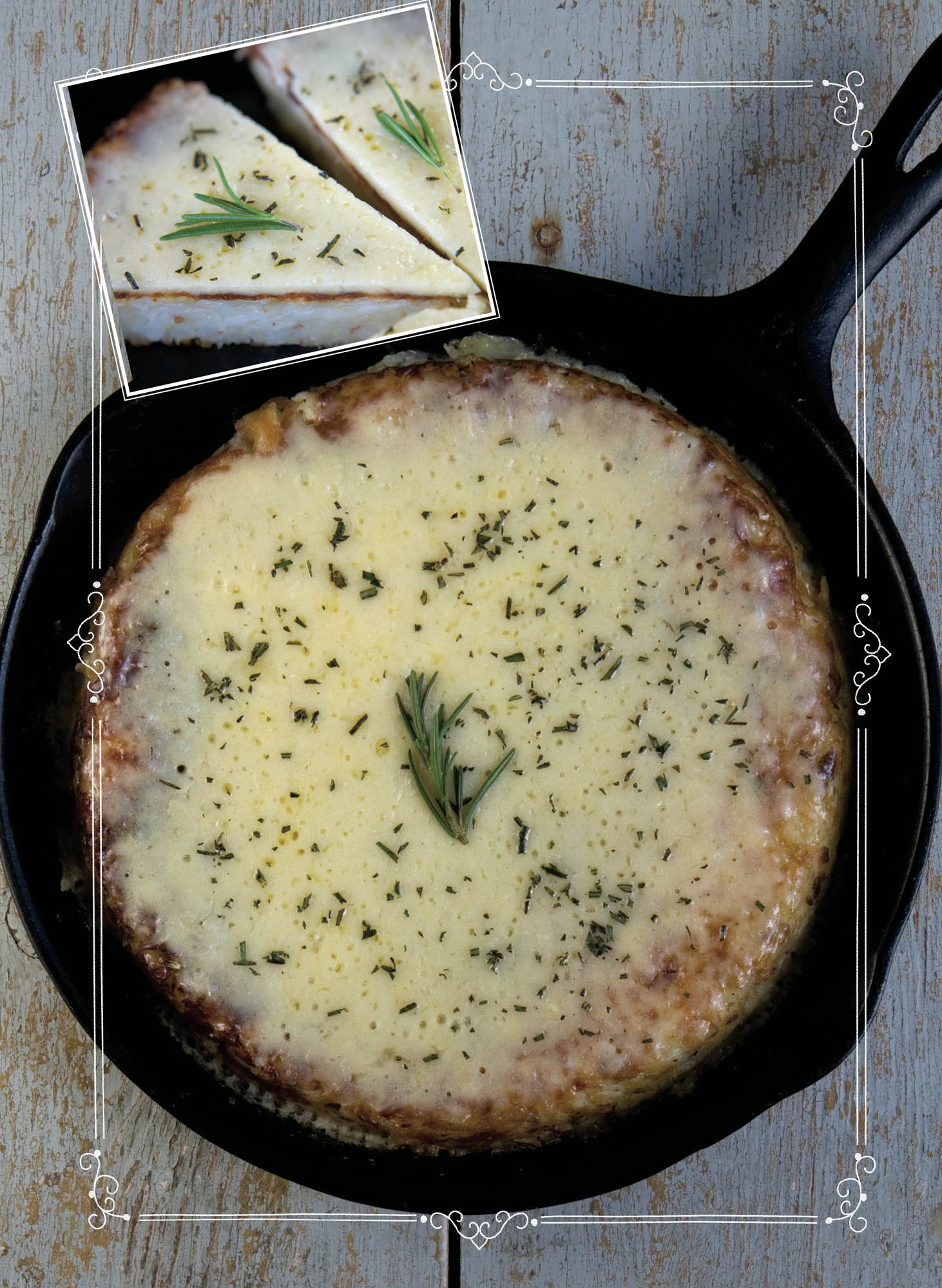
Giant Cinnamon Roll
Decadent, swoon-worthy, heavenly … oh, sorry, my mind trailed off while thinking about this cinnamon roll. I can list adjectives all day in an effort to describe this sweet treat, but I fear they won’t do it justice. After all, is there anything better than a huge, soft cinnamon roll smothered in frosting?
MAKES: 6 SERVINGS
Dough:
1-1/3 cups buttermilk
1 T honey
1 T butter, cut into pieces
1/2 t salt
1 package active dry yeast (about 2-1/4 t)
3 cups flour, plus more for dusting
Filling:
1/3 cup sugar
2 t cinnamon
1/4 t ground nutmeg
4 T butter, softened
Frosting:
3 T butter, softened
3 T heavy cream
1/4 t vanilla extract
1 cup powdered sugar
-
Make dough: In a small saucepan, combine buttermilk, honey, butter, and salt. Over medium-low heat, whisk mixture until honey is dissolved and butter begins to melt (mixture shouldn’t feel hot on the inside of your wrist). Remove from heat, whisk in yeast, and set aside.
-
Add flour to a stand mixer fitted with a dough hook. Make a depression in the center of the flour to receive the liquid; add buttermilk mixture to flour.
-
Mix until dough forms, and continue to mix until dough is smooth and pliable (5–8 minutes).
-
Lightly butter a medium bowl. Dust hands and dough with flour and shape into a ball. Place in prepared bowl, cover with plastic wrap, and let rise in a warm place for 1-1/2 hours, or until doubled in bulk.
-
Prepare filling: In a small bowl, combine sugar, cinnamon, and nutmeg; set aside.
-
Preheat oven to 350°F. Generously butter a 10.” cast-iron skillet.
-
Deflate dough. On a lightly floured surface, roll dough into a 12” x 15” rectangle. Spread 4 T softened butter over dough and cover with filling mixture.
-
From the 15” side, cut the dough into ten 11/2” x 12” strips. Roll one strip up, jelly-roll style, into a cinnamon roll. Place in the center of the prepared skillet. Wrap remaining strips, one at a time, around center cinnamon roll to form one large cinnamon roll. Cover with plastic wrap and let rise in a warm place for 30 minutes.
-
After 30 minutes, remove plastic wrap and bake cinnamon roll for 25–30 minutes, or until internal temperature reaches 200–205°F.
-
While cinnamon roll is baking, prepare frosting: In a medium bowl, combine butter, cream, and vanilla. Add about half of the powdered sugar and blend until smooth. Add remaining powdered sugar and blend until smooth and creamy.
-
After cinnamon roll has finished baking, remove from oven, cool for 30 minutes, spread frosting over top, and serve.

10-1/4” Cast-Iron Skillet
